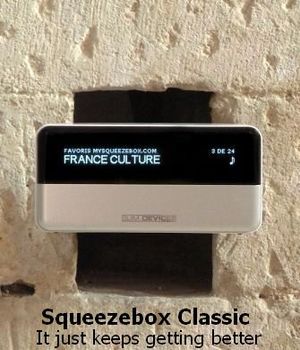
Slim Devices,
la musique autrement !
Rejoignez l'Association des Amis de Saint-Hilaire ! - infos -
Afficher plein écran - infos - Raccourci CTRL et F - infos - Consultation PDF - infos -
Comme tout "work in progress", ce document demande à être amélioré et corrigé… et nous avons besoin de vous pour l'enrichir! Alors, n’hésitez pas à nous contacter en écrivant à hilaire84@orange.fr
► Version PDF - 197 pages - ici -
Table des matières - ici -
2001 - Création de Slim Devices par Sean Adams
Slim Devices, Inc. 958, San Leandro Avenue, suite 400, Mountain View, CA 94043, is a Silicon Valley startup with hot products for audiophiles. It's also a next-generation open organization where customers imagine and design the products. Is this the company of the future?

Sean Adams fondateur de Slim Devices.
2006.02.08 "You have to love this sweet, satisfying machine," wrote David Pogue in his New York Times review of the Squeezebox™. The sweet machine in question is a $300 device that lets audiophiles take digital music from their computer hard drives or from Internet-radio streams, and play it with impressive clarity on high-end speakers in their living rooms. "Its creators have sweated so many details, you want to hand them a towel."
This was the prototype for the SliMP3, released in 2001 by Sean Adams:

Early Days.
Ah, but who actually did that sweating? Not just the handful of engineers on the payroll at Slim Devices, the startup that makes the Squeezebox™. The player, which has sold an impressive 50.000 units, is largely the brainchild of its customers around the world, who have done much of the vital engineering and design work--for free.
They've been motivated by their passions for great audio, for cool products, for the art of engineering and also by the satisfaction of being admired and relied on by a global community of their peers.
We know about open-source software and Web services such as Linux, the Mozilla Web browser, and Wikipedia, of course. But Sean Adams, the 27-year-old college dropout who started Slim in his Silicon Valley garage, bet that the same ethos of knowledge sharing and community could extend to a manufactured physical object, one being sold--gasp! for profit.

True, it's a conclusion he came to by accident. Adams had a more conventional company in mind when he was making the rounds for venture capital. He just happened to be looking for funding during the Valley's particularly inauspicious time of late 2001. "Sean wanted Slim Devices to be open source because he didn't have the money to build a company in the usual way," says Patrick Cosson, Slim's vice president of sales and marketing. "It wasn't a political position. It was out of necessity."
And you know what they say about necessity. Slim Devices will bring in around $10 million in revenue this year. Its fans include music stars Herbie Hancock and Alanis Morissette. And its latest product, released last September, the higher-end $2.000 Transporter™, has reaped three times the expected orders.
Slim Devices is still small, of course, and young. But it offers a glimpse of how many companies may come to function in the future: as ecosystems that depend on the active participation of broad networks of contributors. "Everywhere you find innovation today, a community is involved," says Patricia Seybold, author of Outside Innovation: How Your Customers Will Co-Design Your Company's Future (Collins, October 2006).
In this world, running a company is not about brilliance or command, but about attracting and orchestrating the work of talented and passionate outsiders--people who know more than you do, have better ideas, and maybe even care more about your product than you do. As Slim's five-year history shows, there's still an important role for the company and its leaders, but it sure isn't what people have been learning in business school for decades.
People around the world have been contributing to Slim Devices free of charge for all sorts of reasons. Some do it to showcase their skills in the hope of attracting a job offer. Some do it for the challenge. But much of it comes down to this: We want things our way. "Initially, I really got involved because the product didn't do quite what I wanted," says Adrian Smith, who's employed as a network architect for a large telco in Britain. "Instead of just complaining, [Slim] allowed me to roll up my sleeves and try to improve it."
Hard-core audio enthusiasts like Smith, the sort Adams calls "people who will do anything in the pursuit of sound," are the backbone of the Slim Devices community. But what keeps these avid listeners engaged, in fact, is the chance to be heard. Felix Mueller was a software engineer in San Jose, California, a few miles from Slim's headquarters in Mountain View, when he started writing new features for its players.
The startup's bosses treated him with deference when he dropped by its vintage 1950s Silicon Valley building (which originally belonged to Fairchild Semiconductor, the legendary company that invented the computer chip). "When I first met Sean," Mueller recalls, he greeted me with, You must be the famous Felix.
Mueller remained a key member of Slim's community even after he moved to Switzerland. Smith says Slim's executives have earned his trust by relying on his software and "treating me as the expert on how it works."
Slim Devices has depended on its community of enthusiasts to both suggest and create the numerous add-on features that give its products their full richness. But if that's all there was to it, Slim would be merely a customer-centric organization using open-source software development in much the same way giants like IBM do.
Adams's true leap of faith is to let his company rely on nonemployees for much of its most crucial engineering. A particularly vexing challenge for any high-end audio product, for example, is minimizing the amount of power it uses, because electricity creates noise that detracts from the purity of the signal.
And Andrew L. Weekes, the engineer who masterminded Slim Devices' approach to minimizing power, isn't an employee. He works for a company that supplies the British military with target drones, unmanned aircraft that they can use for practice.
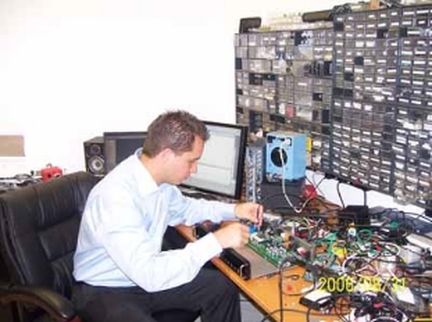
Montage d'un Transporter Slim Devices.
Still, he's one of a handful of the community's members who have full access to the product's inner sanctum firmware, the detailed hardware specs and software that determine how it works. Vendors told us, You guys are insane, Adams recalls. They said, What are you doing? You need to protect intellectual property. You need patents. Instead, Slim's executives decided to put their trust in the contributors who have proven their talent and commitment to the endeavor for several years.
It's a risk, to be sure. But cultivating customer-creators of all stripes gives Slim access to talent that it otherwise wouldn't have. There are a lot of bored telecom engineers who would move to California if they didn't have families or passport problems, says Cosson. Half our contributors are abroad--in Canada, the UK, Switzerland, Germany--and this is their way of connecting to Silicon Valley.
Leading a network of outside contributors--if it can be called "leading--takes some getting used to, says Dean Blackketter, Slim's chief technology officer. He knows this relationship from both sides: Blackketter was Slim's first customer-creator. A seasoned software engineer who had worked at Apple, Microsoft, and WebTV, he bought Adams's first product, the SliMP3 (serial No. 3), out of curiosity.
He saw that the software code that ran the device was posted as open source on the company's Web site. He began making improvements and additions to the code and sending them to Adams, who responded by sending a free SliMP3 to Blackketter in San Francisco (now a common gift to contributors), and then another, and then some stock in the company. In 2002, Blackketter came aboard as the company's second employee.
Now he presides over the community, a task that, among other things, requires a talent for suppressing his own ego. The hardest part is giving up control, he says. "Do I make decisions myself about changing the product, or do I open it up? Every single time I've opened it up, it's paid off. A couple of times, I've been this close to doing it my way, but they--the people in the community--changed my mind. Their hearing is better than mine, their ideas are better than mine. They're doing it because they love it.
At some point, though, the community has to be saved from itself, and that's when Slim's managers step in. One customer wrote a piece of software that enabled Slim's boxes to connect to Rhapsody, Real Networks online music service. He did so by breaking the code that protected Real's data transmission over the Net. Uh-oh.
The author of the Real plug-in lived just a few blocks from Blackketter in San Francisco. Blackketter went over to his house and said, That's a really good hack, man, but told him it wasn't legal. Only mildly daunted, the hacker put the plug-in on his own Web site rather than Slim's.
Then, sure enough, an email came from Real Networks asking him to take down the posting--and, in classic Silicon Valley fashion, to visit Real the following week for a job interview. Slim managed to hire him first, then eventually worked out a legal relationship with Real and incorporated the plug-in into its players. "You can't be heavy-handed and kill the creativity, Cosson says. But you have to manage the chaos and resolve disputes.
As the company has grown, Slim's leaders have learned exactly what the founders of Mozilla Web browser discovered: If you're going to have a grown-up company, with a competitive product in the marketplace, you need a staff of paid full-time employees. They make it possible to meet deadlines and run reliably. Some things have to be handled by staff--such as quality control for the physical product.
And, of course, you can get paid staffers to do what the volunteers pass up or abandon midway. "We think of our development community as this big game room, this big playpen, and we're watching, says Cosson. If the community can elevate an idea and get it over the hump, that's great. But sometimes we have to rewrite software to finish it. Slim now employs 26 people.
The company's open-source model will increasingly be tested as it grows and matures. Already, Slim's top contributors detect changes in the tenor of the online forums that have been so effective. The community has grown wildly in the last couple of years, says Kevin Deane-Freeman, who makes his living as a hardware designer for a printer manufacturer near Vancouver, British Columbia.
For several years, he has often spent his lunch break working on software for Slim. It's no longer possible to keep up with it 100 %, nor to make everyone happy. That's a big thing when much of why you do it is to see others happy with what you have provided.
With Slim's full-time staff increasing, there's also a danger that the intellectual center of gravity will shift to the inside. In the past, Blackketter says, the vast majority of our technical discussions, inside and out, took place on Slim's online forums, where you wouldn't be able to tell who is an employee and who isn't. Now, Adrian Smith warns, as the employee team has grown, there are more conversations going on in private.
How Slim manages this phase will determine whether it can be more than just a startup that briefly thrived on the open-source model. "With the open organization, the real question is: Can it scale? says Ram Charan, the prominent management consultant. Open-source software projects often reach a forking point where the community splinters and factions go their different ways.
And while the open-source approach offers a nearly limitless resource potential, that same potential can introduce an unpredictability, says Deane-Freeman, who signs his postings not a Slim Devices employee because of confusion that arose from his frequent and authoritative contributions. In a larger structure, and especially with a publicly traded company, predictability plays a strong role.
Indeed, Slim's unconventional, open style may prove challenging for Logitech International, which announced in October that it had acquired the company for $20 million. Logitech promised that Slim would remain autonomous, enthusing over "one of [its] key assets, a committed community of developers. But you still have to wonder whether Logitech® merely covets Slim Devices for its cool audio technology--and whether, ultimately, it will kill off the more valuable invention.
Ears Wide Open
December 1, 2006
Developer discussion of Squeezebox
Developer discussion of Squeezebox™, SLIMP3 and SlimServer from Slim Devices, Inc. (août 2001 à décembre 2010)
► Developer discussion - here -
La gamme Slim Devices
• SLIMP3™ (2001).
• Squeezebox™ v1 (novembre 2003).
• Squeezebox™ v2 (avril 2005).
• Squeezebox™ Classic (SB3) (novembre 2005).
• Transporter™ (septembre 2006).
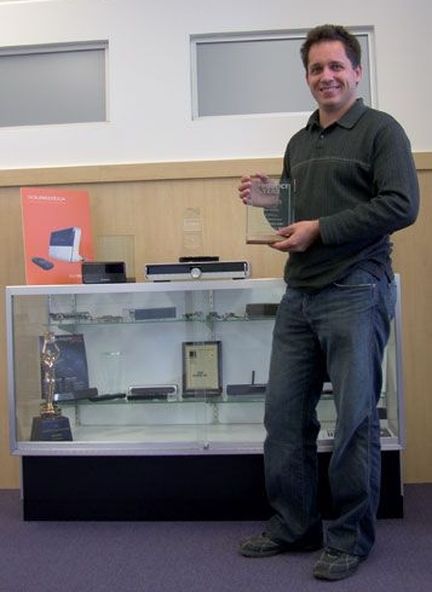
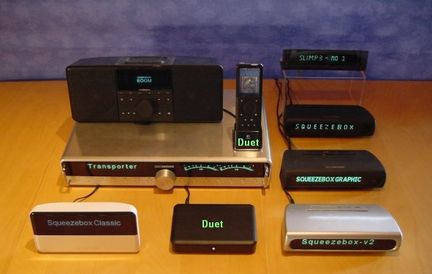
Nota : Boom™ et Duet™ sont des produits Logitech.
2001 - Le SLIMP3

Here is a shot of the front of the unit.
Publications
Homecinema-fr.com
À l'époque où le format MP3 s'est déjà bien imposé, et que des baladeurs MP3 évolués commencent à apparaître, Sean Adams et Dean Blackletter conçoivent, et lancent la production depuis leur garage, d'un appareil qui semble aller à contre-courant des produits offerts par la concurrence: le SLIMP3
À la différence de la plupart des autres produits du marché, cette platine est dépourvue de mémoire de masse propre, et récupère directement par streaming (diffusion de contenus) les fichiers MP3 là où ils se trouvent: sur l'ordinateur.
Le but avoué des concepteurs est de permettre aux utilisateurs du SLIMP3 de profiter, sur leur installation hi-fi, de toute leur collection de fichiers MP3, et pas seulement d'un nombre limité d'entre eux, loin des nuisances sonores associées à l'ordinateur, en pilotant l'appareil grâce à une télécommande.
Le design est minimaliste, et la connectique est réduite à sa plus simple expression:
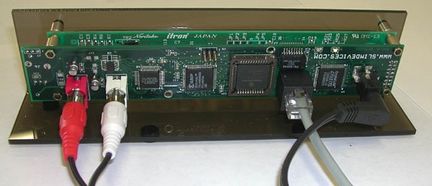

Views of the back.
Plutôt que d'intégrer dans la platine elle-même toute l'intelligence requise pour assurer les fonctions de navigation et de lecture, les concepteurs décident de déléguer un maximum de traitements à un programme serveur de leur conception: le "SLIMP3 Server".
Ce programme serveur, écrit en langage Perl, est publié dès l'origine sous licence libre GPL, et les utilisateurs du SLIMP3 - essentiellement un public technophile - sont invités à le faire évoluer à leur gré.
Dans la première version du logiciel serveur, seule la navigation par arborescence de fichiers était disponible, le logiciel ne reconnaissait pas les tags ID3 (un choix de Sean Adams, qui considérait que trop peu de fichiers MP3 étaient correctement taggués), et la seule interface utilisateur disponible était celle de la platine elle-même.

The SLIMP3 Server Web. The server controls.
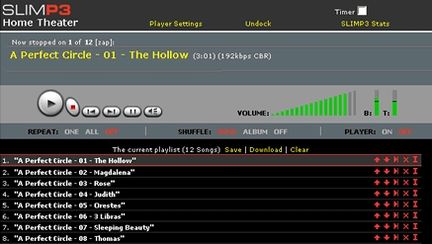
The SLIMP3 Server Web. The player controls.
Mais, en raison de l'ouverture du code source du logiciel serveur, de très nombreuses fonctionnalités seront ajoutées au logiciel serveur pendant la commercialisation du SLIMP3: interface utilisateur Web, support des tags ID3, transcodage d'autres formats audio afin de permettre à la platine de les lire, synchronisation de platines, etc...
Du fait des très fréquentes évolutions du logiciel, celui-ci n'a jamais été livré avec la platine: l'utilisateur était invité à aller télécharger la dernière version.
C'est une caractéristique que l'on retrouvera par la suite avec toute la gamme des platines Squeezebox™.
Durant sa commercialisation, le SLIMP3 a connu quelques mises à jour mineures, comme le changement de la teinte du plexiglas ou l'ajout d'un carter de protection:
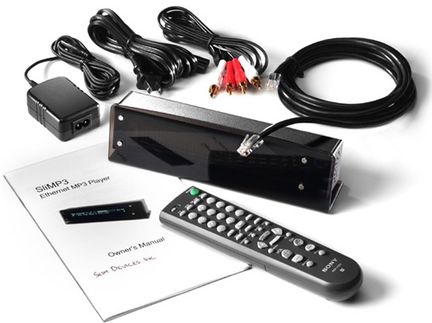


ONLamp.com
Nat Torkington
Like almost everybody I know, I've been dutifully ripping my CDs to MP3 files over the last few years. I have a server running FreeBSD that delivers the files through Apache MP3 to any machine on our home network, and now my wife and I can listen to our music on our computers. So why did I balk when my wife suggested putting the physical CDs in deep storage?
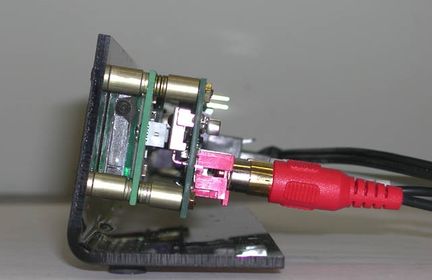
Because of our stereo. Thirty gigabytes of MP3 files are fine until you actually want to listen to them in the living room. I tried a homebrew solution a year or two ago, connecting my FreeBSD machine's sound card output to the stereo's input with a very long set of cables, but none of the FreeBSD console MP3 players I could find would successfully play the MP3 files we had ripped with RealJukebox on Windows.
Frustration be gone! In the last year several devices have entered the market that let you play MP3s through your stereo. The latest of these is the SLIMP3 from Slim Devices ($250). Small (8.5 x 2.5 x 2) and elegantly black, it has but three connectors: power, Ethernet, and RCA cables to your stereo. To succeed in the consumer audio space, an MP3 appliance has to exhibit this kind of simplicity and elegance in every aspect of its design.

Here's a view of the back.
Physical installation of the unit was trivial. The hardest part was finding an ethernet cable long enough to reach from the nearest hub across the living room to the back of the entertainment center. The SLIMP3 FAQ specifically addresses dispensing with the cables and going for wireless; but until it becomes possible to support 802.11b and keep down the cost, the SLIMP3 will continue to be cable-bound.
The hardware component of the SLIMP3 is only half the picture, though. The SLIMP3 speaks its own (open sourced--there's even a SourceForge project for it) protocol with a server to fetch playlists, streams, track information, etc. So you need to run a server somewhere--servers are provided for Linux, Mac OS X, Windows, and (to my exquisite delight) there's even a Perl server. I installed the Perl server in minutes on my FreeBSD box.
Because of the various ways people set up their networks, configuring the SLIMP3 wasn't as simple as one button push, but it was close. The option that uses DHCP and automatically discovers SLIMP3 servers worked perfectly for me.
The SLIMP3 comes with a Sony generic remote, which you must first program (through five or six button presses) to be a SLIMP3 remote. This felt out of place in an otherwise seamless install--the TV, tuner, TiVo, and DVD player I have in the entertainment center all came with remotes that worked out of the box. That said, the instructions in the booklet were easy to follow and in no time I was up and running.
The screen of the SLIMP3 is one of the first things you notice the crisp 40x2 fluorescent display is very bright and easy to read from a distance. Blind codgers like me will appreciate the option to supersize the text, making it very easy to read from across the living room. When powered off, the SLIMP3 displays the time, which turned out to be surprisingly useful in our house. Thanks to NTP, which keeps my server's time accurate, we now have a very visible authoritative source of time around the house.
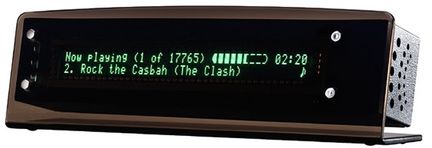
Here's a view of the front.
What's really cool about the SLIMP3, though, is that the server is optionally controllable through its own Web server. From your browser you can change what's playing, pause, change the display, change the volume, and otherwise tweak the SLIMP3. That may not sound like much, but if the living room is filled with three year olds who are clamoring for Queen's Greatest Hits, it's sheer pleasure to be able to queue "Another One Bites the Dust" from one's office rather than have to descend into a veritable hell-hole of toddler trouble. Not that this has necessarily happened to me.
Although the default configuration has games disabled, the server can offer games via your SLIMP3. Tetris and a horizontal shooter are the two standard games, but other people have extended the Perl server to add their own features. Someone's even written a BBC news ticker. This opens itself up to all kinds of fun: subliminal messages, an interface to FestVox so it can read the headlines as well as display them, a biff-style mail alert, visual load averages for your machines (via ruptime?), fortunes, Choose Your Path adventure games, and much much more.
The Mac OS X SLIMP3 server installed trivially, read my iTunes databases, and even noticed when I updated my iTunes database. Because the SLIMP3 server can translate streaming MP3 formats like Shoutcast, Icecast, and Live365, I was able to drag the KCRW public radio simulcast to my Library and within a few seconds it was available on the SLIMP3 player. I don't think anything has impressed me with the SLIMP3 as much as this. Now if only my local NPR station offered an MP3 stream instead of RealAudio and Windows Media!
From the SLIMP3's remote control you can browse and search saved playlists, albums, artists, and genres. This quickly taught me how appallingly tagged my 30 gigabytes of MP3s are--I like basic genre distinctions like "Jazz", "Rock", "Bluegrass", "Classical", and somehow I have MP3s that are tagged with genres like "Alt-Folk", "General Folk", "Folk-Rock", "Contemporary Folk", and many other variations on the same theme.
There's also some dubious classification--while The Proclaimers' "I Would Walk 500 Miles" is arguably Blues, Lenny Henry's "Live and Unleashed" album is far from "General Classical". Fortunately, the SLIMP3 lets me browse the music folders as they're laid out on disk. Because I have a sensible directory structure, if not consistent tagging, I can quickly find what I'm looking for.
Tracks start playing as soon as you hit the play button on the remote control, and I've not once noticed a network lag. In fact, the SLIMP3 is blazingly fast and puts the TiVo and on-screen cable guide to shame. It's possible to find the album or track you're looking for very quickly, once you have your head around the SLIMP3 menu system.

The SLIMP3 has features I haven't used in the week and a half that I've had it. For example, there's an alarm function that will make it play a specific track at a particular time. I haven't found a killer app for this (three year olds act as organic alarm clocks, although there are times when I wish their volume and playlist was as variable as the SLIMP3's) but I'll keep trying.
The SLIMP3 isn't perfect, though. The power button on the remote control repeats, so it's easy to turn your SLIMP3 on only to turn it off again immediately. It's also easy to get lost in the maze of browse and search options, and it takes a lot of time to get used to when the remote's left arrow backs you out of a menu vs when it returns you back to the root menu (this is, however, configurable via the Web server). These are minor UI glitches, though, and the overall convenience and functionality still leave the SLIMP3 ahead.
Overall rating: 9/10. The SLIMP3 is a perfect gift for the MP3-collecting geek in your life. Santa gives it two elves up!
RF Interference
I am no expert in RF shielding, but I believe the lack of a grounded metal enclosure hurts the SLIMP3. The exposed circuit boards and minimalist design has an extremely high geek factor, but it's possible to be too minimalist.
During the evening I received my SLIMP3, the server seemed to be having trouble keeping up with the demands of the client. I would get drop-outs after songs had been playing for a few minutes. The next morning the problem was gone. The whole next day the SLIMP3 worked flawlessly. The next night it started having problems again. I turned on debugging in the server and on the client via some flags documented in the code.
The client was requesting retransmits for lots of packets. After spending several hours replacing cables and trying to narrow the problem down I gave up and turned the lights out preparing to go to bed. When I went back to the server I saw that the retransmit requests had stopped. It turns out the dimmer in my floor-standing lamp across the room produces enough RF to interfere with the data getting to the CPU of the SLIMP3.
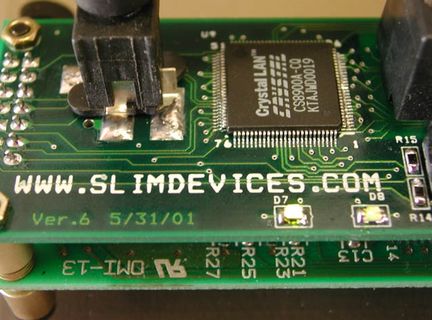
I tend to think that the interference is occurring on the board, since I've never had any trouble with twisted-pair near this same lamp, which I've had for years. I've heard of lamps like this interfering with DSL, but never Ethernet. In any case, since I've stopped using this lamp the SLIMP3 has been fine.
I have also seen significant diagonal interference patterns on broadcast TV channels 3 and 4 when the SLIMP3 is powered. (I suspect that cable TV would be unaffected by this). I don't watch much TV, but it's another sign that proper shielding is warranted.
Conclusions
Despite some blemishes, the SLIMP3 is a good product and I have no doubt it will continue to improve with further development. It is already an impressively functional device, nicely filling a niche for open network-based MP3 players. If you have the hacker mentality, a bunch of MP3s, a UNIX box and $249, you would be hard-pressed to find a more suitable player. The ability to easily modify the fundamental behavior of a consumer electronic device is just too cool.
And it makes nice sounds too
It is clear that the people who designed the SLIMP3 have a clue. They designed a product they wanted to use themselves, and those are invariably the best products. Before you buy, check out their website, read the FAQ, look at their pictures, read the development mailing list archives. To the right kind of person, the SLIMP3 sells itself.
Caractéristiques techniques
• Formats audio natifs: MP3 CBR/VBR - 16bit / 44,1kHz.
• Interface réseau: Ethernet 10baseT.
• Convertisseur N/A: Crystal CS4334.
• Mémoire tampon: 1 Mb (8 secondes @ 128 kbit/s).
• Sorties audio: RCA analogiques.
• Télécommande: infrarouges.
Informations commerciales:
• Date de sortie : août 2001.
• Prix de lancement: 269 USD (249 USD à partir de janvier 2002).
Anecdotes:
• Les 200 premières unités ont été assemblées à la main.
•
Pendant
les 18 premiers mois de
commercialisation, le SLIMP3 a été livré
avec diverses
télécommandes
infrarouges universelles (un guide
expliquant comment
les paramétrer
pour le SLIMP3).
What's inside my SLIMP3 ?
• VFD : CU40025SCPB-U1J
► For more information - here -
• CU40025SCPB-W6J is recommended to replace CU40025SCPB-U1J
and CU40025SCPB-W1J
► For more information - here -
• U1 : U2 : Microchip, PIC16F877-20I/L 9930SBP
► For more information - here -
• U3 : CMX-309FL C, 20.0000 M, 232216
► For more information - here -
• U4 :
• U5 :
• U6 :
• U7 : CMX-309FL C, 14.3181M, 231206
► For more information - here -
• U8 : CS4334K, LBGD141
• 8-Pin, 96 kHz, Stereo D/A Converter
► For more information - here -
► For more information - here -
• U9 : Crystal Lan, CRYSTAL, CS8900A-CQ, KTA0PD0014
• 10Base-T Ethernet Controller
► For more information - here -
► For more information - here -
• U10 : SAMSUNG, 019A, K6T1008C2E-GB70, T3ZC35C2 KOREA
• 128K x 8 bit Low Power CMOS Static RAM
► For more information - here -
► For more information - here -
• U? : XILINX, XC95144XL, TQ100BEN0117, F1179330A, 10C
3.3V CPLD
► For more information - here -
► For more information - here -
• U?? : MICRONAS, MAS3507D F10, 9387 62 LB U, 78060.000 ES
•
MAS3507D
MPEG-1/2 Layer-2/3 Decoder
(PMQFP44, PLCC44,
PBGA49)
► For more information - here -
► For more information - here -
• ?? : PE-65745
• Isolation transformers for 10base-T, Pulse Engineering, Inc
► For more information - here -
Upgrade SLIMP3™
Gainclone and SLIMP3™
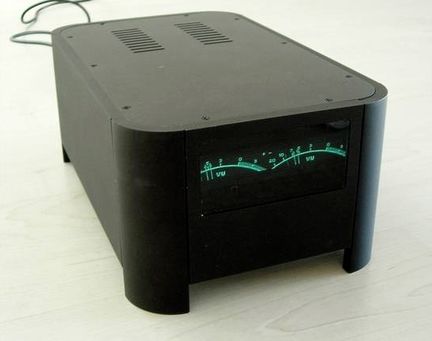
DIY (Do-It-Yourself) gainclone. This integrated gainclone consists of the following components:
• gainclone using LM3886 chip;
• audio Sector NOSDAC;
• Mark Levinson based op amp;
• digital receiver- hacked SLIMP3.
► For more information - here -
A SLIMP3 in a tube full acrylic with two speakers

Album covers for your SLIMP3 - What's this all about ?
It's easily one of the coolest electronic gadgets I have ever bought. One of the nice things about it is that it includes a Web interface to control the player, including all the playlists and such. This feature also has the ability to show the album cover in the Web interface, if an image file is in the same directory as the MP3s. Looks something like this (note that this image is scaled down to 800x600 to be of reasonable size).
The problem I ran into was that I had a huge number of CDs and wasn't about to spend an insane amount of time scanning in every album cover. By an odd coincidence, at this same time, I discovered Amazon's SOAP interface to their database. A solution quickly evolved to meet my problem. It's possible to query Amazon's database for a given title, and pull down the image for the album cover from their site.
This script will run over your MP3 directory, look at the ID3 tags of the MP3s it finds, and will perform several different types of searches on the Amazon database to find the closest matching album. It will then download the album cover, if it's available, and place it in the corresponding directory for that album.
► For more information - here -
2003 - La Squeezebox™ 1/1G
Publications
Homecinema-fr.com
Fort du succès du SLIMP3 (plusieurs milliers d'unités vendues), Slim Devices lance en 2003 une version améliorée de ce dernier, la Squeezebox™ 1/1G (v1). Les principales améliorations apportées par rapport au SLIMP3 sont:
• Support natif des flux PCM (AIFF, WAV).
• Transmission des flux par TCP (le SLIMP3 ne supportait que l'UDP).
•
Support
des réseaux sans fil 802.11b
(en option à partir de janvier
2004).

The Squeezebox's superb 2-line x 40 character display
Les toutes premières versions sorties possédaient un afficheur VFD identique à celui du SLIMP3 (2 lignes de 40 caractères). Il a rapidement été remplacé sur la série Squeezebox™ 1G par un afficheur VFD graphique qui a ouvert la voie à de nouvelles possibilités (polices de caractères multiples, animations, etc.).
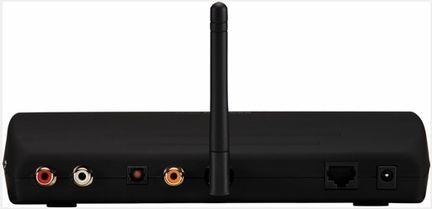
Squeezebox sports stereo RCA Jacks, optical S/PDIF,
digital Coax, an antenna and an Ethernet jack.
Au moment de sa sortie en novembre 2003, la Squeezebox™ n'était disponible que dans sa version avec réseau Wi-Fi.
À partir de janvier 2004, une version sans Wi-Fi (le module Wi-Fi est une simple carte PCMCIA pour PC portable), moins coûteuse, est également proposée.
Pour l'occasion de la sortie de ce premier modèle de Squeezebox™, le "SLIMP3 server" est renommé en "SlimServer".
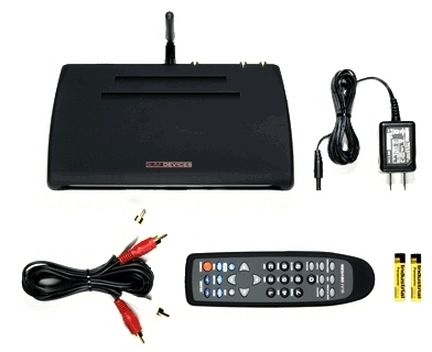
Squeezebox comes with a small but powerful remote.
Reg Review
Tony Smith
I have a dream, ladies and gentlemen, of listening to music of my choosing that has been pumped through the ether as if from nowhere. There are no discs to change, no turntables, drives or tape mechanisms to disturb the concentration, just pure audio, accessible on whim and a player.
Compact Disc welcomed us to the world of digital music. Almost two decades later, MP3 realised the potential of compressing music to make possible archiving huge quantities of the stuff. Today's monstrously capacious hard drives allow us to build that archive.
One thing spoils this audio heaven: the need to wire said hard drive to the hi-fi. There have been hi-fi units equipped with hard drives, but nothing beats a personal computer for ripping and managing an audio collection. But most computers, even Apple's don't sit well alongside a living room entertainment system. And who wants to walk over to a PC to set a player app in motion?
What's needed is a way of keeping your music in one place - the computer up in the spare room - but which lets you listen to it from the comfort of a fine leather reading chair in the lounge.
Enter Slim Devices' Squeezebox™, a remote music access point that uses the magic of Wi-Fi to enliven your hi-fi, without forcing you to physically merge the worlds of consumer electronics and computing.
The Squeezebox™ is about the size of a large, 'trade' paperback. At the back sit a set of digital and analog outputs, a 10/100Mbps Ethernet port, a screw-on WLAN antenna and the power jack. There's a 3.5mm headphone jack on the side. Up front, you'll see a large, crisp two-line LED panel, slightly larger than the kind you might see on a DVD or CD player. There are no controls - the Squeezebox™ is operated by remote.
Get connected
Connecting the Squeezebox™ to an amplifier is straightforward. And in a real challenge to claims that Wi-Fi isn't easy to use, getting the unit to talk to your WLAN is equally clear-cut.
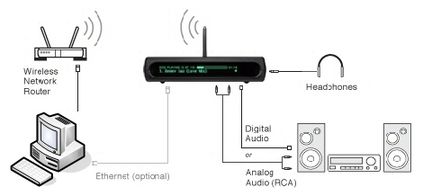
Go wired or wireless, analog or digital, open air or headphones.
It really is a doddle. Plug in the power cable, wait the briefest of moments and the Squeezebox™ takes you through a short series of steps. First, select your WLAN's SSID. If there are several in the vicinity, you use the up- and down-arrow keys on the remote control to find the right one. Press the right-arrow key when you've done so.
Next, tell the device whether the network is secure or not. If it is, you enter the 64-bit or 128-bit WEP encryption key using the remote's numeric pad. I tried the Squeezebox™ on an open, public network and on my own, rather more tightly tied down home WLAN, and had no trouble getting it to work with either. Having fought with Wi-Fi and WEP before, it was nice to have something wireless work first time.
Moving on, you're subsequently asked whether the device's IP address will be assigned or is static. I choose the former, and the Squeezebox™ promptly requested one from the router.
Finally, you're asked to select the computer on which Slim Devices' open source server code is running. Again, there may be more than one, so use the arrow keys to locate and select the one you want. And that's it.
The light-weight server software (written in Perl, incidentally) has to be pre-installed on the computer holding your music archive, of course, but that's not likely to tax anyone smart enough to rip their CDs. Slim Devices not only supports the various incarnations of Windows, but Linux and Mac OS X, which wins it much praise from this quarter and a big yah-boo-sucks to its Windows-only rivals. You may need to tweak your firewall, of course.
With the system in place, you can start playing your songs. The Squeezebox™ features a straightforward search system, allowing you to locate tracks by artist, album title, song name and so on. And you can browse the entire contents of your music folder.
The remote's numeric pad uses the same alphabet clusters as a mobile phone keypad, so entering a few characters or even a long album title is easy. The Squeezebox™ uses that to interrogate your music collection, and displays a lists of items which fit the bill. Again, you just step through the list using the remote's arrow keys.
There are slight pauses as the box talks to the computer via the WLAN, depending on the level of background traffic, but controlling the Squeezebox™ itself is quick and responsive. Select an album, press Play, and the device will start running through song by song.
It maintains a dynamic playlist to which you can add songs by finding them and hitting the Add key. This quickly lets you build up a dinner party playlist, greatest hits selection or whatever. Removing them is trickier, but possible.
The remote also provides the usual pause and track-skip keys, along with shuffle and repeat play order controls, and a handy Now Playing button. You can also set the LED display's brightness and switch it to show a magnified, single-line read-out. You can also control the Squeezebox's output level with a pair of Volume buttons.
Multi-format playback
The Squeezebox™ plays back MP3 files by preference, but it can cope with iTunes' AAC files (providing they're DRM-free) and Ogg Vorbis tracks, but you'll need extra software to do it. Slim Devices could have done a better job at explaining how this is achieved, and even bundled the appropriate code. But a quick download of Blacktree, Inc.'s iTunes-LAME Encoder - linked from Slim Devices' FAQ - solves the problem.
It includes a version of LAME tailored to transcode AAC and QuickTime's .MOV formats to MP3, which the server software streams across to the Squeezebox™. There are Windows equivalents for PC-based iTunes users. LAME and Oggtools are enough to do much the same for Ogg Vorbis archives, says Slim Devices.
AAC transcoding is set up to convert to uncompressed AIFF, but transmitting all that data proved too much of a limiting factor on my 802.11b network. AAC-encoded tracks songs sounded choppy, with small sections of each track missing.
The squeezebox™ keeps time and ignores dropped packets, simply picking up the audio when it returns. So if you lose half a four-minute, say, it won't take more than four minutes before the next song starts.
That said, you do occasionally see the counter get out of sync with the song, a phenomenon that manifests itself as the next track appearing on the display before the previous one has finished.
Shutting down the missus' Citrix client, helped, but configuring the server software to convert to AAC to MP3 rather than AIFF led to a big improvement. Again, this tip comes from Slim Devices' FAQ and a separate download but should have been part of the package.
I didn't experience any of these problems with native MP3s (apart from the track counter synchronisation) and Slim Devices claims its machine works equally well with uncompressed WAV and AIFF files, for those who prefer the true CD quality audio - just make sure you've got plenty of bandwidth.
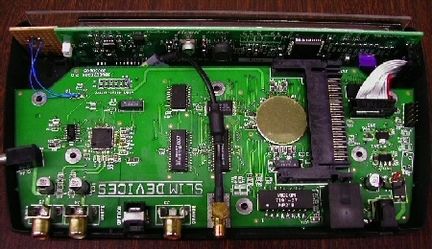
Inside the Squeezebox.
The sound quality was good, with the caveat that what you get depends on what level of compresssion you use on your archived songs. While an oscilloscope might reveal the addition of noise to the audio signal, my ears couldn't. Like me, you may have to make some adjustment's to the Squeezebox's own Volume, Bass and Treble controls to allow you to set your amplifier's volume to the level you're used to having it at.
With my Music folder copiously filled with classical, rock and spoken word repertoire, and an extensive if eclectic playlist ticking away on the Squeezebox™, I settled down with a large glass of Wirra Wirra Church Block to enjoy this realisation of a dream I've had for nigh on 20 years: tens of thousands of songs, all no more than a few remote control button presses away.
Slim Devices' gadget isn't the only one of its kind, and not the first, but it deserves praise for its cross-platform and multi-format support. And it doesn't pretend to be anything but a music system. So there's no attempt to let you view holiday snaps on your TV, or even the suggestion that your 802.11b network will happily cope with full-screen, full-motion video.
The squeezebox™ was a joy to use, particularity once the AAC problem had been resolved - a problem that wouldn't have existed had I had the bulk of my music collection in MP3 format. With MP3s, there really was no problem, and I could sit back and enjoy my playlist, or leave it running in the background while I offered my guests drinks.
The one downside - and it's a minor one - is the WLAN support. With a newly installed 802.11g network, it's a shame to have to drop down to 802.11b for the Squeezebox™. Roll on the higher specked version, I say. And hopefully a more comprehensive set of instructions and bundled software while Squeezebox™ is at it. Having to download code makes for a more up-to-date install, but it's not entirely consumer-friendly
Caractéristiques techniques
•
Formats
audio natifs: MP3 CBR/VBR,
PCM (WAV et AIFF)
16
bits / 44,1
& 48 kHz.
•
Interfaces réseau: Ethernet 10baseT,
Wi-Fi
802.11b
(support WEP
uniquement).
• Convertisseur N/A: Micronas MAS3539.
• Mémoire tampon: 1,8 Mb (14 secondes @ 128 kbit/s).
• Sorties audio: analogiques: RCA et jack stéréo 3,5 mm
• Sorties audio numériques: RCA et Toslink.
• Télécommande: infrarouge.
Informations commerciales:
• Date de sortie: novembre 2003 (Squeezebox 1) - ? (Squeezebox 1G).
•
Prix de lancement: -/299 USD
(199/279 USD à
partir d'avril 2004)
sans/avec support Wi-Fi.
Manuel d'emploi
► Téléchargez le manuel en Anglais - ici -
Upgrade Squeezebox™ 1/1G
Case for Squeezebox™ 1/1G
The case is refurbished from an earlier project. It's really only a folded sheet of metal, without a left, right and bottom part. The front is a piece of plexiglass with a black layer in between. I had to add something to the front to cover the holes from the earlier project.

The long and thin display cable added additional resistance to the powerlines causing the diplay to show 'garbled' output and also fainting. To compensate for that I added a big capacitor (about 2200uF) to the powerlines.


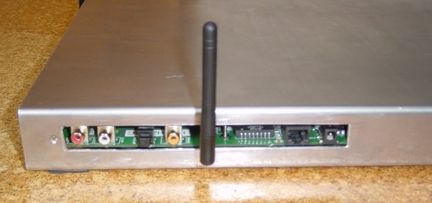
Sidenote: It's not that I don't like the original case, but my prototype Squeezebox didn't have a case so far.
Squeezebox graphic display - Upgrade Slim Devices
► For more information - here -
Super Squeezebox Wi-Fi network player slideshow
2003 - La Squeezebox™ 2 (v2)
Publication
Positive Feedback
Gary Beard
The Squeezebox™ 2 is a high-tech piece of computer hardware that plays computer music files and internet radio stations through its built-in Toslink or coax digital outputs (or its analog output), but there is more—the Squeezebox™ 2 can stream musical ones and zeros from a remote location via its built-in 802.11g wireless capability, or hardwired via an onboard Ethernet connection.
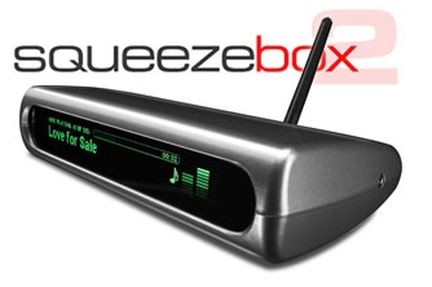
Modèle avec Wi-Fi.

Modèle sans Wi-Fi.
Slim Devices also makes an Ethernet-only version for the wireless-challenged, but for an additional fifty smackers you get both. This seems like a no-brainer to me. Small in size, the Squeezebox™ 2 could easily be confused with a Sharper Image clock radio if weren't for its elegant fluorescent display ticker-taping the names of rock anthems and Bach sonatas across its front. Just so you know, it also has a setting that allows it to be used as an alarm clock!
The Squeezebox™ 2 must be controlled from a computer running special software. This software, called Slim Server, is open source, which means that it is freely distributed, and that anyone who has the desire and knowledge can tweak, add to, and/or create updates and new applications.
When installed on a Windows, Mac, or Linux-compatible computer, the Slim Server software runs as a Web-based interface that allows the user to control all of the SB2's functions, from setup to music file management to internet radio capability. You can close the Web browser window without stopping the server, in which case it will run "silently" in the background, playing music files stored on the computer.
The software can also interface with Apple's iTunes, incorporating all of its existing music files and play-lists. The thing has so many options and parameters that an entire book could be written about it, but instead of continuing to butcher the digital-operative lingo, I will describe my experience with this third-generation Slim Devices music player.
I have no experience with Slim Devices' inaugural product, the SLIMP3 Networked Music Player, but I do own the first-generation Squeezebox™. Because I was satisfied with its performance as a whole-house music server, I gave it a trial run in my main two-channel system.
While not awed by its performance, I was sufficiently intrigued that when the Squeezebox™ 2 with its faster, wireless connection and supposedly more robust audio performance—was announced, I immediately put my name on the list for a review unit.
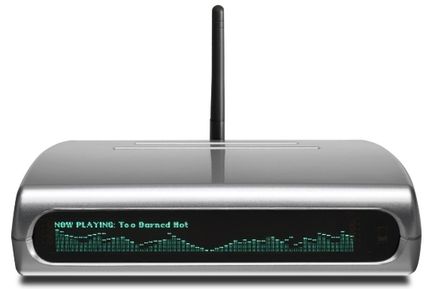
My previous experience had prepared me for wading through the treacherous waters of wireless computing. Using the 802.11g wireless standard, the Squeezebox™ 2 is much faster than the original. Gone are the occasional dropouts and slow access times that compromised the functionality of the first Squeezebox™.
The Squeezebox™ 2 is a terrific upgrade for the same money. It is faster, has nearly zero dropouts, and with its new Burr-Brown DAC and low-jitter clock, the sound approaches a level that even the most jaded audiophiles can enjoy.
The big difference between the Squeezebox™ 2 and every other audio component in my home is its relative complexity. Does that mean that it is difficult to use? Yes and no. Though it certainly helps to be computer-literate, anyone who has downloaded and installed software from the Internet will find the Squeezebox™ 2 easy to set up.
The earliest versions of the software had a penchant for crashing emails and documents as you tried to save them, but this has been fixed, and I have had very few problems.
In addition to all of the computer crazies that have pushed the evolution of Slim Server along so rapidly, there are many folks developing software add-ons and plug-in programs to use with the SB2. The fact that the Squeezebox™ 2 should continually improve for some time to come is one of its most important virtues.
At a time when technical obsolescence can occur virtually overnight, it is comforting to know that someone will always be trying to make the SB2 work better, even after it is no longer the new toy in town.
Now that you have downloaded the Slim Server freeware and have it running, you are ready to rock, right? Perhaps so, if you are using an Ethernet connection or already have a wireless system in place. If neither is the case, I'm afraid you'll need to set up either a wired or a wireless network.
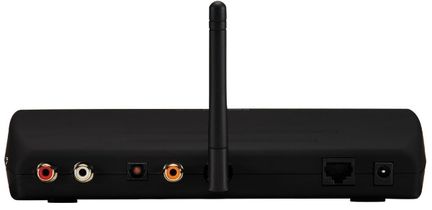
Both are simple tasks—for a computer geek. I went wireless, as I wanted to be able to move my system to different rooms without having to run a CAT5 cable to every corner of my little house on the prairie.
I have a wireless Access Point that is connected via Ethernet to my hardwired router. I was lucky enough to have a spare CAT5 cable from my router to a centrally located closet that was no longer being used for computer duties.
This location gives me great coverage, and I get a wireless signal strength that averages in the 80 percent range. Setting up the Access Point was not entirely painless–it took a week or two to get the gremlins out—but once accomplished, it worked without a hitch.
Though the Squeezebox™ 2 itself must also be set up, this is MUCH simpler than it was with the original Squeezebox™. (I don't really know why, but without a doubt it is. I only know enough to be dangerous—I read the directions and when I can't make it work, I get my kid to fix it.)
The good news is that the new unit will usually connect automatically, but it might not, in which case a bit of sleuthing is in order. It certainly helps to have a modicum of knowledge about IP addresses and DNS servers. You don't have to be Bill Gates, but a computer novice will undoubtedly struggle if things don't go smoothly.
It might be smart to have the computer cavalry on standby, they may need to ride in and save the day. It should also be noted that funny things happen when the power goes off, so after a storm knocks out the grid, your Squeezebox™ may have some (hopefully) momentary brain dysfunction.
Every system will be different, so there is no magic bullet except rolled sleeves and good fortune. If I've made setting up the SB2 sound like a task of Herculean proportions, don't fret, because truthfully, almost anyone can do it.
Once the system is up and running, it will need some tunes to play. You could load crappy MP3 files onto your computer's hard drive, but hey, we're power users here in audiophile land! I purchased a Maxtor 300-gig external USB hard drive, then spent days and days ripping (transferring via a computer program) all my CDs with Apple's iTunes program, converting from Redbook format into Apple Lossless files to save space while leaving quality intact.
I currently have almost 6000 songs by over 440 artists, with room for another 5 or 6000 before I have to run out and buy another drive. And yes, any prudent person would have a second drive set as a backup in case a crash takes place. It did take an excruciatingly long time to rip all those CDs, and I would hate to have to do it again. I guess I'd better become a prudent man. and soon!
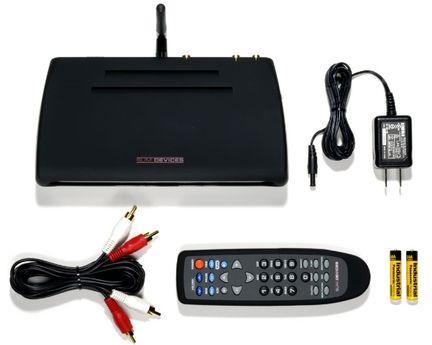
While the Slim Server is quite adept at running the SB2, it is a bit rough around the edges. Since you need a separate program to transfer your digital discs to the computer anyway, and being a simple kind of guy, I settled on iTunes to handle my music management duties.
Many computer music gurus swear by Exact Audio Copy (EAC) to convert CDs. If they want to save computer space, they convert those WAV files to the lossless compression format of FLAC.
While this may yield superior file transfers, to the best of my knowledge, FLAC files will not work with iTunes. Why, then, do I use it? Apple's Lossless format sounds very good, and that makes it simple. This is my version of simplicity:
1. Download iTunes.
2. Set iTunes to convert CDs to Apple Lossless format with
error
checking
enabled.
3. Rip hundreds and hundreds of discs.
4. Make up play-lists to your heart's desire.
5. Enter the path to the iTunes folder in the Slim Server software.
6. Play back play-lists by choosing them either in the Slim
Server
software at
the
computer, or by using the remote control to scroll
through them in
the
Squeezebox™ 2 display.
That is the abridged version of setting up the Squeezebox™ 2. If you want more information, you'll need to visit the Slim Devices' Website, where you can download the software, check out the FAQs, and browse the informative user's forum. It will also be worthwhile to find a good computer Webzine review, which will surely touch upon many more set up issues and options.
The SB2 clearly outperforms the original Squeezebox™ by a wide margin and in every category, including sound. Both units offer a remote control that operates every necessary function. Its operation is intuitive.
After scrolling through the functions a few times, even the most tech-adverse should be able to access music, change volume, play internet radio, and execute the basic commands: play, pause, next track, and stop. There is a dizzying array of options, mostly having to do with set up of the unit.
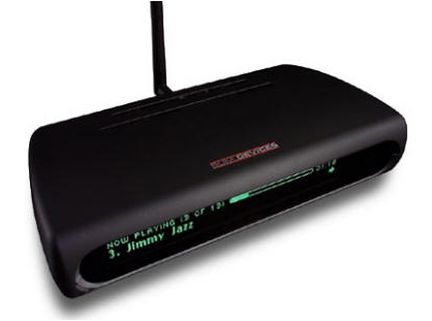
The only ones I really use are displaying the setup menu, setting the fade in/fade out/crossfade options, and choosing where to locate my default music storage folder. When setting the display, there are many different visualizers to choose from, including analog VU meters and scrolling newscasts, but I chose to see the title, artist, album, and year of the music being played.
Again, I have only scratched the surface of what is available. Anything beyond the best sound with the fewest glitches is computer gee-whiz territory and not my bag.
One very cool thing about the little black plastic Squeezebox™ 2 is its ability to stream SHOUTcast, Radioio, and Live365 Internet radio stations. If you've never used Internet radio, it is a great way to listen to music and stimulating discussions from around the globe. One night I lucked onto an Irish radio station playing drunken jigs and reels streamed live from a Dublin pub.
Internet radio makes the Squeezebox™ 2 worth the price all by itself, but what could be even better is a feature so new that I have yet to really use it—the SqueezeNetwork, which has just been introduced, promises to allow the SB2 to connect to services like streaming radio without running the Slim Server (hence the computer). Righteous, dude!
If small and simple is your ideal, buy a Squeezebox™ 2, connect it directly to a power amp or powered speakers, and control the volume via the Squeezebox™ 2's 40-step digital volume attenuator. You'll have a fine, simple audio system. To hear the SB2 at its best, selecting two options in the Slim Server "Player Settings" window is very important.
Disabling the digital volume control by selecting "Digital output level is fixed" and "No Limit" on the bitrate option allows the Squeezebox™ 2 to bypass the digital volume control and play files at their highest recorded bit rate, with the following caveat—at present, file playback is limited to 48 or 44.1khz sample rates or below in the PCM audio format of 16 or 24 bits per sample.
As a computer-based digital playback system, one of the most important features of the Squeezebox™ 2 is its ability to play a plethora of popular computer music formats, including .WAV, Apple Lossless, Windows Media, FLAC, Ogg Vorbis, and of course, the dreaded MP3.
Aside from great sound, the ability to play lossless formats is (to me) the SB2's most important feature. Without this capability, my hard drive space would be nearing extinction, yet I would never commit the sacrilege of converting perfectly good CDs to MP3 for playback through a Fi-X tube amp!
As I have gained experience as an audio writer, it has become increasingly difficult for me to describe the sound of components. I have become keenly aware that great audio reproduction can only be the result of a carefully assembled system. This is especially true of the Squeezebox™ 2. Its built-in Burr-Brown DAC is lightyears beyond its forerunner in sound quality.
While the SB2's internal DAC really does sound very good—stout bass, extended treble, clean mids, and excellent resolution—it seems a bit sloppy and ragged compared to its S/PIDF coax output connected to my Birdland Odeon-AG DAC. In my opinion, it is the SB2s new lower-jitter digital output that allows it to become an integral part of a high-performance audio system.
While I am not going to give you the usual blow-by-blow audiophile commentary, there are some important things to note about the Squeezebox™ 2's performance with an outboard DAC. Using its coax digital output, the SB2 is very silent. A lot of audiophiles dislike the word "neutral," since no one can really define what it means.
Still, the Squeezebox™, used as a transport, does not seem to add any sound of it own. How do I know that? For a short but sweet time, I had an Audio Note DAC connected to the SB2. The AN's sound was amazingly forthright and highly transparent, with deep bass, extended treble, and wonderfully rhythmic drive. Alas, the unit eventually traveled eight hours north with its owner.
The Odeon-AG sounds wholly different than the AN. Its resolution at low levels is stellar, as is its imaging. It also has beautiful tone, and the sound just pours out in a pure, musical stream. Nevertheless, it has less drive than the AN and lacks the AN's deep bass capability.
Both DACs sound wonderful, and both sound distinctly different. With both, I can hear the Fi-Xi doing its brilliant 2A3 tube thang, and can clearly hear the differences in speakers, so without further ado, I pronounce the Squeezebox™ 2's digital output to be neutral.
Does this mean that I think the Squeezebox™ 2 is the best digital transport around? Hell no! But I do feel that it compares nicely with many of the disc slingers I've tried. Paired with the Birdland DAC, it is not in the same league as the Lector Alphatop, which is the finest I have heard. The combo sounds different than the high-energy preciseness of the Cary 303-200, but very much like the laid back Metronome.
It should be noted that I no longer strive for the ultimate stars of audio space. My gear is good, but simple and relatively inexpensive. My focus is on synergy and great sound for the money.
The Squeezebox™ 2 lacks the effortless air and space of the best digital gear I've heard, so it might not be the best transport for a megabuck, pick-out-the-rosin-on-the-bow system, but you know what? It kicks ass in the realm of convenience, and sounds really, really good doing so.
The SB2 is making some waves in the DIY and high-performance modding community, and there are some talented people who are engineering modifications to take this unit to the next level of performance. One modder in particular, Vinnie Rossi of Red Wine Audio, has taken the SB2 off the power grid.
Vinnie tells me that his extensive internal modifications and SLA battery power improve the SB2's sound to the point that an outboard DAC is no longer needed, and he uses the digital volume control!
Something new and perhaps better is always right around the techno-corner, but by waiting for the perfect solution we sometimes miss an opportunity to try a truly innovative product, even if it is not perfect. There are other devices on the market that wirelessly stream music, and they may be just as terrific as the SB2.
I bought my original Squeezebox™ for its Apple Lossless capabilities, and I will be buying the Squeezebox™ 2 for its excellent audio performance. I now use the SB2 daily for critical listening, and I am blissfully in the land of fingertip music. It is an addictive and marvelous way to listen.
It is like having my own high-quality radio station, without the brainless, time-wasting commercials. I cannot say that the Squeezebox™ 2 is for Joe Everyconsumer, as it has all the quirky earmarks of computer-based technology, yet the SB2 is so astoundingly convenient, and sounds so good, that it can no longer be ignored.
If you can deal with the vagaries of computers, are willing to commit a few bucks to set up a wireless network (or even just a Ethernet cable slung through the house), and don't mind spending a few days, or weeks, converting CDs into computer files, you can have a wonderful taste of audio's future right now, for a mere 250 dollars.
Manuel d'emploi
► Téléchargez - ici -
2003 - La Squeezebox™3 (Squeezebox Classic)
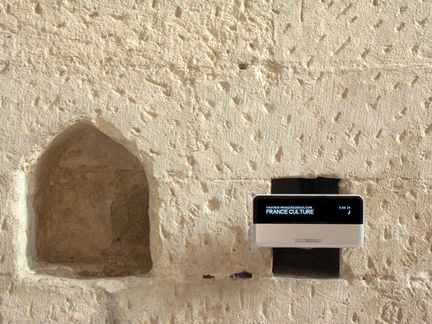
Présentation en première française à l'abbaye Saint-Hilaire de la Squeezebox 3.
Publications
Paragon - January 5, 2006
Mark Lanctot
While you may never have heard of Slim Devices, this small start-up originated the networked audio player market back in 2001. The concept behind the company was to produce a slim device, minimalistic on the player client side and powered mostly by the server. The theory behind this is that adding functionality and features to the player client is complex and expensive.
CPU and firmware resources are at a premium. However, providing the computing horsepower and features on the server side is much easier and cheaper. It also makes implementing radical changes trivial by comparison.
The Slim Devices Squeezebox™ 3, now referred to again as the Squeezebox™, is the company's 4th generation product. The company's first product was the SLIMP3, a 10 Mbps Ethernet-only, MP3-playback-only device. The first Squeezebox™ added 802.11b wireless capability with WEP security, a larger buffer, a larger screen and many more playback formats.
A Squeezebox™ update was the addition of a graphical display, which could be installed by the user in earlier Squeezebox™. The Squeezebox™ 2 updated the Squeezebox™ hardware with 802.11g wireless networking, WPA security, a very large buffer, an even larger display, improved audio circuitry and support for more audio formats.
The latest Squeezebox™ product, which just started shipping November 1st, shares its hardware with the Squeezebox™ 2 but uses an entirely new housing, a filter to change the screen colour to aqua and a new power supply that emits less radio interference.
Support for native WMA decoding was introduced, which also updated the Squeezebox™ 2. The company's thinking is that the external looks finally match the unit's internal sophistication.
The Hardware
The Squeezebox's housing is a brand new look for the company. It is composed of brushed aluminum, an aqua-coloured display and gloss black finish around the sides and back; white is also available. It looks extremely stylish - almost Mac-like. It's sitting on top of my Energy C-5 right speaker, which seems to have been made for it!
This is a radical design change for the company, which housed the first Squeezebox and the Squezebox2 in an angular, boxy housing with a prominent external antenna:
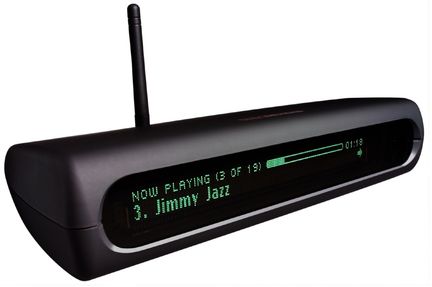
Squeezebox 2.
The most eye-catching part of the Squeezebox design is the gorgeous 320 X 32 X 2-line graphical vacuum fluorescent display that's really a sight to behold. These sorts of graphical displays are usually only used in commercial and industrial devices as they are simply too expensive for consumer-level devices.
Consumer manufacturers have moved on to LCD displays instead. But Slim devices, in a decision which gives you an idea about the philosophy of this company, found backlit LCDs too dim to be read from across a room and decided not to sacrifice quality to save cost.
The Hardware con't.
From left to right is the headphone connection, the right and left analog outputs, the optical digital output which I'm using, the coaxial digital output, the Ethernet port and the power jack for the tiny "wall wart" power supply, not much bigger than an ice cube. Note that BOTH optical digital and coaxial digital outputs are included.
Slim Devices offers the Squeezebox in wireless and lower-cost wired versions. In the wireless version, the unit can operate in either wired or wireless modes. If it's operating in wireless mode, plugging a PC into the Ethernet port can turn the device into a wireless bridge. The unit will operate as a wireless bridge and as a normal Squeezebox simultaneously. How cool is that?
There really isn't as much dust on top of the unit as it appears! The housing is so glossy that the overhead room lighting made it very apparent. This photo was even taken after cleaning with the included microfibre cloth.
A small and fairly mundane 3rd party remote is included, which is white for the white units:

Internally, the unit contains an 802.11g wireless receiver with a large 40 Mbit (5 MB) audio buffer to avoid dropouts in adverse wireless networking conditions. This ensures playback for several minutes after the unit has lost a signal. To avoid marring the unit's looks yet have good wireless reception, there are two internal antennas.
Wireless security is through WPA or WEP, although no encryption is supported as well. WPA2+AES is coming soon. The unit can support non-broadcast SSIDs and it can use a DHCP-assigned IP address or a static IP address.
Slim Devices lavished a lot of attention on the audio circuitry to ensure high-quality playback. Two separate linear power supplies are used for the DAC (digital-to-analogue converter) and line-out stages. The device uses a 24-bit Burr-Brown DAC for its analogue output. This is better than most CD players and at least as good or better than the DACs found in most audio/video receivers. The digital audio circuits also get special treatment. Rather than use cheaper PLL-based timers, it uses dual high-precision crystal oscillators
Unlike soundcards and A/V receivers, there is no conventional digital signal processor, or DSP, used to process the sound. Instead the code sits in the unit's flash memory and portions of it are retrieved as needed. The unit's 250 MHz RISC CPU then does all the decoding work rather than a dedicated DSP chip which would not be nearly as powerful.
This also means new decoding formats and performance enhancements can be added very easily. For example, the latest firmware update added native hardware WMA decoding capability.
What do all these audio terms mean, you ask? It means that Slim Devices has spared no expense to bring you the highest quality audio possible. You will have to pay careful attention to your source material as the Squeezebox can easily reveal any compromises you have made in CD ripping. It is far more accurate than a consumer-level CD player.
Oh and to tempt us, the headphone output is not merely a headphone output, it is a multi-functional "geek connector" that can enable advanced control. Currently it only supports an IR blaster that can remotely control other devices besides the Squeezebox, but other applications are possible.
Setup
For some reason I could not get my SMC2804WBRP-G router working wirelessly with it. It worked fine wired - in fact wired setup was extremely simple, taking under a minute. I attributed my wireless setup problems to poor router firmware and changed my router to a ubiquitous Linksys WRT54G, which works perfectly, including with 3rd party DD-WRT router firmware.
I was unable to consistently get the unit to operate with SSID broadcast disabled, but it worked well with a 63-character WPA passphrase and a fixed IP address.
I had installed the software earlier to familiarize myself with the UI and the Squeezebox hardware using the SoftSqueeze software emulator, so once I solved the initial wireless networking problems and connected it to my home theatre receiver, that was it.
Operation
The Squeezebox is unlike any device you have ever operated. Simply put, everything is "tweakable"! You can change nearly everything about how the unit operates. Some of this is through the hardware interface, some is through the software which I will cover later.
The menu system is very intuitive and easy to follow. The menus are arranged "horizontally and vertically". You scroll around them using the remote's cursor buttons. The first smaller display line shows which menu you are in and how many items are in the menu (i.e. "1 of 8") while the menu item itself is described on the large second line.
You can scroll through the items in the menu using the up and down cursor buttons. Once you find an item you want to enter, you scroll the cursor to the right to enter it, or to the left to go back to the previous menu. It's very easy to navigate around the menus, and the "drill down" structure feels very natural.
The unit really has two modes, playing local files and Internet radio through SlimServer, and playing Internet radio through the Internet-equivalent of SlimServer, SqueezeNetwork. When using SlimServer, you browse or search through the music stored on your PC or on your local network. On the player, you can browse or search by artist, title, genre, filename, whatever...it's all tweakable.
When browsing, you can sort through them one-by-one or you can narrow it down by typing in characters, either by scrolling up and down to increment/decrement letters or typing them in by repeated presses of a remote button like you would on a cell phone (1=punctuation1, 2=abcABC2, 3=defDEF3, etc.) Searches require at least one letter of text input.
You can play music you're interested in one file at a time or you can add them to the device's playlist. You can play back pre-made playlists or you can save playlists you make for the device.
SqueezeNetwork searching and browsing works similarly, although searches are limited to genre and stream name.
Other menu items accessible through the hardware in SlimServer mode include settings such as language, screensaver when playing, screensaver when not playing, screensaver when idle/off, time format, long date format, alarm settings, library information, player information and server information.
Menu items in SqueezeNetwork mode are limited to language, screensaver when playing, screensaver when idle/off, time format, long date format and alarm settings. You can also access RSS Feeds, Favorites, ambient sounds and a massive live music archive in SqueezeNetwork mode.
The unit supports an impressive range of file formats. Some are decoded natively while some are transcoded by SlimServer on-the-fly and passed to the device. The unit plays MP3, AAC, Ogg Vorbis, MP2, MusePack and WMA lossy formats, AIFF, WAV and PCM uncompressed formats with DTS pass-through, and Apple Lossless, FLAC and WMA Lossless formats.
When you are playing a file, the screen is the "Now Playing" screen. The first line will display "NOW PLAYING", followed by number of items in the playlist (i.e. 1 of 12). The Artist and Title are displayed below in the very large second line, and guess what, the data it displays can also be changed.
If necessary, the line will scroll to display all the characters. The "NOW PLAYING" screen can be reconfigured as follows through repeated presses of the remote's "NOW PLAYING" key:
• artist and title only;
• artist, title and digital VU meter;
• artist, title and small spectrum analyzer;
• artist and title superimposed on a full-width spectrum analyzer.
Each screen can be used alone or with a progress bar, time remaining bar or buffer fullness indicator.
After 30 seconds, the screensaver activates. Again, there are many screensaver options and you've already seen the two most impressive, the analog VU meter and the full-width spectrum analyzer. You can disable the screensaver or adjust the time to activation.
The screen has 4 brightness levels and can use separate levels in playback, idle and off modes. The text size can be altered so that both lines are the same size, the second line is much bigger than the first, or the second line occupies the whole screen (you'd be able to see this font from forty feet away!) The text sizes can be set individually for on and off/standby modes.
And the sound quality? In a word, incredible. Much better than a CD player in my opinion. I conducted comparison tests between the optical digital output and the analogue output since, as I indicated, the unit's DAC is at least as good as those in my A/V receiver.
However it seems my receiver does not handle analogue as well as digital. The digital output was crystal clear and clean but slightly bright (grating treble). The analogue sound was not overly bright but slightly muffled in the vocals. I preferred the digital connection even though the high treble can be irritating at high volumes.
The unit's headphone output, which uses the Squeezebox's DAC, sounds fantastic. Much better than the analogue connection to my receiver. Since the Squeezebox includes a volume control for the analogue outputs, it's perfect as a headphone source or with powered speakers.
Once set up, the unit experienced no wireless connection problems. Signal strength is 80-85 % and remained so even when my wireless laptop ten feet away was down to "fair" signal strength and a 1 Mbps transfer rate. The buffer fills quickly at the start of a song and for files less than 5 MB in size it can store the entire song in the buffer.
The buffer then slowly empties throughout play and is refilled when playing back the next song. I have not encountered any sound dropouts caused by poor wireless bandwidth or buffer underruns, even when playing 1 Mbps FLAC files.
The unit does not go "off" as you would expect. Instead it goes into standby, and the screen will only go off if you select the "None" screensaver. The unit is effectively paused and will start playing right where you left off when you take it out of standby.
Regarding the remote, my Marantz RC1400 universal remote handles the Slim Devices remote's IR codes perfectly.
Software - SlimServer
Note: The software is in rapid, active development. I am reviewing SlimServer 6.2.1, which is the latest stable build at the time this review was written.
Slim Devices' SlimServer software was made open-source right from its start in August 2001, before many of today's high-profile open-source projects. It's freely available for everyone to try.
It works in Windows, Mac OS X and Linux since it's coded in Perl with an SQLite database, and it has useful features even if you don't own a Squeezebox™ since it streams your audio files throughout your network or over the Internet.
The streams can be played back over any software audio player capable of playing streams, such as Winamp or foobar2000. You can even play it back using the free "SoftSqueeze", a software emulation of the Squeezebox™ written in Java.
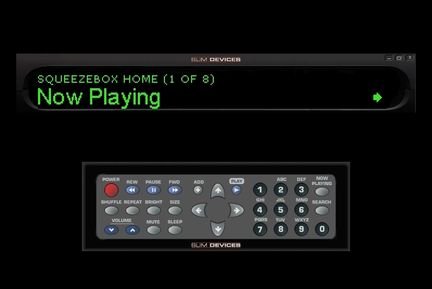
SoftSqueeze.
The server's interface is like any Web page and can be accessed over your local network by starting up any Web browser (it works equally well with IE and Firefox for me) and locating the URL http://:9000. Of course, this port can be changed if desired. The machine actually running SlimServer has this interface come up automatically and points to "localhost" instead of its IP address.
On the machine actually running SlimServer, a tray icon can be used to start and stop SlimServer. Starting SlimServer takes about 15 seconds on my Intel 2.8C/512 MB machine with over 1100 songs. Once SlimServer is started, the Home Web page loads
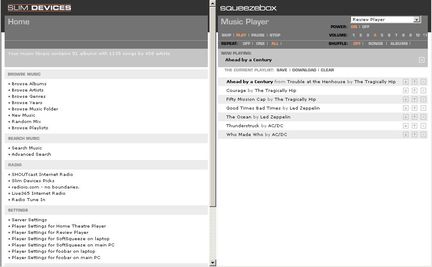
SlimServer Home Page.
On the left side of the screen is the Server portion. To the right is the Client portion, the player. You can select from multiple hardware and software players using the drop-down list. You can browse and search music or Internet radio streams in the server portion and load it to the player.
The Web interface can be reskinned and the program comes with 13 skins. For all players, you can skip, play, pause or stop, repeat one file, repeat all or turn repeat off. You can shuffle by song or album, add or remove songs, save, download or clear the playlist and select which song you want to play.
For Squeezebox's™ and SoftSqueezes, you can also remotely turn on the player and adjust its volume. Regarding the volume, note that "this one goes to eleven!"
New Music lists your music collection sorted by the time they were added, with the most recent first. Random Mix places random files on a continuous basis to your playlist. You can select files from certain genres, artists or albums.
You can also set alarms, either the same one every day or a different one each day. As the alarm music, you can choose either from a playlist you've made or a random album, artist or song mix.
The software can be used to tweak just about everything in Squeezebox's™ and SoftSqueeze players, even esoteric items like scroll rate and scroll speed. You can decide what items appear in menus, where they appear, and select and control everything you can with the remote.
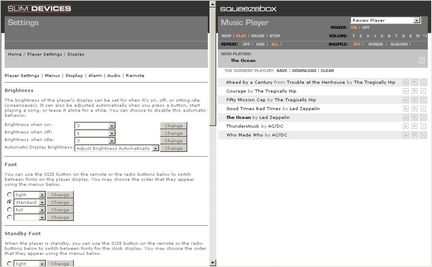
SlimServer Player Settings
The software can handle multiple players and they can each have their own settings. You can see all of mine listed in the home page under "Settings". All Squeezebox's™, SoftSqueezes and software players will be initially recognized by IP address but can later be given unique names to differentiate them. SlimServer will remember what items were last playing in each player.
Multiple hardware and software players can be synchronized to play the same material at the same time, and hardware players can be set to power-on simultaneously for whole-house audio systems.
The software also has good security provisions. Access to it can be password-protected and you can set it to block command-line interface and HTTP requests from all but a list of allowed IP addresses. There is also medium or high protection against cross-site request forgery attacks.
SlimServer performed well on my setup. The most intensive operation you can make it do is rescan the music library for changes. Rescans take 15 seconds for my 1000 songs. CPU usage rises to 50-60 % during this period, but playback on the Squeezebox™ is still flawless and uninterrupted.
Rebuilding the library from scratch and rescanning only takes a minute or so. Even during rescans, SlimServer's Web page generation is quite fast.
SlimServer also uses plugins contributed by the community. The plugins cover items such as new screensavers, games, visualizers, Internet-derived data like weather, sports scores and TV listings and feature enhancements.
Software - SqueezeNetwork
SqueezeNetwork is the Internet-based equivalent of SlimServer and can be accessed from any Internet-connected PC at www.squeezenetwork.com. The feature is powered by Linux servers Slim Devices maintains which run modified SlimServer installations.
When you first set up your free SqueezeNetwork account, you enter in your Squeezebox's™ unique PIN which associates your Squeezebox's™ MAC address with your account.
You can then access SqueezeNetwork directly from your Squeezebox™ - there's no need for SlimServer and you can turn off the PC running SlimServer if you wish. SqueezeNetwork allows playback of the thousands of Internet radio streams, a massive live music archive, ambient sounds and RSS feeds as well as remote control of the player and its settings.

SqueezeNetwork Favorites Page
As you can see, SqueezeNetwork allows you to pause or stop the stream, turn your player on or off, adjust the player volume and shows what is currently playing on your Squeezebox™. This screen shows your favorites since you can't save a playlist as this is all streaming content.
You can also directly play one of your favorites, reorder your favorites, delete them and add new streams to your favorites list, giving them custom names.
You can also add or delete streams using the player, although any streams added this way have to be through one of the prearranged groups of streams available on SqueezeNetwork.
These groups are SHOUTcast, Live365 and radioio, as well as a selection called "Slim Devices picks", a rotating collection of streams. The Web interface doesn't have this limitation, allowing you to add any stream to your favorites.
SqueezeNetwork is much like SlimServer in that player settings can be set within the software:
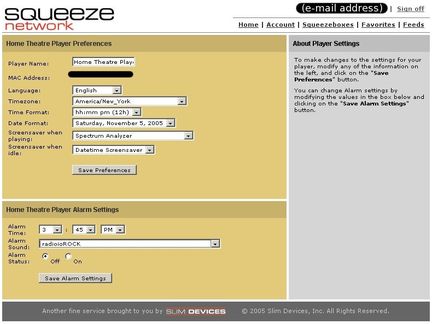
SqueezeNetwork Favorites Page
This is a much more limited feature set than what you can change with SlimServer, but I've got to admit, there's something very cool about changing a setting on a Website in California and having your own player mysteriously respond without any intervention from the remote!
The Squeezebox™ operates differently on SlimNetwork than on SlimServer in that there are fewer options. Yet there are still enough that it's a fully capable Internet radio player. You can also add and remove RSS feeds. This is a neat option, and you can select an RSS feed screensaver either during playback or when the unit is off, but unfortunately it's mostly for novelty as it can only display headlines.
The Company, the Community
No discussion about the Squeezebox™ would be complete without some comments about this unique company, Slim Devices. Never before have I bought something from a company that seems to be so much...well, so much like me!
A comment was recently left on their forum from an ecstatic user like myself that described the company like a group of friends making cool stuff just for us. I couldn't agree more. This small company started in a humble way.
Several company practices reinforce my opinion of them:
• they do not advertise;
• they do not sell in retail stores;
• they keep their price low yet use top-quality components;
• software updates, firmware updates, SqueezeNetwork, all free;
•
all
old products still supported, including the SLIMP3™, now three
product generations behind.
The software updates are frequent and can offer substantial new features. Firmware updates are included with each release but keep in mind that the device is mostly software-powered. Therefore changes in the software can dramatically affect how the device performs and what it can do.
The software is open source and the forums are active with Slim developers and enthusiasts from around the world. The CEO drops in almost daily. Experiencing a problem? Submit a bug report and it will probably get addressed in the next software release - there's usually one or more per month.
Have a suggestion for a new feature or want to see something changed? That can be accommodated as well. Just try that with any other consumer electronic device.
Negatives
Can you have your cake and eat it too? Not quite!
The Squeezebox™3 and SlimServer are very complex pieces of technology. They operate very well, but not perfectly. I haven't been able to get the unit to actually go "completely off" in SqueezeNetwork mode as I expected it to - the standby date/time screensaver always comes on, even though I had selected the "None" screensaver in both the Website and the hardware.
SlimServer is a fairly well-written application, but it uses a fair amount of memory. It normally consumes 60-80 MB, and the tray application that can switch it on and off uses 6-7 MB more. This is better than some version 5 releases that consumed 100 MB or more, so there has been progress.
I don't find this to be a problem as I'm not normally using my PC when I'm playing my Squeezebox™ 3, and even when I am using this PC I haven't experienced any problems. I don't run SlimServer at all times anyway.
There are some minor functionality glitches that pop up from time to time. For example, my screensaver when playing does not come on occasionally. I set it through the player interface and it comes back every time.
Tagging MP3s properly is very important with SlimServer. I standardized on not using the album tag. This worked fine with SlimServer 6.1.1 but with 6.2.1 all my songs were grouped together under one album ("No Album") and I could no longer search by artist.
I added a few album tags and rescanned and it's working well again although the link still indicates "705 songs by 370 artists in 1 album" if I'm looking for just one song. However the song listed is correct. Others were having this problem as well and a bug was created. This is partially my fault, but SlimServer 6.1.1 worked fine with it - 6.2.1 does not.
Conclusion
Can it really get any better? Not much! The unit's stunning looks, high price/performance ratio, its unbelievable sound quality, its supreme flexibility, the outstanding support from the company and the community, its continuously growing capabilities and the pure geek factor make this one of the coolest gadgets around.
Reviewer's Rating: 9.5/10!
Enjoy the Music.com
Scott Faller
The Software
The Slimserver 6.2 software (firmware) that I downloaded installed in a snap. When you see it on your computer screen, it isn't much to look at. It is very utilitarian in nature. When you start the interface program on your computer, up pops a new session in either Foxfire or Internet Explorer (or whatever your Web surfing front end is).
On the left are the basic menus, on the right are your music files (assuming you've ripped some music to your hard drive). Navigating the software is easy enough.
Everything is easy to find and adjust or tweak, just don't expect some snazzy GUI software and you won't be disappointed. Don't get my comments wrong, the front end software is completely usable and does exactly what you tell it to do. Besides, the software was written in an ‘open' code so that anybody familiar with it's language could write small add in programs. You'll find a host of nifty ‘plug ins' at the Slim Devices Website.
In my case, my server is upstairs and my listening room is in the basement. The little Netgear wi-fi router that I use puts out the signal just fine for my connection. When you actually start the player in your system, you can use the remote control that is provided with each unit.
The remote is your typical plastic cased infrared device that is specific to the Squeezebox™. On the remote you can control the volume, scroll the onboard menus (which are many), play, pause, go forward or back, or any number of other preprogrammed options Slim Ddevices have setup.
Although there are several other interface devices (remote controls) that can be utilized like a wi-fi enabled PDA, to control your music, the factory remote does just fine. It will take you wherever you want to go.
Just in case you were wondering, you can attach more than one Slimserver to your network. I've currently got two installed, one Bolder Cable modified (that I'll review in the next installment) and one bone stock SB3. When you have additional Squeezebox's™ installed, they are each controlled independently.
In other words, you can play different tunes in the individual SB's, they aren't synced or ‘master slaved', they operate totally independent of each other. Very cool.
Another nifty feature that the Squeezebox™ has is you can set screen savers to pop up while playing music or when the unit is powered down. The screensavers can vary from VU meters to RSS feeds from your favorite Website.
Guess what? Enjoy the Music.com has just the feed for your new Squeezebox™ as we now offer an RSS / XLM feed. I thought I'd throw in some shameless self-promotion to try to suck up to the Boss... Hi Steve! (Editors note, said in good humor: the stack of non-sequential $20 are behind the rock that looks like it down.
Ripping And Compressing Tunes
The next step was to download what is commonly accepted by digital audiophiles and computer geeks alike, as the best ripping software. Exact Audio Copy (EAC) is an open source, freeware program that can be downloaded at a number of sites. EAC isn't the most intuitive software I've ever played with before, but it isn't bad either.
I'd like to suggest that if you plan to use this that you do some searches on Google and the forums on how to set it up properly. Hydrogenaudio.com is a good place to start. There are all kinds of settings that the laymen (read = me) won't have a clue as to what they are, or mean. Things like Offset, Gap Settings and weirdness like that.
Once you rip your CD to WAV files, you now must choose one of the lossless compression schemes supported by the Squeezebox™. Me, I chose FLAC (Free Lossless Audio Compression).
This is a separate program that compresses the WAV file to save space on your hard drive. I'm getting about a 40 percent reduction in file size over the raw WAV format. As it stands, I've got 236 albums ripped containing 2442 songs with a playing time of just over 198 hours and this takes up approximately 75 gig of drive space.
If you are truly anal about ripping your CD's to a hard drive, there are several programs that will do a bit-by-bit comparison of the original file to the compressed file so you can feel better that you haven't lost a half dozen 1's or 0's somewhere in the translation.
Me, I could care less. I've talked to several people who have tried the comparison and the audible difference is imperceptible when you pick back up those few missing bits and bytes. Not to mention, the comparison then re-ripping required all takes time. With a thousand CDs and counting, life is too short (for me anyway).
All told, between ripping a CD to your hard drive and compressing those files, it takes about fifteen minutes per CD. Obviously, this time will vary on a number of factors. First, your processor speed, next is your CD drive speed and compatibility with the FLAC front end software. Now that I'm up and running, lets talk about some music.
Tweaks
Before I go in depth about how the SB3 sounds, there are a couple of things that you will want to know first regarding the stock unit. First, the stock switching power supply is woefully inadequate for the critical listening that we audiophiles do.
Fortunately, a cheap easy substitution of a $7, 5 Volt 1.5 Amp (regulated) wall wart brings a significant gain in resolution. If you want, you can go for a supped up 5 Volt regulated power supply like Bolder Cable offers or a battery power supply as in the one Red Wine Audio builds. I'll be auditioning each of these in the second of this series on the Squeezebox™ 3.
Next is the software version that you use to drive the digital volume control on the SB3. Keep in mind the volume control is done with an algorithm before the DAC. There are no volume pots on this unit. It's all done with software and a remote. That means that depending on the software version, the unit can sound slightly different.
I happened to pick this one up from some of the guys on one of the audio forums. They had mentioned that the new 6.2 firmware had been released and several of them upgraded. They began to notice that the units didn't sound quite as good as they did prior to upgrading firmware.
In turn, one of them rolled back a portion of the firmware to the previous version and found that the great sound reappeared. Sure enough, I did the same thing and it definitely sounded better than the new firmware.
Since those discussions first popped up, the software gurus at Slim Devices have incorporated some new programming language into the latest firmware update that addresses this issue. The truly great part about this little faux pa is that when the issue popped up, within three weeks (or so) the company had addressed the issue with a downloadable firmware upgrade. Lets see one of the majors try that one on for size.
Listening To Streaming Music
I know all of you hardcore audiophiles out there are cringing at the thought of this but read on, trust me. According to Sean, there are over 200 streaming stations currently available through the Squeeze Network. The quality of the streams varies.
Many of the streams are at 128 bps stereo at a 44.1 kHz. This is far from the ultra low rez MP3 streams you might expect. As I mentioned before, you can always manually type in a Web address and get nearly any feed out there. That makes the total number of streaming stations available over 10,000.
Granted, this isn't like listening to a CD or piece of vinyl but it's WAY better than the heavily compressed FM that gets broadcast in many local areas (or at least my area). And to top it off, there ain't no damned commercials. It's pure streaming music, interrupted (with the exception of the occasional station ID). The radio of the future is here today.
Myself, I've gotten hooked on a couple of different streams. One is the Shoutcast Digitally Imported European Trance Techno Hi-NRG station. The others are just about anything radio streams.
Now, if you've ever listened to streaming music on your computer, you know that there are a limited number of users that can be on a stream at any given time. Keeping that in mind, you may run across a station that you can't log onto. Hopefully isn't one of your favorites but if it is, there are (no doubt) numerous streams that will trip your trigger.
In listening to the streams (at least with the DirecWay satellite), I occasionally get a momentary interruption or hiccup in the feed. Heavy weather is completely disruptive to my stream but I guess that's my fault for living in an area that doesn't have DSL or cable modem. In the same vein, my DirecWay has a screaming fast download speed of over 1.3 mbps.
As an additional feature, Slim Devices has included what they call the Squeeze Network as a menu option on the SB3. The Squeeze Network allows you to listen to streaming music without having your computer turned on. That's a pretty cool feature providing you've got a direct pipeline to the Internet via your network server.
Getting back to the sound quality of the feeds. When you lock onto a station like radio Classical that streams at 128 kbit/s/44.1 kHz, the sound can be quite impressive. Granted, it isn't lossless but can be extremely satisfying.
The sound is fairly natural with an acceptable amount of digital overtones of artifice. If you aren't doing critical listening, the stream is completely enjoyable. If you are reading a book or doing some work around the house, or even trying to find some new music to sample these 128 kbit/s/44.1 kHz streams won't stand out as being inferior in the least.
With an external audiophile DAC the highs are nice and extended without being too splashy, the midrange is full and almost believable and the bass is quite taught. The sound of these feeds don't give you the feel of "being there" as a good piece of vinyl or a quality CD does, but it is FAR better than you might think.
I'm pretty picky when it comes to sound and I find myself listening to the streams quite a bit, and I enjoy them. Of course, if you lock onto one of the low bit rate streams, it sounds pretty crappy but you always have alternative streams to listen to.
One of my favorite things about the streams is the fact that I get exposed to new music. Stuff that I never hear played on commercial radio, even on my Sirius feed in my car. Listening to radio, I have found more new music over the past two years of listening to it in my office and at home than I ever would on my own.
Just like right now, I'm listening to Stacey Kent. She's a female Jazz vocalist who has a more than attractive style. I kinda like her. In turn, I can't say that I've ever listened to her before. This makes me want to go up to Amazon and sample (and maybe buy) some of her music.
The best part of all, these are free streams.
Commercial Radio Is Dead
A while back I had planned on doing an expose on the commercial radio industry. I had planned on writing a dissertation that let people know just how corrupt the music industry and commercial radio truly are (think the Evil Empire, Clear Channel Communications).
I was going to give you interviews with a couple of local, long time radio DJ's that would spill some little know information about the industry (anonymously of course). I planned on citing sources that would make you despise the music industry even more than you probably already do.
But then at a concert, I ran into one of those un-named DJ's and we started talking. Eventually the conversation turned to my planned article. We talked for a while between the artists sets and Rich (the DJ) said (paraphrasing), "Everything you mentioned is right, but lets look at this a slightly different way.
Today, we are exposed to more music than at any time in the past. You and I grew up listening to one or two FM stations. Now, everywhere we turn we have music, from the commercial radio stations, to Sirius and XM, to nightclubs and concert venues, to MTV and VH1, to the Internet. The Internet alone has thousands of streaming feeds of music. No matter what your tastes in music, you can find it on the internet."
That got me thinking. Rich was exactly right. I'm not normally a negative type of guy. Occasionally something sticks under my craw (like the music industry) but rather than focusing on that, if I can find a viable alternative, I'll definitely take that path. Such is the case with streaming music and the Squeeze Network.
Here we have in front of us a wonderful piece of technology that can connect us to one of our first loves, music. Best part is its music in its purest form, non-hyped, non-commercial, and nobody has been bought and paid for by the music industry and its cronies (at least none that I know of). These streams really remind me of the Golden Age of FM radio.
Listening To Ripped CDs
I'm going to start off by hitting you with my long time rant (feel free to skip this paragraph if you wish). Just because you can rip a CD to your hard drive does not give you license to go knock on your buddy's door and borrow his entire CD collection and start ripping them.
If you own the CD, it is perfectly fine (and legal BTW) to rip it to your heard drive. If you don't own the CD and you rip it, that is stealing... period.
The Congress of the United States allows you to make copies of music you have purchased providing you don't sell them or give them away (that is a crime too). Besides, buying a CD from your favorite artists makes sure that they are happy and healthy, monetarily. If they are happy, they keep making music.
If they aren't happy, they give up and go sell shoes at a mall or something to make money. So bottom line, don't rip a disc you don't own or download ‘free' music. You wouldn't want somebody taking the fruits of your labors for free would you?
Oh, and BTW, downloading music from allofMP3.com is officially the same as stealing music. Forget the fact that you pay by the megabyte to download files; allofMP3 isn't paying royalties to the artists whose music they are selling.
The IFPI (International Federation of the Phonographic Industry) is currently in negotiations with the Russian Government to shut that site down and bring the offenders to trial, and rightly so.
OK, so I went two paragraphs, sorry.
Let us talk about the sound of the stock Squeezebox™ playing ripped CD's. As I mentioned earlier, the SB3 really needs a power supply upgrade if you plan on using it in your multi-thousand dollar two channel audio rig.
On the typical consumers Big Box system, you probably won't notice much of a difference but on the gear that we play with the difference is immediately noticeable. A cheap, regulated power supply (wall wart) that delivers 5 Volts at 1.5 Amps or better will give you better dynamics, cleaner highs, firmer lows and far less hash than the switching power supply supplied with the stock SB3.
Plus, a cheap regulated power supply costs all of about $7. Don't think, just buy one, honest. Now, when you get into custom built power supplies like Bolder Cable sells, everything gets tons better but I don't want to give away too much. I'll save that for the next instalment.
After giving the stock player about 100 or so hours to completely break in, I gave it a critical listen. Although the stock Burr Brown DAC seems to be a nice feature I'm afraid that the opamps and other components used in the analog signal path aren't quite up to the hardcore audiophile standards we are used to.
Don't get me wrong, the unit sounds better than the vast majority of the entry level players out there (read = $300 or less). In fact the SB3 may even compete with some players that are slightly more expensive but unfortunately I haven't fooled around with that price range of player in a while.
What I can say is that the onboard, analog output stage of the SB3 doesn't do anything wrong. It's not aggressive sounding in the least. It has a very laid back presentation. The soundstage is rather flat and two-dimensional.
Placement of the instruments and vocals are nice. The lows are nice and taught. The mids are decent, although veiled, and the highs are polite and slightly rolled. The sound quality is extremely smooth and infinitely listenable. All in all, not too bad considering the overall $300 price tag.
Where this little unit begins to really shine is when you add an external DAC. In my case, I plugged in an old CAL DAC Sigma. As you all know, not the greatest DAC but not the worst either. After giving the digital output some time to run in, the Squeezebox™ started to show some serious signs of life.
The insertion of a mediocre DAC like my old standby CAL DAC Sigma II (tubed) makes a marked improvement in the sound. The soundstage increases in depth and width, the music takes on more "life" as a whole.
Listening to one of my favorite performers, Pat Metheny and the album he cut with Dave Holland and Roy Haynes titled Question and Answer, the music nearly came to life. On this particular recording, Roy Haynes drums are superbly mic'ed.
When Roy snaps the snare drum or does a mini-solo, you almost feel as if he is in the room with you. I started to get a real sense of how good the Squeeze Box could become using the digital output and the CAL DAC. I can't wait to plug in a true high end DAC into this little treasure.
As I listened to other music that I had ripped, I found that the addition of the external DAC was the way to go. Everything came much closer to what we all love about high-end audio.
I do have to say that it still lacked a bit though. There was still some slight veiling to the overall presentation partially due to the stock digital output and part due to the CAL DAC. It wasn't horrible, but it was there. Not to worry, remember those Mod guys I mentioned earlier? They've fixed that (and inexpensively too) but I'll save that for the next installment.
Quirks (Sort Of)
Pause function on the remote control can be a bit abrupt. But think about what the pause button does, it stops the stream (and maybe the hard drive too?). In turn you get (on occasion) a thump. That thump is no louder than the music that is playing so there is no fear of killing a speaker. It might be nice if in the next software release that the software guru's wrote a nice fade out, fade in algorithm for the pause function.
Since hard drives are limited to (about) 400 gig for an internal drive, it would be nice if on the next software release the ability to more than one music folder were incorporated. As the version 6.2 software stands, it can only read a single directory.
Also, if you are using a laptop to communicate to your music server (and its folder), the network location must be typed in manually. The Slim Server music folder settings don't support reading across a network automatically. Again, this isn't anything that the software gurus can't add in future releases.
So Why Does This Sound Better Than a Standard CD?
If you read my articles on a regular basis, you know I'm a hardcore analog kinda guy. I love the sound of valves and vinyl but this little interface device now has me listening to more and more ripped CD's. The sound of a CD doesn't sound like a CD any more. It's hard to explain, much yet rationalize (for my pea brain).
The only thing that I can figure is that now on each playback of a CD, no longer do we have all of the issues associated with a transport mechanism the pick up (optics) and error correction (and resulting jitter).
Ripping CD's to your hard drive, there are no more read errors on the fly, no more laser beams reflecting inside the CD players case causing what ever they cause (think green Sharpie's and blue LED's inside the case), no more 500 RPM (and less) vibration issues of the transport shaking the rest of the electronics inside your CD players case, no more issues of the CD not being perfectly balanced or being slightly out of round causing read errors.
From read errors caused by micro pits and imperfections on the glass master that are magnified by the manufacturing process, to additional pits in the plastic formed during the manufacturing process, all of these contribute to jitter.
When you rip music to your computer, the ripping software utilizes a second, more intensive level of error correction with the CD/ROM standard (IEC 10149) which the typical music CD player excludes. This ripping software differs from music playback software. When you are making a bit for bit copy of ones and zeros, it is crucial that the copy be exact.
Otherwise, you end up with a corrupt file. The ripping software and computer looks at the music file as a data file. If a computer data file is corrupt, it doesn't work, where if a music file is corrupted while you are playing it, you get a pop, hiss or maybe a slight reduction in definition. Music playing software (both read and write) isn't mission critical to a CD player or computer.
Once your CD/ROM drive has extracted all of those little ones and zero's to your hard drive, you have just eliminated all of the problems inherent with a transport leaving you with a pure, bit for bit, digital stream that is then converted to the analog domain (in the form of your favorite DAC). The end result is you have a more pure, less harsh sound.
If you've ever listened to an extremely expensive CD player ($3,000 to $5,000), you know that the sound is much more 'analog' than that on a low to medium priced CD player. Ripping CD's to your hard drive, then using the Squeezebox™, a quality power supply and an external DAC now gets you much, much closer to the sound of a true high end CD player.
Here is another biggie in my eyes. The Squeezebox™ has upgradeable firmware. In other words, the software program that makes this thing work, is constantly being upgraded to give it better performance. Slim Devices has a forum where you directly communicate with the software developers and the owners of the company to report bugs, make a suggestion or just talk with other Squeezebox™ owners.
When a firmware upgrade becomes available, you just download and install it. It's that easy. If you don't mind playing with pre-releases or Beta versions of future firmware upgrades, you can do that too. Since thins software is Open Source, there is a myriad of ‘Plug Ins' that are (or will be) available for the Squeezebox™. The ones I'm waiting for is the Up Sampling and the Polarity Reversal plug ins.
In The End
I haven't been this jazzed about a piece of new gear in a long, long time. Don't take my comments about the stock analog output out of context. When you add a decent external DAC and a good power supply, this little piece of technology can sound wonderful.
Using these tweaks, this unit easily competes with CD players costing well into the thousands. As much as I love the sound of my AH! Njoe Tjoeb, I have to say that the combination of the Squeezebox™ with a good power supply and a decent DAC, the sound is much smoother and more natural sounding.
The tweaked Squeezebox™ has brought my music on CD several steps closer to the analog domain. I'm not raving here, I'm being dead serious when I say, when you roll in mods to the stock Squeezebox™ as we'll be talking about in future articles, and we really have got a serious piece of kit for not much money.
If you've ever wondered just how good computer based audio can sound, I'd like to suggest trying the Squeezebox™ 3. Be sure to pick up a decent power supply and I highly recommend using a quality external DAC.
The quality of sound you get from this little gem will depend on your DAC (obviously). Even with the stock unit and a decent DAC, you are likely to find a serious improvement over what you are used to hearing from CD's and conventional players. Again, the reason (as I see it) all boils down to bit for bit digital copies of the music and the resulting reduction of jitter.
The Squeezebox™ is extremely easy to use and is highly configurable to suit your personal preferences. You have all of your CD's right at your fingertips, organized in any fashion that you wish. And let's not forget the fact that you get some pretty decent sounding streaming music as side benefit of the Squeezebox™. The Squeezebox™ is definitely worth checking out.
My Ratings
As you will read below, I have included a second column that shows the ratings of the Slim Devices Squeezebox™3 with an external DAC and a regulated power supply. I have chosen to do this because of the drastic improvement in the sound quality gained by utilizing the digital S/PDIF output provided on this unit.
The DAC used for these ratings was an unmodified CAL DAC Sigma II. A regulated 5 volt, 1.5 amp power supply was also used in the Modified column. If you were to use a better (or lesser) DAC, the scores would go up or down accordingly to the quality of the piece chosen.
Mageekstore.com
Imaginez...
Vous êtes tranquillement installé dans le canapé du salon. Vous saisissez la télécommande de votre Squeezebox™3 et vous choisissez votre morceau favori parmi la liste de tous vos fichiers MP3...
Finalement, vous souhaitez lire le dernier fil RSS de votre site favori.
Et vous décidez de revenir pour sélectionner un autre morceau à diffuser sur votre chaîne hi-fi.
Quelques mois après la sortie de la Squeezebox™ 2, la Squeezebox™3 est tout aussi magique! Un concentré de technologie dans un boîtier élégant dessiné par Fred Bould (infos) de 192mm x 93mm x 80mm:

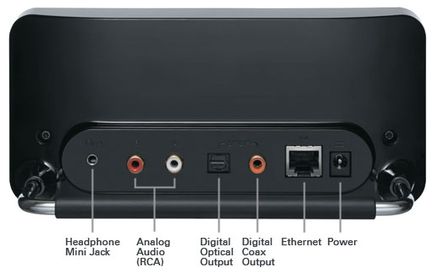
La Maison de la Domotique
Logitech® transporte la musique de votre serveur personnel vers ce "lecteur MP3 de salon"... Une solution intégrée accessible depuis une télécommande!
Plus exactement, la Squeezebox™3 est une sorte de lecteur MP3 et Radio Internet "tout en un" qui peut facilement s'intégrer au milieu de votre installation "Domotique". Dans son cas, on parlera plus volontiers de "Convergence Numérique".
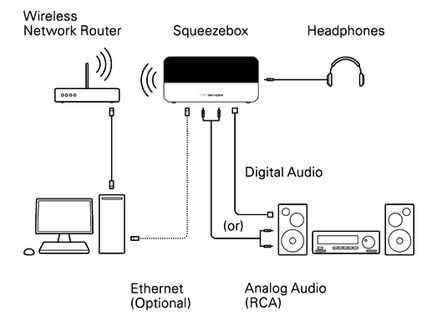
Cet appareil se substitue avantageusement à des solutions dites "intégrées de salon". Il sait tout faire en terme de diffusion sonore numérique.
C’est un relais entre votre PC et votre amplificateur qui permet de jouer, (Sans fil ou câblé), tout ce qui en provient: MP3, Webradio …Un peu le "grand frère" de l'ExSteamer en version beaucoup plus jolie et manipulable à distance, une version "Wi-Fi" du module CPL Dlan-Audio, et surtout la concurrente directe du Philips SLA5520.
La Squeezebox™3 est un lecteur "audio-stéréo" qui utilise la puissance d'un réseau informatique câblé ou Wi-Fi dans votre maison pour distribuer un signal audio. La Squeezebox™3 peut lire tous fichiers audio venant d'une radio Internet ou du disque dur d'un PC branché sur votre réseau.
La Squeezebox™3 diffuse la musique depuis votre ordinateur vers votre chaîne hi-fi, au travers de votre réseau sans fil Wi-Fi ou Ethernet - sans aucune perte de qualité sonore. Vous avez alors un accès instantané à n'importe quel morceau de musique numérique, depuis n'importe quelle pièce.
Les connecteurs numériques (RCA, optique, coaxial) et analogiques (RCA) permettent toutes les connexions hi-fi, "home theater" ou enceintes amplifiées. La Squeezebox™3 Wireless peut servir de pont Wi-Fi pour connecter un autre appareil compatible réseau via le port Ethernet.
De la taille d’un petit routeur, une vingtaine de centimètres en longueur et une dizaine en hauteur, la Squeezebox™3 est un "lecteur MP3 de salon" original qui fonctionne avec n’importe quel ordinateur, PC ou Mac.
La Squeezebox™ utilise le fameux Burr-Brown Advanced Multi-Bit 192kHz 24-Bit DAC AK4396 bien connu des audiophiles pour produire un son pur et une distorsion minimum:
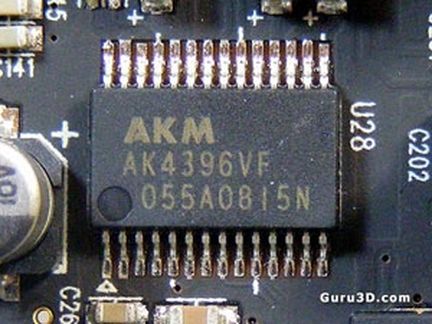
► For more information - here -
La connectique numérique et analogique permet de relier l'appareil à tout système tel qu'un home-cinéma, des enceintes stéréos ou amplifiées.
Tranquillement installé dans votre salon, télécommande en main, vous parcourez votre collection de MP3 et arrêtez votre choix sur un de vos titres préférés. L’écran très lumineux de la Squeezebox™3 de Slim Devices affiche l’essentiel: artiste, album, chanson. Une pression sur un bouton et le tour est joué, la musique sort des enceintes.
Un logiciel installé sur cet ordinateur se charge de la gestion de vos MP3 et le tout est relié au lecteur en Wi-Fi, permettant de laisser le disgracieux et bruyant PC dans le bureau ou dans un placard. Un des inconvénients de ce produit est qu’il faut un PC allumé en permanence quelque part pour stocker les MP3.
Le fabricant travaille sur la possibilité d'allumer et d'éteindre le PC directement depuis la télécommande. (Une mise à jour qui se ferait par un simple changement de logiciel). La compatibilité infrarouge de la télécommande laisse prévoir une reprise à partir d'une télécommande universelle type "Pronto" de Philips™" ou même d'une SRU9600.
Fort d'un très bon écran VFD, (Vacuum Fluorescent Display), naturellement lumineux, donc visible jusqu'à quatre ou cinq mètres, la Squeezebox™3 se fond naturellement dans un ensemble hi-fi ou "home cinéma". Reliée à l'amplificateur par un câble RCA, comme celui utilisé pour les lecteurs CD ou par une connexion numérique via une prise coaxiale, elle délivre un son remarquable.
Caractéristiques techniques
Les spécifications de la Squeezebox™3 sont strictement identiques à celles de la Squeezebox™ 2, seul le design du boîtier a été revu.
General:
• Digital and analog outputs.
• RCA connectors are gold-plated.
• Volume control is provided for all outputs.
• Multiple outputs may be used at the same time.
Analog RCA outputs:
• High fidelity Burr-Brown 24-bit DAC.
• Two dedicated linear power regulators for DAC and line-out stages.
• Full 6.0 Vpp line-level signals.
• Signal-to-noise ratio: over 100 dB.
• Total harmonic distortion: less than 0.003 %.
Digital S/PDIF outputs:
• Optical and coax digital connections.
• Dedicated high-precision crystal oscillators (no PLL, no resampling).
• Standard IEC-958 (S/PDIF) encoding.
• Optical connector: TOSLINK 660 nm.
• Coax connector: RCA, 500 mVpp into 75 ohms.
• Sample rates: 44.1 Khz, 48 Khz.
• Audio format: linear PCM, 16 or 24 bits per sample.
Headphone output:
• Standard 1/8" jack also can be used with an IR blaster.
• Minimum headphone impedance: 16 ohms.
• Total harmonic distortion: less than 0.03 %.
• Left/right crosstalk attenuation: 92 dB.
•
Formats
audio natifs: MP3 CBR/VBR,
PCM (WAV et AIFF), FLAC,
Ogg
Vorbis, WMA
(mais pas WMA Lossless)
16
bits & 24 bits / 44,1 & 48 kHz.
•
Interfaces
réseau: Ethernet 100baseT,
Wi-Fi
802.11g (support WEP/WPA/WPA2).
• Convertisseur N/A: Burr-Brown PCM1748E.
•
Mémoire
tampon: 25 Mb pour les flux
compressés
+ 28
Mb pour les
flux non
compressés.
• Sorties audio: analogiques: RCA et jack stéréo 3,5 mm
• Sorties audio numériques: RCA et Toslink.
• Télécommande: infrarouge.
Informations commerciales:
• Date de sortie: novembre 2005.
• Prix de lancement: 299/249 USD version avec/sans Wi-Fi.
Anecdotes:
À sa sortie, la Squeezebox™3 était disponible en noir ou en blanc/acier. Logitech® n'a conservé que la version noire.
Livrée à l'origine avec la télécommande standard Slim Devices, la sortie du Transporter™ sera l'occasion de revoir la télécommande.
À l'occasion de la sortie du pack Squeezebox™ Duet, la Squeezebox™3 sera renommée Squeezebox™ Classic.
Courant 2007, certaines Squeezebox™3 vendues portaient l'inscription "SlimDevices" en façade de la platine, et la marque "Logitech® " sur la télécommande.
Manuel d'emploi
► For more information - here -
Upgrade Squeezebox™ 3
I got the last capacitor for the analogue stage upgrade in the mail today, I had a couple of hours of spare time so made a start. DE-soldering of surface mount components has got to be the worst job!
It's slow painstaking work avoiding damage to pads and tracks, and this took the longest part of the job. A slight modification to the IC adapter was necessary to avoid hitting a capacitor otherwise reassembly was simple.
Plugged it in and away it went (sometimes I surprise myself!)
Nice sound immediately and I'm sure it's only going to get better once the Elna's burn in!
I was surprised how sturdy the adapter is, there was no issue plugging in the IC, so chip rolling would be extremely easy.
A worthwhile modification? Yes I think so!

► For more information - here -
Replacing a Squeezebox™3 SPDIF output
with a BNC connector

► For more information - here -
Bolder Cable Digital and Power Supply Modifications
Wherever you go there you are...
I stumbled into computer based audio by way of using an iPod as my portable music player and if you are reading this chances are you did too since Apple has upwards of 80 % of the retail market for MP3 players.
The iPod is a fantastic device for portable audio, never skips, decent battery life in the newer versions, and when fed lossless or uncompressed files and run with some decent headphones sounds very good. When I got my first iPod I was geeked and thought it would be great to have this kind of convenience of organizing music in my main system.
I quickly learned however, when hooked into my main rig for critical listening it sounded quite poor, and I could hear all its warts plainly when it was not competing with background noise in a car or plane.
I began to investigate alternative means to get files from my computer to my main system and after researching the available options I decided to purchase the Squeezebox™3 based on the fact it had a decent quality DAC, excellent display and interface, and a coax SPDI/F digital output.
At only $299 for the wireless unit it didn't seem like a big risk compared to many other components I have bought in a fit of lust and later divorced in disgust.
Squeezebox 3... Sexy tech
Initially I was planning to use the Squeezebox™ to augment a traditional disc player for sheer convenience. I have owned a few quite nice sounding units including the Ayre CX-7e, Electrocompaniet EMC-1UP SE, and Arcam CD23, and I was using a Bel Canto PL-2 feeding a Benchmark DAC-1 at the time I purchased the Squeezebox™ with satisfactory results.
I first tried using the analog outputs of the Squeezebox™ directly into my preamp, and while acceptable for background music, it did not have much life. Dynamics were poor, frequency extremes were missing, and there was a veil over the music.
I moved on to feeding the Squeezebox's™ digital output to the Benchmark and this setup showed serious promise. Music emerged from a very quiet background and lacked any digital glare nearly equaling the overall performance of the PL-2/DAC-1 combo.
When I factored in how nice it was to never have to leave my chair to change discs, the PL-2's time was up. Following it out the door of my listening room was my monstrous CD rack, no longer looming over me from the corner of my room like a tidal wave of jewel cases, and I was not sad to see it go.
Taking the Plunge
Having spent days ripping music via iTunes, I was now wed to my hard drive come hell or high water and it was time to get serious. Bolder Cable is based just fifteen minutes from my house so it was an easy decision to investigate their modification services for the Squeezebox™ 3.
Bolder offers several types of mods including extensive analog output upgrades but since I was planning to use the digital output to feed my DAC-1 I requested only the digital mods be applied.
I also purchased the Elpac regulated linear power supply that was recommended by Wayne Waananen the head honcho of Bolder Cables as they do not carry the unit, and once it arrived I gave him the Squeezebox™ and power supply to work his magic on. In the meantime I listened to my unmodified Squeezebox™ to get a good handle on its sound and prepare for a direct comparison.
The glamorous looking Elpac power supply
Wayne's modifications to the Elpac power supply include replacing the stock diodes with HexFreds, replacing the smoothing cap with a higher capacity and higher quality Panasonic, replacing the reservoir cap with a very low ESR Panasonic FM series, and adding a Black Gate NX series cap as a bypass across the output of the regulator.
Their Squeezebox™3 digital mod includes replacing many of the main input power supply capacitors and digital buffer power supply capacitors with higher value low ESR versions. BlackGate NX caps are used throughout the circuits.
The power supply cap to the digital buffer chip is replaced by a BlackGate NX and the signal path to the digital output jack is rerouted. The digital output jack is replaced with a 75 ohm, WBT NextGen, gold plated, copper RCA. I don't know what a lot of this stuff does but it sure sounds good, and the new WBT connectors are fascinating to look at.

The power supply mods will set you back $100 plus the cost of the Elpac, and the digital mods are $200 plus the cost of a Squeezebox™, both prices exclusive of shipping.
Wayne cautioned the modded unit would need some significant break-in to achieve its full potential. I found this to be true as for the first several days it actually sounded worse than the stock unit, lacking body and seeming somewhat harsh sounding. Since there are no moving parts to wear out I was not worried about leaving it on nonstop for over a week while I was out of town, and when I returned my patience was rewarded.
The unit had taken on a lushness and body that was missing in the stock unit, and the weight and extension in the bass was much improved. I am not sure if I am a bass freak since no one has ever called me that before, at least not to my face, but I do like plenty of slam and extension during my frequent excursions into industrial and electronic music.
The modified Squeezebox™ has excellent bass slam, and when I ramp up the volume on tracks like Goldfrapp's Black Cherry or Massive Attack's Mezzanine it delivers a physical as well as audible punch to the gut without loss of control or pace. Despite the increase in heft, acoustic bass and male voices were never overcooked, and overall coherency was improved.
In addition to the added low end prowess the midrange and treble gained greater aptitude and female vocals in particular became much more lifelike. Listening to Vienna Teng on Dreaming Through the Noise or Neko Case on Fox Confessor Brings the Flood, it seemed like I was listening to the performer and not a glossy facsimile as is often the case with digital sources, and the micro-dynamics of their voices came through more clearly.
The midrange balance with the modded unit in my system leans to the warm side, but this is due in part to my Aesthetix Janus with new old stock tubes as well as the DAC-1 itself which is not quite as incisive or detailed in the midrange as it is in the treble and bass.
I prefer an immersive and forward soundstage, and a pronounced midrange to mid-treble typically puts mud in my applesauce to say the least. The unmodified unit added an often times unpleasant emphasis to these frequencies, but depending on your tastes you may miss this energy on some tracks.
Personally I much preferred the more polite presentation of the modified unit which reduced listener fatigue to a non-factor. I found the "spotlight" on some instruments and vocalists was less artificial with the modified unit and the image was larger both in width and depth offering a truly engaging listen.
In the upper registers the modifications allowed cymbals, bells, and synthesizer bleeps & braps both the detail and body required while avoiding the harshness and grain of the stock Squeezebox™.
My speakers have a ribbon super-tweeter and though the sound was smoother and easier to listen to it was very evident the zenith of treble extension was raised. On material such as the new self titled release by Rodrigo y Gabriela, the sound of their fingers on the guitar strings was perfectly integrated with the sound from the guitar body instead of being a distracting discombobulated noise.
In addition the modifications lowered the noise floor allowing more air and ambience from the recorded space to be heard. I found I can now listen to many discs with a significantly lower gain and still hear all the detail and ambiance. The dreaded cliché of digital sounding "analog" is about the only thing I can say, the modified unit simply allows more high frequency detail with less fatigue than the stock unit.
So are there any other good options to get my tunes out of your PC if you don't want to spend this much dough?
I compared the stock and modified Squeezebox's™ to two other methods of feeding my DAC to ensure I hadn't just fallen for the first gadget to catch my eye. First I ran the mini optical output from my Mac Mini to the Toslink input on the Benchmark.
This setup was very lackluster at first and I was ready to give up after less than three songs, then I found you could output a 24/96kHz signal from the Mac by changing system settings. Moving from 16/44kHz to 24/96kHz was an enormous leap, and the 24/96kHz sound was very dynamic with good frequency extension and a decent soundstage.
What kept the direct toslink connection from challenging the Squeezebox™ was a digital glare manifested as an annoying harshness in the upper mids and lower treble that made listening for more than a few minutes very uncomfortable. This harshness was more pronounced than on the stock Squeezebox™, and coupled with the increased dynamics I found myself wanting to run for the door on several rock songs.
While not without significant drawbacks in sound quality this setup was the value leader as the Belden mini optical to Toslink cable set me back $14.99, however an additional consideration is a controller. If you do not have a monitor in your listening room or some other form of controller for your software player, the Squeezebox™ is clearly a simpler way to manage your library.
I utilized a PDA and the Salling Clicker software to control my iTunes without a monitor and it worked quite well, but again this is a more complex solution than the Squeezebox™ and probably not one to recommend for those who find programming a Tivo box akin to putting a man on Mars.
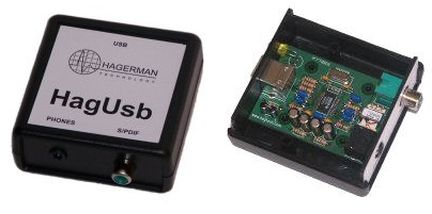
Hagerman Technology - HagUSB.
Next up was the Hagerman Technology HagUSB, a simple USB converter that outputs an SPDI/F signal. This device is quite inexpensive at $125 and can be made from kit form for even less. I found the sound of the HagUSB to be quite pleasing and it did not suffer from the harshness that plagued Mac's optical output.
On discs like Goldfrapp's Black Cherry, the synthesized noises that were grating through the Mac's output were now tamed, and the soundstage was more laid back.
The more I listened to the HagUSB however the more I found it was a bit too pleasant, obscuring detail and noticeably softening the attack and bite on many recordings. To be fair, the modified Squeezebox™ and power supply total out at over $600 while the HagUSB comes in at a fraction of that, so considering its overall musicality it could be a good option if budget is a concern or you just want to dip a toe into the PC audio ocean.
Again one consideration is how to control your music as the HagUSB is simply a conduit to get the 0's & 1s out to your DAC. For some this is no big deal, for others it is a deal breaker as mentioned previously.
After evaluating all of these options, I found the Bolder modified unit was simply more dynamic with significantly fuller bass, a musical and less fatiguing midrange, and more delicate and extended treble.
As a final hybrid test I also hooked the stock Squeezebox™ to the modded Elpac power supply and found this to give it a definite boost in dynamics and bass, but did not present the same liquidity or soundstage of the modded unit and the treble was still a bit zingy, so my advice is to go for the full digital mods.
So how good is it ?
Based on my experience with the Bolder Cable modified Squeezebox™ I would say it is a spectacular bargain when you consider the sound quality it is able to extract from your hard drive. The beauty is you likely already have a PC of some serviceable sort, and if you have a wireless network you can put the Squeezebox™ anywhere in your home and have a reference caliber transport for very little investment.
This truly appears to me to be the future of digital, and recently several very high-end hard drive based stand alone units have been introduced supporting the idea that the days of using physical discs are numbered.
Others more technically literate than I have written volumes about the potential superior performance of hard drive as a source versus compact disc due to reduced jitter, error correction, and other benefits.
It is also hard for me to fathom that I was able to replace an entire wall of CDs with an external hard drive the size of a dictionary, and a 40 pound player with a unit the size of a box of Mac n' Cheese and not lose sound quality in the process.
PC Man moves into Appleville...
I admit the main reason I bought an Apple Mac Mini is aesthetic, the thing is tiny, and it is also almost dead silent. It is also the simplest computer I have ever used and given my full acceptance of iTunes it was an easy choice for a dedicated music source.
Now for some controversy, I have ripped several discs in both Apple Lossless Compression and as uncompressed files and found I could not reliably tell the difference so to save disk space most of my collection is encoded in ALC.
This probably causes some ruffling of feathers as some feel there is a sonic compromise despite the fact that it has been proven it truly is a lossless technology, and also because others don't like being roped into using Apple's proprietary software.
Without delving into those too deep, this underlines one of the strengths of the Squeezebox™ platform, it will decode pretty much any format under the sun, and Slim Devices has provided constant firmware updates to keep up with changes or reported glitches.
For those in uncharted territory with ripping music, I have found iTunes to be the most user friendly program out there as it automatically categorizes and labels as you rip and its playlist feature is very simple to utilize (and its playlists can be utilized on the Squeezebox™).
I have used other programs on a Windows machine and although they often have more flexibility and advanced options, they are significantly more complex than iTunes for those who are not at least moderately skilled in PC geekery. No matter which path you decide to take, you will be surprised at the level of performance offered.
For anyone who has contemplated using hard drive based audio, I highly recommend the Squeezebox™3 with Bolder Cable Company modifications for the sheer ease of enjoying high quality digital music.
It is great when I have an entire evening to spend with my vinyl allowing time for thorough cleaning and setup, however I find myself now sitting down to listen to several different artists for 20-30 minutes when in the past I would likely not have due to the inconvenience of selecting discs and warming up a player.
Computer based audio is just coming into primetime for use in high-end audio and there are sure to be advances ahead, but the modified Squeezebox™ is a simple, affordable, and great sounding solution for anyone looking to break free from the shiny disc today.
By Samuel Roberts.
Positive Feedback Online.
Symétriseur de courant secteur 240 V
J'ai réalisé ce montage d'un symétriseur de courant secteur qui alimente mon ampli et ma Squeezebox™:
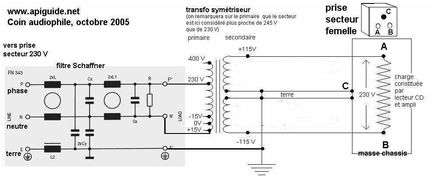
► For more information - here -
Là, c'est le jour et la nuit, la différence est flagrante. Pour 150 € environ, l'investissement en vaut la peine!
Vous trouverez cette alimentation chez Radiospare Particulier:
► For more information - here -
Squeezebox™3 with upgrades installed by Russ
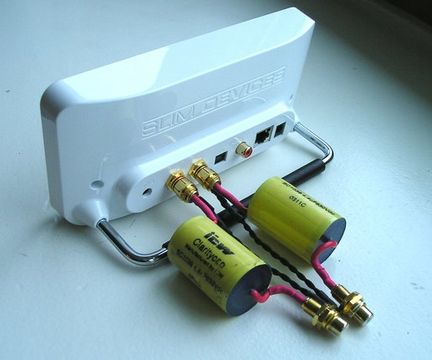
I finally got around to modding my SB3. Thanks to those who posted in this thread, especially Gary, to get me moving in the right direction. It turned out to be more of a parts removal operation. First I replaced the PS cap with a 3,900uF Panasonic FM. I then removed the op amp, the input and output caps for the op amp, and the analog RCA jacks. I installed upgraded RCA jacks and connected the DAC outputs directly to the RCA jacks.
What! No coupling caps? Well I wasn't thrilled with the option of using tiny electrolytics due to the tight spacing so I decided to go outboard with the caps. Here's what I came up with. Those are 4.4uF polypropelene clarity caps. And yes, the SB3 sounds wonderful in this configuration!
► For more informations - here -
Squeezebox™3 with upgrades installed by Audiocom
The Squeezebox™3 incorporates Logitech’s fourth generation hardware. Features and most technical specifications are identical to that of the Squeezebox™ 2. A new board and chassis design are used, as well as a new remote. With the introduction of the "Duet" Squeezebox™3 was renamed "Squeezebox™ Classic".
The stock Squeezebox™ Classic is a convenient niche product with decent mid-fi sound. There is however far greater potential available from the stock unit, particularly when used as a digital front end via the digital output to a high quality external DAC.
Our modifications focus on reducing noise input noise, providing very low noise DC regulation, minimising jitter, and improving the quality of the digital or analogue output signal.
If you are looking to maximise digital or analogue audio performance from your Squeezebox™ Classic then our range of upgrades will take it several notches up the sonic ladder.
Once upgraded the Squeezebox™ Classic the overall presentation is cleaner, more open, with a marked reduction in digital artefacts such as glare and hardening. Detailing and dynamics are improved, the music gains substance and depth with low frequencies benefiting from increased weight with the highs sounding sweeter, more natural.
Squeezebox™ Classic (SB3) products can now be upgraded with the Audiocom Superclock 4. This modification can be installed as a stand-alone upgrade or in conjunction with our level-1 or level-2 modifications.
The factory clock fitted in the Squeezebox™ players is a ‘Pierce’ type using a 74HCU04 inverter chip. This type of oscillator is simple and easy to implement but also very noisy, jittery. With jitter minimized, low to mid frequencies gain substance, high frequencies are cleaner, image focus and dynamics are significantly improved.
There are numerous setup options with the Squeezebox™, the choice of using the integrated line-out or adding a separate DAC, using the switching power supply or adding a higher grade linear, etc. We have a range of modifications to suit individual setup and budget.
SB3 /Classic Level-1 Digital Upgrade:
• Sanyo OS-CON SP for DC input bypass;
• Super-regulator 3 for 3.3V digital supply;
• Sanyo OS-CON SP regulation bypass;
• Bybee Slipstream Purifier for digital output.
SB3 /Classic Level-2 Digital Upgrade:
• Sanyo OS-CON SP for DC input bypass;
• Bybee Slipstream Purifier for DC Input;
• Super-regulator 3 for 3.3V digital supply;
• Sanyo OS-CON SP regulation bypass;
• Bybee Slipstream Purifier for digital output;
• WBT NextGen cu RCA for digital output;
• Kimber internal wiring.
SB3 /Classic Level-1 Full Upgrade:
• Sanyo OS-CON SP for DC input bypass;
• Bybee Slipstream Purifier for DC Input;
• Super-regulator 3 for 3.3V digital supply;
• Sanyo OS-CON SP regulation bypass;
• LME49720 op-amp for analogue output buffer.
SB3 /Classic Level-2 Full Upgrade:
• Sanyo OS-CON SP for DC input bypass;
• Bybee Slipstream Purifier for DC Input;
• Super-regulator 3 for 3.3V digital supply;
• Sanyo OS-CON SP regulation bypass;
• LME49720 op-amp for analogue output buffer;
• WBT NextGen cu RCA for analogue outputs;
• Kimber internal wiring.
► For more informations - here -
Squeezebox™ upgrades installed by
The Bolder Cable Company
The Statement mod upgrades the parts and circuitry of the SB's internal power supplies. The mod also removes all the stock parts from the analog section. The signal path is now run direct from the internal DAC through very high quality coupling capacitors to new RCA jacks.The output level of the signal now has a max output of 1.1 V rms down from the 2 Vrms of the stock unit.

This top level of mod upgrades the output bypass capacitor to the V-Cap Teflon capacitor. All of the internal power supplies use Black Gate caps in their "Super E" configuration. Resonance dampening material is used in critical areas.
The output connectors are changed to WBT NextGen. A Bybee Purifier is used to reduce noise.
This is the mod to get if you want the simplest signal path. The modded SB3 can be run directly into a power amp. The volume can be controlled through the SB3's internal control. There will be no loss of sonic quality, In fact, most people with this mod report far improved sound quality running direct into an amp without a preamp getting in the way.
This mod improves upon the Enthusiast level and offers even clear more natural sound the highs are extended and very sweet. The low end is VERY tight.
► For more informations - here -
Welborne Labs Squeezebox™ Power Supply Upgrade
The Logitech® Squeezebox™ has become a very popular streaming music player however it is packaged with a very wimpy and noisy switching power supply that inhibits its true potential.
Our upgrade design incorporates a tightly regulated linear power supply featuring low noise Schottky rectifier diodes, low noise, low drop-out voltage regulator chips, Ultra low impedance Nichicon capacitors and a high-current-low-noise-split-bobbin transformer (get it? it's designed for very low noise).

Our power supply measures less than 50 microvolts of ripple under full load resulting in very quiet operation with plenty of reserve current for good dynamics. Additional benefits are obtained with the use of a ceramic fuse, Vishay/Dale 1 % metal film resistors, Wima polypropylene bypass cap, heavier gauge dc power cable and a detachable ac power cord.
The sonic results achieved include a blacker background with excellent low level resolution and detail, an expanded soundstage along with deeper and tighter bass. The Squeezebox™ sounds pretty good stock, but our power supply will raise the performance to the level you demand. We're confident you will hear the improvement!

The aluminum chassis measures just: 4.25" W (108 mm) x 7" D (178 mm) x1.8" H (46 mm) and is available in red or black anodized finish. All versions accept detachable AC power cords however the cord is NOT included and must be purchased separately. We have Power Supply Upgrades for the Squeezebox Classic, Squeezebox 2 & 3, Duet and the new Touch.
Please specify below when ordering. Available factory assembled for $260.00 or kit for $205.00. The factory assembled version is warranted for a period of three years.
► For more informations - here -
Teddy Pardo Power PSU Supply Upgrade

Details
The TeddyDuet power supply replaces the small wall-wart power supply that comes with the Logitech Squeezebox Duet, and provides significant improvement in sound quality.
The design is based on the experience gained with the TeddyCap family of power supplies for Naim Audio equipment, and uses the same technology.
Sound
In general, you’ll experience more clarity, tighter bass, more detail, better dynamics, natural voices, better soundstage etc.
Performance
The small power supply which is provided with the Duet is based on a technology called Switch Mode. Using this technology it is possible to create small, efficient, and low cost power supplies. Unfortunately due to their method of operation (high frequency capacitor charging), these power supplies are also very noisy, causing degradation in sound quality. As an alternative, several after market power supplies exist which are usually based on Linear Regulators. These regulators provides an improvement over the original power supply but as can be seen on the graph below are still limited in their performance.
The TeddyDuet power supply is based on a superior regulator called SuperTeddyReg and provides a significant improvement over linear regulators.
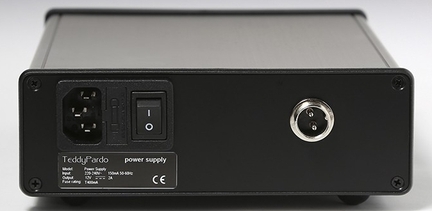
Specifications
• Power output : 9V
• Mains Supply : 110-120V or 220-240V
• Dimensions : 24 cm x 16 cm x 6 cm
• Price : 295,20 € (2018)
► For more informations - here -
2006 - Transporter™ (Without Transnav Knob)

Pour agrandir le document, cliquer - ici -

Pour agrandir le document, cliquer - ici -
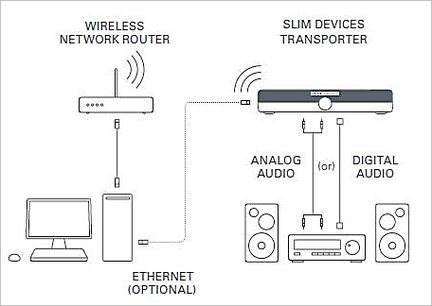
Publications
Stereophile.com
John Atkinson
Is a high-end music server the audio equivalent of polishing a turd?
I've been hearing this put-down since I first became an advocate for digitally stored audio almost five years ago. At first, the argument was that computers had no place in a listening room. Wireless music servers took care of that argument. Then the big—and valid—concern was lossy-compressed formats, but ever-cheaper digital storage made uncompressed and losslessly compressed storage a slam dunk.
Well, said the still-unconverted, you can't argue that high-end DACs don't perform better than the cents-per-thousand mass-market chips included in players and server stations. A good point, but one quickly overcome by companies like Sonos and Slim Devices, who added digital outputs to their offerings.
But when I'd mention how good my combo of Slim Devices Squeezebox and Musical Fidelity X-DACV3 sounded playing my Apple Lossless Compression (ALC) files, several of my audiopals would still demure. "Surely you're not suggesting that a $300 front-end can sound as good as your Ayre C-5xe universal player?" Well, perhaps not—but near enough to clearly be high-end, and more than enough to offer hours of listening pleasure.
I must not have been the only one hearing such comments, because Slim Devices has now conjured up the Transporter, which it bills as "streaming digital music with sound quality that surpasses even the most exotic compact disc players."
Everything about the Transporter has been designed to pacify audiophiles, from a hard-anodized chassis of "aircraft-grade aluminum" (per Slim Devices) to its backlit remote control to its component parts and, yes, DAC.
I guess some folks will still argue that a digital file, no matter how pristinely transferred and handled, is still a turd, but I guess it's all in the ear of the beholder. After all, I have a pair of cufflinks made from coprolite: dinosaur droppings that have, through the ages, become fossilized and quite beautiful, especially when treated as semiprecious stones.
In short, you can polish a turd. Properly processed, even the most unpromising material can become a thing of beauty.
The tourist transports his own values
The Transporter uses AKM AK4396 multibit/Sigma-Delta DACs and can accept digital inputs on coaxial, optical, and BNC S/PDIF, as well as AES/EBU balanced connectors. Internally, the Transporter, like the SB3 before it, carefully manages clock signals and employs special crystal oscillators and multiple stages of "super" power regulation, based on Walt Jung's designs.
A word-clock input allows the user to sync to an external clock source, and the Transporter decodes WAV, AIF, MP3, WMA, and FLAC files with 24-bit resolution at a sampling rate of 44.1kHz, 48kHz, or 96kHz.
The Transporter's CPU is a 325MIPS, eight-way, multi-threaded device with an 8MB audio buffer and SlimDSP, a software-based digital signal processor (DSP) that resides in flash memory and is loaded into fast static memory "dynamically"; ie, as needed. This isn't conventional DSP of the sort you'd find in an A/V receiver; rather, it's designed to decode compressed files on the fly so it can transmit uncompressed 24-bit PCM over the network's Wifi link.
The Transporter has single-ended (RCA) and balanced (XLR) analog outputs, as well as coaxial, TosLink, BNC S/PDIF, and AES/EBU digital outputs. Ethernet and RS-232 inputs are also included. Analog and digital signal paths are kept separate.
The balanced output remains consistent, but volume can be controlled through the single-ended outputs using a combination of digital attenuation and a set of resistor jumpers mounted on the circuit board: You set the approximate maximum volume with the jumpers and fine-tune with the digital attenuation.
If you don't need to tweak it much with the digital control, you should be able to vary the volume without significant data loss. (Because I was using the Transporter with several high-end preamps, I kept the digital attenuation off during my audition, but it's there if you need it.)
One of the slickest features of the Transporter is its huge, two-part display, which is nigh on infinitely configurable. I generally used the left side to monitor whatever data were playing, and dedicated the right side to the nifty faux-analog VU meters to monitor the output.
It was cool, if perhaps a little pointless. On the other hand, I had no need to scroll RSS feeds, weather data, sports scores, or other information across the display, so some harmless retro-visuals certainly didn't hurt.
Smack dab in the middle of the front panel is a large control knob, the TransNav, which employs dynamic tactile feedback to rapidly scroll through and choose from tons of information, including even the longest playlist.
If you don't want to operate the TransNav up close and personal, the remote control offers an equal level of domination, though it lacks the same wow factor.
What hours of transport we shall spend
The Transporter, like the SB3, is far more versatile than a survey review can cover, primarily because Slim Devices is dedicated to open source development. Company head Sean Adams is obviously an immensely talented designer, but Slim also has a fanatical community dedicated to developing plug-ins and macros for the SB3 and the Transporter.
If you desire a certain function, chances are someone else has too—and may even have created it. As Adams commented, "In a sense, with open source, we have more software developers working for us than Microsoft has thrown at Vista." Visit the Slim Devices Forums for a look at the possibilities.
Also working for Slim Devices is an unusually attentive and thorough customer-service staff. Although I had already downloaded and was running the SlimServer program on my Mac for my SB3, I had a small problem getting the Transporter to shake hands with my Wifi network.
Dan of customer service talked me through it with good humor and patience. Late in the review, my Transporter refused to power on when I moved it downstairs for a final once-over. I called the help line again without identifying myself.
Dan and I quickly tried a hard-power-on and a software-enabled power-up, and when both proved unsuccessful, he immediately said, "Let's get that bad boy back in here, so you can have it back before next weekend."
I was impressed and a little sheepish—I'd suddenly recalled an epic cat battle that had sent the Transporter crashing to the floor a few weeks earlier.
It worked after that, but I'm betting that something was loosened enough to finally lose contact when I moved the unit downstairs. My bad. Well, Huckleberry's probably, but I'm a bad cat owner for not better securing the Transporter.
Three dollars and it only transports matter?
I integrated the Transporter primarily into my main listening room's he-man rig, which included my Ayre C-5xe universal player, K-1xe preamplifier, and MX-R monoblocks, Krell Evolution 202 and Evolution 600 preamp and power amps, and Dynaudio C-4 and Vandersteen Quatro Wood loudspeakers.
All of these components are capable of highlighting minor differences, let alone compromised file formats, so I didn't bother auditioning lossy MP3s or, for that matter, Internet radio, which seldom gets above 128 kbit/s.
It's not a matter of audio snobbery, it's merely facing reality: If your digital library isn't hi-rez, you don't need a Transporter. For this reason, I wasn't particularly disturbed that the Transporter couldn't play the few files I've downloaded from Apple's iTunes Music Store.
It's true that I couldn't play them because of Apple's use of Digital Rights Management, but their 128 kbit/s quality would have eliminated them even if the crippleware "protection" of DRM hadn't already done so. The same is also true of just about any other DRM'd download I can think of—the Transporter won't play 'em and I wouldn't have wanted to.
Dreams transport us through the underside of our days
I've already explained that I had to call Slim Devices' customer support to get the Transporter up and running, but after that relatively painless introduction, my experience was pretty much set it and forget it.
Forgotten, too, were such problems as searching a multiroom, multifloor warren of music rooms for the recording I wanted to play (or refile—as if I ever worried too much about that one). If I had the recording on my music library's hard drive, it was only a quick twist of the TransNav (or a few remote button presses away.
And because I could search by artist name, album or song title, or genre, I could even find things I only vaguely remembered having, which made for a constant voyage of discovery through my own music collection.
I thrilled to the mutual pleasure that the Grateful Dead got out of their 12-zillionth for-the-first-time-ever exploration of "Dark Star," on Hundred Year Hall (CD, Grateful Dead GDCD 40202).
I marveled at the fluidity of Glenn Gould's traversals of J.S. Bach's Goldberg Variations (CD, Sony Classical/Legacy S3K 87703) late in the evening. The first thing in the morning, I had my eyes opened by Robert Silverman's incisive account of Beethoven's Diabelli Variations (CD, Stereophile STPH017-2).
And yes, beyond the effortless musicality, I was completely satisfied with the Transporter's sound. The bass was taut, the midrange unforced, the top end smooth and extended. The Transporter wasn't simply "good for what it was"; it was good.
It's far from original to observe that a satisfying audio component will send you scrambling through your record collection with a huge grin on your face, but that's what the Transporter did—only, thanks to how easy it made searching through my organized digital archive, I didn't have much scrambling to do. There was barely a slip between thought and deed.
Of course, as a hardworking audiophile, being merely content wasn't on the agenda—at least not for long—so I compared the files I'd ripped to my Apple G5 PowerMac, played through my network and the Transporter, with the CDs I'd ripped them from, played on my reference Ayre C-5xe universal player.
Hardworking indeed—I could distinguish small differences between the Transporter and the Ayre, but we're not talking night and day, just different shades of ahhhh.
The Ayre had a tad more shimmer in the upper registers, a slightly more physical presence, if you will, and noticeably more dynamic contrast than the Transporter. Was it a big difference?
Until I attempted a side-by-side comparison with the Ayre, I wouldn't have anticipated much difference—nor, I suppose, would I have noticed much if I'd rested a few minutes between the A and B portions of the comparison.
Because the Ayre C-5xe provides higher resolution than the Transporter and I make my living comparing components, I'll continue to use the Ayre as my reference. But when I'm just hanging out and relaxing, I think I'd rather spend my time listening than searching for a skootch more resolution.
Transports of joy
The more significant comparison was undoubtedly that between the Squeezebox 3 feeding an external DAC and the Transporter. While I'm sure the Transporter may convince some audiophiles of the legitimacy of networked music systems, the resistance to such systems that I've experienced in the audiophile community suggests that its more natural market might be the most discerning among the folks who already own the SB3.
I'd been using Musical Fidelity's X-DACV3 ($999) with the Squeezebox 3 ($299) in my dedicated small-speaker listening room downstairs, so I brought that combination up to the main listening room for the comparison.
The X-DACV3 is no slouch—it incorporates Burr-Brown's latest chipset, the DSD1792/SRC4192/3, which upsamples to 24-bit/192kHz. Add a Stereovox XV2 digital interconnect ($149), and the Squeezebox-X-DACV3 system costs $1447—not exactly a giant step from the $1999 Transporter.
Actually, before I tried the SB3–X-DACV3 combo, I did a quick comparison between the unprocessed SB3 and the Transporter. That didn't last long—as remarkable as the SB3 is for $299, John Atkinson was correct in his assessment of both an aggressive edge and congested soundstage (September 2006). No, to really polish the Squeezebox, you have to pair it with a quality DAC.
I know I sound like an übergeeky audiophile when I say that the Transporter set the music against a darker background, but all the differences between the Transporter and the SB3-XDACV3 system sprang from that basic difference: everything from background to foreground had less grain and noise. The signal leaped from its backdrop with far more contrast and detail.
This, of course, meant that, on the Goldbergs, I heard Glenn Gould's humming and buzzing better, too. Fair enough—it's there, and if it's there, I want to hear it (I guess). I also heard more of the acoustic in Frankfurt's Jahrhundert Halle with the Grateful Dead, which means the Transporter was more like being there.
And Robert Silverman's Beethoven sounded far more dynamic through the Transporter, which is to say it sounded much more like listening to Bob than listening to a recording.
Yes, the Transporter is worth the upgrade, even from an SB3 driving a high-end DAC. Most of the time, I would have to add a disclaimer like Of course, if you have multiple digital inputs, an outboard DAC may have more functionality—but the Transporter has extra digital inputs and convenient source switching to boot.
Beam me up!
Is the Transporter for you? I suppose that depends on your reaction to the phrase high-resolution network music player. Slim Devices practically had me at hello, but many audiophiles still resist the concept.
I believe Slim Devices has done an excellent job of defusing an audiophile's resistance. The Transporter is well-built and easy to use, contains top quality parts, and accommodates just about any kind of connection an audiophile might require.
It does an excellent job of wresting that last little bit of fidelity from your uncompressed music data. In fact, if you have high-resolution music files, such as your own 24/96 recordings, it will play those, too.
As good as the Transporter is at recovering information from your music files, however, the real pleasure of using it is in setting it up to be your music interface.
Between Slim Devices' own canny programming and its users' network of open-source programmers, you can personalize it to a greater degree than almost any other device I have ever encountered. When I look back at the clunky interface of my first audio server, it's as if the two aren't even of the same species.
Yes, the Transporter does cost $1999, a not-inconsiderable sum. However, I suspect that we have to thank our lucky stars that Slim Devices comes from the world of computers, where folks squeeze pennies until Lincoln yelps in order to preserve market share—if the company was from the high-end audio sector, there'd be a three or a four at the beginning of that price, if not an extra zero at the end. Two grand seems a fair price for what Slim Devices delivers.
Is the Transporter perfect? If you ask me, it's pretty darn close. I'm not sure I could ask for more, but I could see a market for a Transporter that offered less. Remove its DAC and source switching for audiophiles who already have a digital processor they're in love with and you might have a product that offered all things to all comers.
But what do I know? I'm the guy who was an early adopter of music networking.
I'll tell you what—if music networks are turds, the Transporter definitely polishes 'em. It makes 'em shine like crazy diamonds.
By John Atkinson, editor-in-chief of Stereophile magazine
Stereophile.com - February 11, 2007
Audioholics
Clint DeBoer
Introduction
I hate CD players. They're bulky and they typically play only 1-5 discs at a time - unless you get a CD changer and that's like getting the family pack at Krystal - it isn't about quality. We're no strangers to Slim Devices Digital Network Music Players. In fact, we've reviewed both the second and third iterations of the Squeezebox Digital Music Players.
One upgrade we asked for back when we were reviewing the Squeezebox was a more "normal" form factor that could be rack-mounted into a system and therefore allow the player to blend more naturally into a system instead of standing out like an iPod on a docking cradle… Well, Slim Devices (who was acquired this past year by Logitech) listened to me…
OK, maybe it wasn't just me, but the end result is more than I would have expected - or even hoped for - a completely tricked-out Squeezebox with dual displays, upgraded DAC, and enough functionality to serve as the true powerhouse in any "analogue-is-my-friend" system. But can this new "Cadillac" model really replace your CD player?
It's hard to compare the Transporter to the Squeezebox - it's really a completely different product and is more like a replacement for a traditional media player if you have a PC or NAS (network attached storage) device with stored lossless music files. In this sense, the Transporter now becomes a high-end DAC for your music. Check out these features:
TransNav Contoller:
This is a "force-feedback" style controller that is hard to explain except to say that it's really cool and EVERYONE should use this technology. The central knob on the Transporter that bisects the player rotates freely - until it comes to the beginning or end of a list. Then it stops…
Yeah, I don't know how it works either, but it just "knows" when to stop turning. It's so cool you'll initially come up with reasons to browse your music library just so you can make it start and stop turning. You can't fool it, it just works.
Connections:
In or out you have access to everything you would want in this type of digital network player. People begged for the ability to use the DACs with other products, like a run-of-the-mill CD player… Well, they got it.
The Transporter will allow users to connect via AES/EBU, S/PDIF coax (RCA and BNC) and even TOSLINK (EIAJ optical) and use the onboard high-quality DAC to convert digital audio to the analogue outputs. There's even a Word Clock connection for perfect sync to an external clock. Not enough? How about balanced and unbalanced analogue audio outputs, RS-232 for control via whole house systems and IR in/out ports.
New Premium Quality DAC:
Slim Devices calls their AK4396 the 'Miracle DAC' (perpetuated from audiophile forum threads that have dubbed it as such). Here's what one thread had to say about it: "All I can say to describe the sound is STUNNIGLY REAL! Extreme and refined high frequency detail is combined with magical midrange, full bodied sound and astounding bass performance." Magical midrange? That's a new one and while I'd love to take their word on it I suppose we'll still do some listening tests of our own.
What’s in the Package
Opening up the Transporter was like opening up a large iPod package. There were boxes within boxes and everything was colorful and well-labeled. Inside were the transporter, power cable, remote, two antenna's user manual and even a pair of AAA batteries.
A large orange box sported the words "free your music" - appropriate considering this device paired with a PC can result in hundreds of CDs being replaced by a single hard drive. Once you've crossed over to this method of playback then you truly have "freed" your music.
The Transporter features some hefty hardware in comparison to the Squeezebox (or any other Network Streaming Music players we've seen). Here's an overview of what you'll find inside of the chassis:
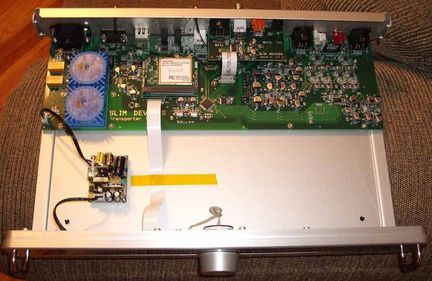
At first glance there doesn't seem to be all that much under the hood, however I'm not really an advocate of jamming in additional electronics just to make the inside look cool. The audio electronics and majority of the hefty components are kept to the back, away from the electroluminescent display components located in the front of the Transporter. Notice the physically isolated 5V power supply for the displays and CPU.
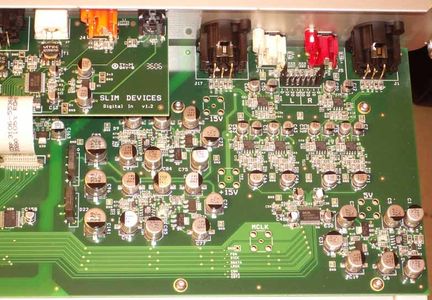
A small S/PDIF board sits atop the analogue output stage - a fully balanced system. This is where you'll see the AKM AK4396 multi-bit delta-sigma DAC (it's actually a dinky little chip for all the hoopla) and a gaggle of NE5534 op-amps. The board seems well laid out and organized.

Pour agrandir le document, cliquer - ici -
This is where the "magic" happens. The CPU and new TransNav tactile knob are located up front along with the dual fluorescent displays. Check the orange tape - no vibrations allowed… The TransNav is the first of its kind that I have ever experienced.
It is an electronically-controlled knob that can give tactile response to scolling through lists and also stop when the top or bottom of a list is reached. It also supports a pushbutton functionality to allow you to drill down further into menus. The bottom line is that you should run out to a dealer just to experience this thing - it's truly amazing and I hope it's not patented by Logitech so that we see it showing up on more products across the industry.

Here you can see the 802.11 b/g mini-PCI card with dual Wi-Fi antenna connections. Partially hidden are the dual 3.2VA NUVOTEM toroidal transformers (yes those are actually mini toroidals) in 9V and 18V configurations. These are used to step the voltage down to the appropriate level for the power supply.
SqueezeNetwork was cool the last time we tried it. This time they added the popular Rhapsody Music Service - meaning you can pull music from your Rhapsody account without having to have a PC (or push it to your Transporter or Squeezebox using the Squeeze Network web interface).
Now that's pretty cool and takes the Transporter (and Squeezebox) product to a whole other level. I was, unfortunately unable to get Rhapsody to work in my system which could well have been part of an internal networking problem. I also encountered a bit of a firmware "round robin" whereby in order to utilize Rhapsody I had to update my firmware… then when I exited to the Slim Server I had to update it again… and then again when I went back to Squeeze Network… you get the idea.
The workaround fix is to update the Slim Server software to 6.5.2 (nightly build) or do a manual edit to the Firmware/squeezebox2.version file. My guess is that by the time most people read this they'll laugh in fond remembrance of Slim Server 6.5.1.
We haven't yet seen Slim Devices enhance the SqueezeNetwork to include shared playlists, etc, but we suppose DRM might have something to do with this. It is still nice to have the ability to stream content without a PC and we like the capability it gives us to "push" discrete content to players throughout our home.
Backlit Remote Control
Hey, a new remote - and it doesn't suck! This completely redesigned remote which comes with the Transporter is unlike anything I've seen in my AV travels. It is reserved in appearance yet the backlighting makes it very elegant and high-end in appearance. It's a subtle fluorescent backlight effect - and it activates when any button is pressed. If I had my way, all of my remotes would look like this and function in near the same way.
The button layout is very ergonomic with the most commonly-used navigation falling right under the thumb. Just below is volume - and I find that I use that less frequently, but it's nice to be able to activate these controls without having to switch remotes to the Marantz PM-11S1 integrated amplifier I'm using with this system.
Located beneath this is the number pad and then 8 buttons which serve very specific purposes. Most of this has been described in my prior reviews of the Squeezebox systems, so suffice to say that Favorites, Search, Browse, Shuffle, Repeat, Now Playing, Font Size and Brightness (also triggers the firmware update function) are present.
At the top there is a Sleep button in addition to Power, standard Play Controls and an Add button. This is a nice remote and it only lacks one thing in my opinion - a direct digital input button to switch the unit into DAC mode for use with a CD player (or other) digital outputs.
With the Transporter, one of the big features you're paying for is the ability to use a nice DAC - so you can conceivably "upgrade" a CD player or other digital source component with the Transporter.
So Is It a CD Player Killer?
I'll point out a couple of things before we delve into this part of the review. First, I'd love to tell you I was using a $50,000 Pleitzkreig Zuftwaffer 6000 Esoteric Tube CD player, but I wasn't. The $1500 Denon DVD-3090CI was my reference and the goal of this experiment was to see if (in my case) Windows Media lossless music could sound as good as the 16-bit source in my 2-channel listening room.
Both devices were connected using their analogue outputs (Denon was using unbalanced), level matched, and tracks were started at the same time. A-B switching was done visibly and with my full knowledge of which source was selected at all times. My goal was to see if there were significant or even noticeable differences that were easily discernable via speakers (and later earphones) not try to conduct a double blind listening test in an effort to prove whether I could pick them apart 9 times out of 10 (I sincerely doubt I could have).
SACD Norah Jones - Come Away With Me (CD layer):
Track 2 "Seven Years" had a nice overall range of bandwidth including a nice opening of acoustic guitar with a well-rounded bottom end. It was very "live" sounding (as is the entire album) will all-encompassing low notes and distinct finger noises. Jones' vocals were typically breathy (in the good way) and I especially liked how the guitar solo had absolutely no compression or loss of top end - even when cranked in my listening room.
I kept the ripped disc running into the next track "Cold, Cold Heart" where the intro bass line and naturally reverberant vocals showed me that when picking up the Transporter, people won't be leaving any money on the table". It appeared, so far, to be completely transparently executing the duties of a "high-end" transport.
CD Riotous Brothers:
I first heard this band two weeks ago, live, at a good friend of mine's 60th birthday party (incidentally, Bruce Hensal also happened to be the guy who mastered the album). For $10 this is the best deal I've gotten on a good CD in a long time. Bruce doesn't subscribe to the "mash it until there's nothing left" theory of mastering, so the disc still has some dynamics left in it.
This UK band has Blues, Rock, Funk, and a lot of British band influences (don't know how they feel about all those labels I just threw at them of course) - all of which combine to make for one impressive band. I focused on the imaging, drums, lead guitar and impressive, up-front vocals.
Track 2 "Real Mother for Ya" is a funky tune (almost Blues Brothers meets Tower of Power but without the brass) with a nice bass groove to it. As indicated previously, I really paid attention to imaging and soundstage which remained defiantly locked in pace when I A-B'ed the two players.
Imaging and soundstage remained wide without sounding artificial or over-mixed/over-panned. I could not, despite my numerous attempts, hear a difference between the Denon and the Transporter during A-B switching.
Thanks to precise snare positioning in the mix, Track 3 "Strange Face of Love" further helped to confirm that imaging and soundstage were identical on both players.
But what if the differences are so subtle that the RBH Sound speakers and my room aren't enough to allow me to hear them? Simple, we grabbed our reference Etymotic ER4 earphones and sat back for another round of listening tests (I know, it's a tough job, but somebody's got to do it).
Folks, this reviewer couldn't hear a lick of difference between the two players. I focused in on reverb, scrutinized the male vocals, and dissected the top and bottom ends for artificial compression, tonal shifts or alterations in the soundstage. I'd have to say that I'd ditch my CD player in a heartbeat - I mean, how 80's!
CD Euphoria - Precious Time:
So are we done? Nah, I had one more CD - and even though I was pretty certain I'd still hear the same on both sources, we pooped in Euphoria's Precious Time CD and settled in for a listen. Track 2 "Blue" featured vocals by Tina Dico - who had a nice "angry white female" style voice with good texture and timbre.
I loved the vocal effects in this song and the Transporter never missed a note. This album does tend towards a "busier" mix than I typically like but there's enough varied content to make it a very interesting work. Tracy Bonham makes it onto track 7 "Precious Time" and I again compared the luscious vocals on both players.
The Transporter carried through reverb decays perfectly with no hint of the DAC taking a dump or missing anything in the translation from Windows Media lossless to its pristine balanced outputs. Simply stunning - at least for 16-bit tracks. My work here was done.
Conclusions and Overall Perceptions
Slim Devices took the world by storm with its Squeezebox series of players. Now the Transporter moves it even further ahead by ramping up the quality and adding more functionality and "pizzazz".
But is the CD player dead? Can we replace a digital transport with a supercharged DAC to decode our lossless CD content into our listening rooms? After a thorough review and dissection of the product, its functionality, and its ability to fit in perfectly with audiophile grade equipment, I have to say the answer is a resounding "Yes" - provided you don't mind having a networked computer on in your system.
This product isn't for everyone - but before you choke on the price, realize its target market and go price yourself some high-end CD players for comparison. And they don't have this cool TransNav knob… When put into perspective, the Transporter is almost a bargain - almost!
Hi-Fi+
Steven Stone
Up, Up, and Away
Setting up the Transporter is easier than setting up a Squeezebox Duet. That’s because the Transporter has a built-in expert system that leads you through the initial installation. To access your music library the Transporter requires a computer or server with Slim Devices’ SqueezeCenter software installed on it.
I mated the Transporter with a Music Vault II (reviewed in this issue) pre-loaded with SqueezeCenter, so the Transporter would have its own unique wireless network courtesy of the Music Vault. Once set up the Transporter recognized the Music Vault’s installed music library as well as my Internet radio station favorites.
During the review period the Transporter occasionally dropped the wireless feed from the MusicVault, but in every case after ten seconds it began playing the tracks again with no further issues.
I was a bit surprised that the Transporter had any connection issues since my Duet, Apple TV, and Sonos systems are farther from their wireless hubs and have never had any dropouts. One of Logitech’s technical experts suggested that the problem may not have been the wireless network interface, but the SqueezeCenter’s inability to decode Apple Lossless files fast enough. Only Apple Lossless music files had this problem, so I suspect this guess was correct.
Stock Transportation
Given Logitech’s goal of "no compromise" sonics how does the Transporter actually sound? While certainly competitive with other similarly priced DACs, it’s not about to push any state-of-the-art price-is-no-object $20k DACs off your component shelf.
The Transporter’s analog stage is exceedingly quiet. Even at maximum output, which is how I listened to it most of the time, I detected no hiss or hum even when I pressed my ear close to the speaker driver.
The Transporter’s resolution abilities were excellent, easily matching that of my reference Bel Canto DAC-3. Lateral imaging was especially precise, and depth was certainly on a par with other solid-state DACs I’ve heard recently.
However the Transporter’s depth recreation wasn’t quite as fleshed out as that of the tube-output Wavelength Brick USB DAC, whose circuit manages to add three-dimensionality to even the flattest commercial digital recordings.
Although I wouldn’t characterize the Transporter’s overall harmonic balance as harsh or bright, it does have a slightly more mechanical presentation than the Bel Canto DAC-3 on coaxial and TosLink digital sources.
The Transporter’s overall rendition was more left-brained and matter-of-fact, emphasizing the details without drawing the listener into the music as completely as the Bel Canto. Both produced excellent bass fundamentals, but at higher output levels the Bel Canto’s more robust active output stage seemed to generate more visceral low bass and dynamic contrasts.
When I compared the Transporter to the Meridian 568.2/518 combo, I noticed the Transporter’s more open and extended top end. Every musical selection had additional air and extra shimmer on flutes, cymbals, and even female vocals.
Although the Meridian combo was more musical primarily due to its richer midrange, it was also harmonically warmer and darker and rhythmically slower. Think fudge compared to white chocolate.
On my own 96/24 music files taken from live concert recordings made on a Marantz PMD-671 recorder the Transporter sonically outdistanced every other source in my system by a substantial margin.
As Gordon Holt often told me, "Software always trumps hardware." Being able to play higher-resolution music files catapults the Transporter to the top of the wireless music server (and DAC) heap. Even the Bel Canto DAC-3 sounded inferior when it played the same recordings down-sampled to 44.1kHz.
Through the Transporter the higher-resolution versions of the same music had more life, better micro-dynamics, and greater dimensionality.
The Best Way to Get From Here to There
The Transporter strikes me as a versatile product whose flexibility may be its best and worst trait. Since it can be used in more than one way—as a music server, DAC, or stand-alone digital preamp, many users may employ it in a way that prevents it from sounding its best.
Although the Transporter has a volume control that allows it to be used as a stand-alone digital preamp, this digital volume control can and will decrease the Transporter’s fidelity if it’s used for more than 10dB of attenuation.
Audiophiles who want to extract maximum performance from a Transporter should use it in conjunction with an analog preamp to control its output levels. Although you can use a Transporter as a stand-alone digital preamp, that doesn’t mean you should.
I think the ideal prospective owner of a Transporter would be someone who’s been using a $4k-to-$5k DAC that he purchased five or more years ago, and who is ready for a step up in both fidelity and ergonomic flexibility.
Combined with a Music Vault II the Transporter can form an ergonomically elegant portal into the world of digital music. The Transporter can handle all your legacy digital sources, give you access to Internet music and radio, perform as a wireless music server, and let you enjoy higher-definition 96kHz/24-bit music files. It is the only high-end two-channel DAC that can do so much for so little money.
If you are thinking of buying any $2000+ DAC you absolutely must consider a Transporter. It’s simply that good.
Écoutez Voir
Antoine Gresland
Voilà déjà un certain temps que le Logitech Transporter nourrit les discussions les plus folles sur Internet. Sans parler de ce bruit qui court autour de lui, un peu partout sur la planète audiophile: on aurait découvert l’appareil ultime, le concept à l’aube duquel tous les lecteurs réseau et autres lecteurs CD audiophiles seront comparés.
Une sacrée réputation à défendre de la part d’un appareil émanant d’un constructeur plus connu pour ses souris et ses enceintes d’ordinateurs que pour sa place dans le monde de la haute-fidélité!
► Lire la suite de l'article - ici -
Manuel d'emploi
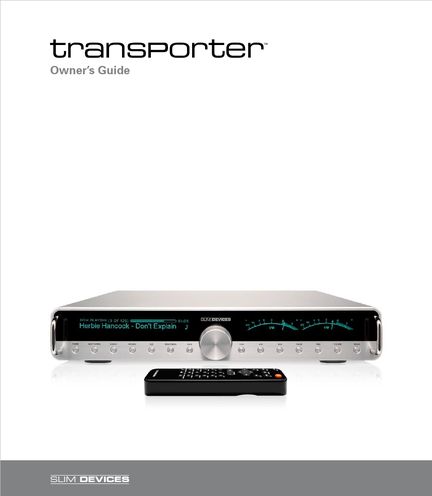
► Téléchargez le manuel en Anglais - ici -
► Document commercial édité par Logitech - ici -
Caractéristiques
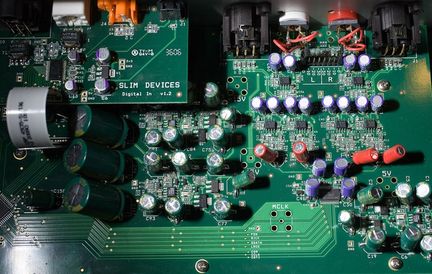
Audio Outputs:
• Digital and analog outputs.
• Gold-plated RCA, XLR, and BNC connectors.
• Volume control is provided for all outputs.
• Multiple outputs may be used at the same time.
Analog Outputs:
• AKM AK4396 Multi-bit delta-sigma digital to analog converter.
• Signal-to-noise, Dynamic Range: 120dB.
• THD+Noise: -106dB (0.00005%).
• Linear Super-Regulated supplies for DAC and line-out stages.
Balanced Analog Outputs:
• Connectors: XLR gold-plated.
• Level: 3Vrms (8.5 Vpp).
• Impedance: 100 Ohms.
• Attenuation: Fixed -0 dB.
Unbalanced Analog Outputs:
• Connectors: RCA gold-plated.
• Level: 2Vrms (5.7 Vpp).
• Impedance 100 Ohms (at -0dB).
•
Attenuation: Selectable -0, -10, -20, -30dB (Selectable via
internal
jumpers).
Digital Outputs and Inputs:
• Optical, coax, BNC, and XLR digital connectors.
• Word clock input for synchronization with an external clock.
• Linear-regulated power for all clock paths.
• Dedicated high-precision crystal oscillators (no PLL, no resampling).
• Standard IEC-958 (S/PDIF) or AES/EBU encoding.
• Optical connector: TOSLINK 660 nm.
• RCA connector: capacitor-coupled 500mVpp into 75 ohms.
• BNC connector: transformer-coupled, 500mVpp into 75 ohms.
• XLR connector: 4.7Vpp into 110 ohms.
• Sample rates: 44.1 kHz, 48 kHz, 96 kHz.
• Audio format: linear PCM, 16 or 24 bits per sample.
• Jitter (standard deviation):
• 11 ps at oscillator (intrinsic jitter).
• 17 ps at DAC.
• 35ps at S/PDIF receiver.
Audio Formats:
• Lossless Formats (Apple Lossless, FLAC, WMA Lossless).
•
"Bit-perfect" CD audio streaming, with reduced storage and
bandwidth usage.
• Approximately 2:1 compression ratio.
• Uncompressed formats (AIFF, WAV, PCM).
• Supports raw pass-through of uncompressed PCM audio formats.
• Digital passthrough to S/PDIF for DTS.
• Compressed formats (MP3, AAC, Ogg Vorbis, MP2, MusePack, WMA).
•
MPEG decoding uses MAD software, widely regarded as the most
accurate, most compatible MP3 decoder.
• High accuracy 24-bit synthesis.
• Supports all MP3 data rates and sample rates, including VBR.
•
May be streamed in PCM (raw), MP3 (transcoded), or FLAC
(transcoded)
formats.
• Sound Check and Replay Gain support for automatic volume control.
•
Some formats may require additional software installation
(e.g.
Quick-time), depending on platform.
Internet Radio:
•
"Always-on" Internet Radio, powered by SqueezeNetwork, lets
you tune
in to
Internet Radio streams even
when the home PC is switched off.
•
Quick selection from hundreds of Internet Radio streams
offered by
Slim
Devices’ partners.
• Internet Radio favorites can be saved in a playlist for easy access.
• Displays song title information during playback.
•
Support for MP3, Ogg Vorbis, and WMA formatted Internet
Radio
streams Firmware.
• Flash upgradable firmware.
• Network settings are stored in non-volatile memory.
• Auto-configuration for most networks.
• Easy setup for wireless networks.
Architecture:
• 325 MHz 8-way multithreaded RISC processor.
• "Pure software" SlimDSP™ architecture.
• Field-upgradable Xilinx CPLD.
• 64 Mb high-speed RAM.
• 16 Mb program flash.
• Low-power design, fanless.
Network: Wireless Interface:
• True 802.11g wireless networking (can be disabled).
•
Bridging capability allows ethernet devices to connect to
the network
through the wireless interface.
• Throughput up to 54 Mbps, high speed PCI interface to radio module.
• Dual external antennas for improved range and throughput.
• Supports all 802.11b and 802.11g access points.
• Automatically detects available wireless networks for quick setup.
•
Supports both WPA Personal (WPA1+TKIP, WPA2+AES) and
64/128-bit
WEP
encryption.
• Wireless radio disabled when using ethernet connection Network:
Ethernet Interface.
• True 100 Mbps throughput.
• Shielded CAT5 RJ-45 connector.
• Connects to any 100 Mbps or 10 Mbps network.
• Auto-detects full duplex and half duplex modes.
• Automatic receive polarity correction.
•
Maximum cable length: 100 meters (328 feet)
Home Automation
Interface.
•
RS-232 connector for serial integration with Crestron and
other home
automation systems.
• 3.5 mm infrared input connector.
• 3.5mm infrared emitter connector.
Power Input:
• 100-240 V, 50-60 Hz AC.
• Internal Fuse: 500 mA.
• Standard IEC power connector.
• Included IEC power cable specific to shipping destination.
Power Supply:
• Separate linear supplies for Analog, DAC, and clocks.
• Auto-ranging, relay-controlled AC input.
• Three Super Regulators for analog stages (+15, -15, +5).
• High-efficiency, low noise SMPS for CPU, Display.
• Continuous AC voltage monitoring.
• Automatic over-voltage protection.
• Low-power "deep sleep" mode What’s Included:
• Transporter Network Music Player.
• AC Power cable (appropriate plug by region).
• User’s manual.
• SlimServer software (requires download).
• Backlit 31-key infrared remote, with 2 AA batteries.
Physical General:
• Dimensions: W: 433mm H: 72 mm D: 311 mm.
• Case: Aircraft grade aluminum available in black or clear anodized finishes.
Physical Front Panel:
• Two large, high-resolution vacuum fluorescent displays.
• 640 x 32 greyscale pixels, combined display.
• Beautiful high-speed, full-screen visualizers.
• Bitmapped graphics, multiple fonts, animation, and images.
• Brightness control.
• 14 machined push buttons.
• TransNav haptic force feedback rotary encoder.

Pour agrandir le document, cliquer - ici -
Infrared Remote:
• Standard 38 Khz IR.
• Hand-held remote, 31 backlit buttons.
• Durable black finish.
•
Includes "SmartScroll" algorithms to quickly access favorite
songs
within
large
lists.
• Custom codes do not conflict with other devices.
•
Data format fully compatible with most programmable and
universal
remotes.
• Templates available for Pronto and other infrared remote controls.
• Supports discrete on/off and other "shortcut" codes.
Price:
• $1999 (2006) $1199 (2014).
Warranty:
• 3 years limited hardware warranty.
Mesures
► By Archimago - ici -
Upgrade Transporter™
ModWright Instruments
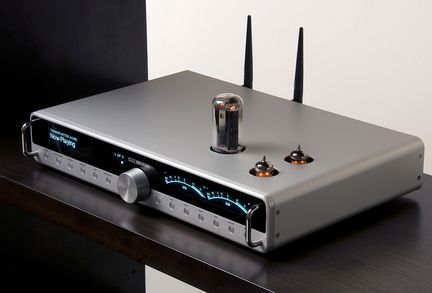
By May of '07, Dan Wright of ModWright had looked closely into the gleaming $2,000 Transporter by Slim Devices and found it "not inexpensive but pretty amazing for what it does - digital i/o ports, wireless, built-in but defeatable volume control etc. I poked around inside and confirmed my suspicion that the clock circuits and power supply regulation were quite good.
The analog op-amp stage was pretty typical however and needed attention. I was thinking tubes and no external power supply. I had a few tricks up my sleeve and believed that we could do something pretty trick with this. The AKM DAC chip was very good and had differential outputs to boot. The SMPS might need to be shielded or relocated but would remain as it supplied only basic functions and nothing in the critical audio signal path. While it was radiating some noise, shielding or relocation would address that."
By August, Dan had arrived at a single-ended Transformer platform with a single 6CG7 dual triode, an internal solid-state rectified power supply without choke regulation and a Hammond power transformer. For comparison, he used his Signature Truth Mod Sony 9100ES running on 2 x 5687s, an outboard tube-rectified power supply with choke current regulation and oversized toroidal transformer.
The transporter played back FLAC files wireless from his laptop, the Sony RedBook from its own transport and through its valve output stage. "The Sony still had the edge specifically in terms of weight, body and ultimate bass response. I believed that this could be improved if we used the oversized toroidal transformer in the Transporter with our tube-rectified supply.
We might also add a second tube for the signal path." Dan was chasing his Sony's two-box performance with a slicker integrated one-box solution. He later confirmed that his proven 36.5/9.0SE power transformer would -- barely -- fit inside the transporter without causing noise issues.
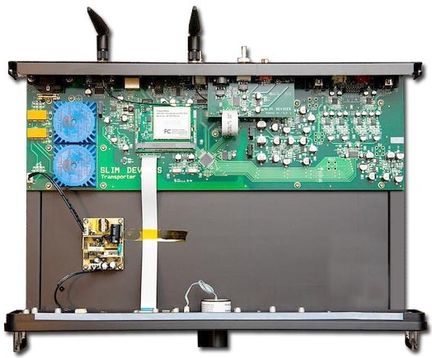
In the stock Transporter, the Wifi receiver, processors, analog and digital supplies, DACs, precision clock circuit, Jung Super Regulator voltage regs for the DAC, master clock and stock analog stage and the actual output stage all reside on a long shallow PCB that runs the full length of the rear of the unit and leaves a lot of empty real estate upfront.
Stage Two involved the big transformer and 5U4 tube rectification, still with the single 6CG7 output tube. "The next step will be to design a single board to house the power supply circuitry and output stage with two tubes to make everything fit precisely inside the Transporter. I believe that our custom Electraprint output transformers will be used to create the balanced outputs while offering a lower output impedance."
Dan decided against the 5687 of the SWL 9.0SE preamp because "I didn't feel that it was a good fit here tonally and also because I wanted to use a tube that was readily 'rollable'. The 6DJ8/6922/7308 family is compatible with the 6N1P, 6H30 and 6CG7/6FQ7 (9-pin equivalent of 6SN7) if you do it right.
Add to this a number of rectifier tube options (5U4G, 5U4GB, 5V4 and 5V4GB) and you have a lot of flexibility." The following statement really sums up ModWright's mission for their modified Transporter: "The Transporter is all about convenience, flexibility and extreme cool factor. To give this unit world-class sonics would turn it into an ideal source. It has digital inputs and digital outputs so you can use it with a computer server or laptop, CD/DVD transport, feed it XM radio or other digital sources and all will benefit from the ModWright tube analog output stage.
Building it all into one box makes it elegant, clean and allows for much greater wife acceptance factor. Heck, my wife has raised her eyebrows at it. I'd be working away on the laptop in the kitchen switching albums/tracks while she cooks dinner and doesn't understand at first but thinks it is very cool. In short, convenience is one thing and worth a lot. If we can make it convenient and high performance, then we have done our job!"
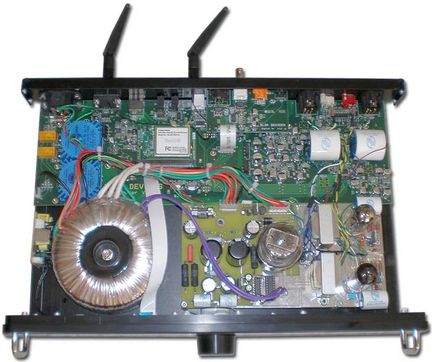
Pour agrandir le document, cliquer - ici -
With the low-power fan-less Transporter, Slim Devices upgraded their platforms of SqueezeBox 2 (Burr-Brown PCM 1748) and SqueezeBox 3 (Burr-Brown PCM1748KE) with the AKM AK4396 multi-bit delta-sigma DAC for a claimed S/N ratio of minus 106dB at 0.00005% THD and 120dB of dynamic range.
The central non-audio processor is a 325MHz 8-way multi-threaded RISC with 64MB of high-speed RAM and 16MB of program flash on Slim Devices' self-updating firmware. Network settings are stored in non-volatile memory, with "auto-configuration for most networks and easy setup for wireless networks."
The defeatable, dual-antenna Wifi protocol locks to 802.11b/g at 54Mbps and supports WPA personal, WPA2-AES and 64/128bit encryption. Bridging allows Ethernet devices to connect through the wireless interface. The RJ-45 Ethernet port offers true 100Mbps throughput and auto-detects full and half duplex modes with automatic polarity correction.
Maximum allowable Ethernet cable length is 100 meters (328 feet). An RS-232 serial port interfaces with Crestron and other home automation systems.
Upgrade Company
Stock mass-produced audio or video equipment even at the very highest price levels and magazine hype, never satisfies long term because it is contaminated with radio frequencies and low frequency electromagnetic radiation from within itself and right out of the airwaves that are all around us, unless it has been upgraded By The Upgrade Company.
The Upgrade Company provides it's clients with satisfying performance that will keep you happy for years. Finally you can get off the merry-go-round of buying and selling equipment and achieve audio nirvana.
Our "Signature Edition upgrade" for YOUR Transporter just $1099. MASSIVE sonic improvement across the board. 100% Buy Back Guaranteed
The Signature Edition upgraded LogiTech Transporter becomes a "State of the Art" 24 bit hi-rez dac that plays music from any disc transport, your computer hard drive, whether in iTunes, Windows Media Player, and/or just in a directory. It also streams from the web many hundreds of radio stations from around the world and supports Pandora, Rhapsody, Napster, and other streaming services. For audiophiles, the Transporter has decoders for WAV, AIFF, MP3, WMA, FLAC with 24-bit resolution, and 44.1, 48kHz, and 96 kHz sample rates.
The Transporter features a front panel display with control knobs and an infrared remote with dual fluorescent displays that let you select your music and control its playback from the remote or front panel. For those liking a friendlier user interface, the third-party iPeng app runs on your iPhone or iPad, connecting with the Transporter by Wi-Fi and showing album art, allowing easy access by artist, song, album, year, genre, or by search. Versions are also available for Android phones.
► For more information - here -
ASI Teknologie
The Slim Devices Transporter is a high-end music streamer with versatility and extreme sound quality. This is a perfect platform to rebuild from producing world class sound from your music file collection. We have ingeniously engineered a statement modification package that will allow you to experience the most from your music!
• Power Supply upgrades/rebuild.
• DEXA Neutron Star Flagship Reference Clock and clock PSU Upgrade:

•
Analog Output Stage Rebuild w/Audio transformers & Part
Replacements.
► For more information - here -
Head-Fi
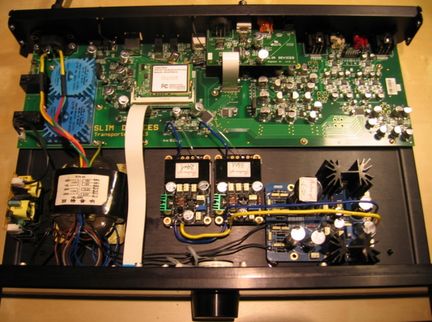
Pour agrandir le document, cliquer - ici -
My Transporter mod is done and will be shipping back to me tomorrow. Attached are two pics of the internals. The entire analog output section, DAC chips, and stock trafos have been disabled to reduce noise. An R-core trafo (taken from a Sony SCD-1) has been installed connecting up an Audio-gd power supply and 2 Audio-gd clocks.
Most of the caps have been replaced with Rubycons on both the Audio-gd boards and the Transporter board. Doug from ASI Tek has also found that mounting the parts on wood pegs works out the best for dual purposes: no ground loop issues, and easy to remove in the event you want to change the mods later. The power wire used is 16AWG OCC Copper, and the signal wire is Cryoparts SCSCag OCC silver wire.
► For more information - here -
Avis d'utilisateurs du Transporter™
•
Je l'utilise depuis 2 mois après avoir utilisé sa sœur plus
ancienne en
remplacement de mon système dématérialisé composé d'un PC
portable
dédié
sous JRiver avec DAC USB.
La
facilité
d'utilisation de ce lecteur réseau m'a vite fait oublier celle du
PC. Le pilotage via
sa télécommande est d'une aisance déconcertante à
tel point que j'ai
laissé de côté mon smartphone et ma tablette au bout
de quelques jours.
C'est donc la
version upgradée par The Upgrade Company en Signature
Edition, la plus
poussée, et au prix de 1.000 $ US.
Le transporter
avait été acheté par son premier propriétaire directement
sur Amazon
aux USA au mois de mars 2013, et directement envoyée
pour upgrade. La date
officielle de l'upgrade est du: 14 mars 2013, et il
est garanti
pièces
et main-d'œuvre durant 5 ans.
Dans ma
configuration, je l'utilise en tant que préampli attaquant
directement un
ampli de puissance.
Voici ce que je disais de la version normale sans upgrade:
Par-dessus le
marché, la qualité audio est époustouflante, bien meilleure
que lorsque
j'utilisais mon PC avec un DAC PS Audio New Wave. Plus de
présence et de
transparence, son typé analogique avec un niveau de
détail impressionnant
et très réaliste.
J'ai essayé
d'utiliser son DAC en externe en pilotant ma biblio depuis mon
PC avec JRiver,
juste pour test mais là, la qualité n'était pas la même,
notamment au
niveau de la matière et de la présence dans les voix. Ce
n'était pas
mauvais comparé au PS mais une certaine magie avait disparu.
Un son plus
stérile, si j'ose le décrire ainsi.
Pour ceux qui
désirent se mettre au dématérialisé, cette machine est un
must absolu,
loin devant tous ses concurrents même actuels, du point de
vue du son, de
l'ergonomie et de la facilité d'utilisation. La collaboration
entre SLim
Devices et Logitech a porté ses fruits. Elle était sortie à 2.000
€ mais
à ce prix-là, les audiophiles n'ont pas
suivi, ils ont préféré payer le
double voir
le triple pour des produits est ampillés "audiophiles" qui, pour
la plupart,
ne
tiennent pas la comparaison sur aucun des critères.
Logitech a donc
mis un terme à son aventure audiophile. Tant pis pour
les audiophiles
et
dommage pour les autres.
Question son,
elle reprend les qualités et caractéristiques de la version
originale avec
un surplus de transparence, une extinction des notes
encore plus poussée, ce
qui n'est pas peu dire tout en maintenant ce
côté analogique,
ample et détaillé, totalement ahurissant, de la première
version.
Pour faire mieux
avec un DAC externe, il vous faudra se lever de bonheur
et amadouer
le banquier.
Si j'avais 3.000
€, je garderai la Transporter telle quelle et achèterais un
préampli de
compétition d'occasion. Là, elle sera coriace à battre quel que
soit le DAC ou
système avec lequel elle sera comparée.
2006 - Rachat de Slim Devices par Logitech®
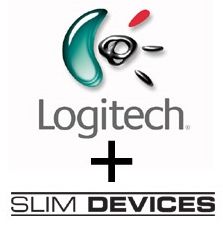
Annonce de Sean Adams de Slim Devices
2006-10-18,15:00
I am pleased to announce that Logitech® is acquiring Slim Devices, and I am glad to have the opportunity to share the news here in our forum before the official press release goes out.
We have been building a relationship with Logitech® for quite some time. As we got to know their executive team, it became clear that there was a compelling opportunity for us to work together to bring Slim Devices’ products to the mainstream market. As you may know, Logitech® recently launched the Wireless DJ music system, and also produces Harmony remote controls, which many of our customers already use with their Squeezebox™.
This is an opportunity for us to introduce Squeezebox™ and Transporter™ more quickly to a lot more people. Slim Devices will benefit from Logitech’s brand, their retail channel, their expertise in developing quality hardware, and their existing portfolio of complementary products such as speakers and remotes. Logitech® believes this will be a fast growing segment of their business, and we are looking forward to making that happen.
All of our employees have accepted new employment offers, and we will remain in our Mountain View location. Dean, Patrick and I expect to stay for the foreseeable future.
I’ll be here on the forums if you have any questions, and as always, welcome your feedback and ideas.
Best regards,
Sean Adams (Slim Devices founder)
Annonce de Guerino De Luca de Logitech®
2006.10.18
Fremont, Calif. Oct. 18, 2006 and Romanel-sur-Morges, Switzerland, Oct. 19, 2006 — Logitech® International (SWX: LOGN) (Nasdaq: LOGI) today announced that it has acquired Slim Devices, Inc., a pioneer in the development of music systems that take advantage of a home network.
Products from Slim Devices, such as the acclaimed Squeezebox™ and the recently announced Transporter™, enable people to enjoy high-quality digital music, in multiple rooms of the home, regardless of whether the music is streaming directly from the Internet, or from a PC, Mac, or storage device on the network.
Logitech® purchased the privately held Slim Devices of Mountain View, Calif. for $20 million in cash plus a possible performance-based payment, tied to reaching certain future revenue targets.
"With the acquisition of Slim Devices, Logitech® is building on our foundation of innovation in digital music and home-entertainment control to address an emerging market," said Guerrino De Luca, Logitech® president and chief executive officer. "Our focus is on people who want to listen to and control their digital music, anywhere in the home. Slim Devices brings expertise in both network-based music delivery and high-quality audio, and a committed community of developers. Slim Devices complements Logitech´s existing technology and human-interface strengths, helping to ensure that we can deliver to music lovers the promise of the digital home."
"With digital music, the convergence between PC technology and home entertainment is particularly evident," said Junien Labrousse, senior vice president of Logitech´s Entertainment and Communications business unit. "Millions of people around the world, in all walks of life, are using their PC or Mac to store their music collection — and those with broadband Internet connections are enjoying the wealth of Internet-radio content and other services. At the same time, increasing numbers of these music enthusiasts have wireless home networks that can be used to distribute the music throughout the home. Logitech® sees significant potential for network-based digital music systems that can enhance the listening experience with high-quality audio, flexibility, choice and control."
In a recent survey of online households in the U.S., conducted by research firm Parks Associates, nearly half of respondents characterized as music aficionados indicated very high interest in the ability to listen to any song, whenever they want, wherever they are, and one third of these respondents were very interested in listening to Internet or computer-based music/audio on their stereo.
According to Parks Associates Chief Executive Officer Tricia Parks, "We forecast music downloads, online radio and music-subscription services at close to $1 billion in 2006 for the U.S. alone. We forecast that amount to increase in the U.S. to over $3 billion annually by 2010. Those figures don´t even count the hardware revenues from necessary adapters and controllers. Clearly, Logitech´s timing for the acquisition of Slim Devices is excellent, just as it was for the acquisition of the Harmony remote business. This fills out Logitech´s wireless music line, and offers audiophiles interested in high-fidelity sound their own network solution."
Slim Devices was founded in 2001 by Sean Adams, serving as chief executive officer, who was joined by Dean Blackketter, serving as chief technology officer. The company has worked with the contribution of a worldwide open source community to develop the SlimServer software, which powers the Squeezebox™ and Transporter™, as well as the SqueezeNetwork, which delivers content to the devices from the Internet, without requiring a PC.
By becoming part of Logitech®, the Slim Devices team gains the advantage of Logitech´s expertise in interface-product design and amplified-audio systems, as well as marketing resources and distribution channels, which include consumer electronics retailers in countries throughout the world.
Led by Sean Adams, the Slim Devices team will become a distinct group within Logitech´s Entertainment and Communications business unit. "Slim Devices has been very successful in developing and enhancing network-based solutions for delivering premium-quality digital music and Internet radio to music lovers, thanks to our effective collaboration with our open source community," said Sean Adams. "Now we have the opportunity to leverage the marketing, sales, distribution, supply chain, manufacturing and engineering resources of a company that shares our passion for innovation in digital music and that can help us reach a wide range of mainstream customers. We´re very excited about joining the Logitech® team to continue to shape the future of digital music in the home."
Labrousse continued, "We´re very enthusiastic about broadening our development efforts with the inclusion of the Slim Devices team and one of their key assets — a committed community of developers."
Logitech®Foundation in Audio and
Home-Entertainment Control
Audio is one of Logitech´s fastest-growing businesses, growing by 112 percent in the company´s last full fiscal year, ended March 31, 2006. The growth has been driven by the increasing popularity of digital music, which Logitech® supports with award-winning, premium PC speakers, as well as a line of stylish and high-quality iPod/MP3 speakers and headphones. Logitech® is the worldwide market leader in PC speakers, and is gaining significant momentum in the iPod/MP3 speaker market.
As part of its commitment to the emerging market of wireless music systems, Logitech® recently launched the Wireless DJ™ Music System, which allows people to stream digital music from a PC to a stereo without a home network. The product includes the Wireless DJ remote, which makes it easy to browse and play music selections from anywhere in the home.
Logitech´s presence in the living room includes delivery of digital music as well as control of music and home-entertainment systems. Since acquiring its Harmony remote business in 2004, Logitech® has become the clear market leader in advanced programmable remote controls in the U.S., and the emerging leader in Europe. Distinguished by their ease of setup and use, the Harmony remotes have become widely available in consumer retail outlets throughout North America and Europe.
Impact on Current Fiscal Year
While Logitech® views the long-term potential of the acquisition to be very promising, the impact of the acquisition on Logitech´s current fiscal year is not expected to be material.
About Logitech®
Founded in 1981, Logitech® designs, manufactures and markets personal peripherals that enable people to effectively work, play, and communicate in the digital world. Logitech® International is a Swiss public company traded on the SWX Swiss Exchange (LOGN) and in the U.S. on the Nasdaq Global Select Market (LOGI).
This press release contains forward-looking statements, including the statements regarding the expected effect of the acquisition on Logitech's financial performance. These forward-looking statements involve risks and uncertainties that could cause Logitech's actual performance to differ materially from that anticipated in these forward-looking statements.
Factors that could cause actual results to differ materially include Logitech's ability to successfully integrate the Slim Devices products, technology and operations, the retention of the Slim Devices employees, and whether (and how quickly) the market for network-based music systems develops and evolves as anticipated.
For information regarding other related risks, see the risk factors section in Logitech's Annual Report on Form 20-F for the fiscal year ended March 31, 2006, and our quarterly reports on Form 6-K, available from the SEC's Edgar database at www.sec.gov and upon request from Logitech® by calling (510) 713-4220. Logitech® does not undertake to update any forward-looking statements.
Logitech®, the Logitech® logo, and other Logitech® marks are owned by Logitech® and may be registered. All other trademarks are the property of their respective owners.
La gamme Logitech®
• Squeezebox™ Duet (janvier 2008).
• Squeezebox™ Touch.
• Squeezebox™ Radio.
• Squeezebox™ Boom.
• Squeezebox™ Receiver Amplifier (Connected Acoustic - 2009).
► For more information about Logitech® and its products - here -
Le développement de la gamme avec Logitech®
Pionnier des systèmes de musique sur réseau, Slim Devices avec la Squeezebox™, bénéficie d’un atout de taille à l’heure où le CD cède le pas à la musique sur Internet. Le JDLI a rencontré au cœur de la Silicon Valley, Sean Adams, fondateur de Slim Devices.
D’où vient l’idée de la Squeezebox™ ?
À l’origine, j’ai travaillé seul sur ce projet car j’avais de nombreux CD mais je ne pouvais pas les écouter où je voulais. À l’époque, Napster était à son apogée et le CD était déjà en perte de vitesse. L’idée était de pouvoir écouter de la musique en profitant des réseaux. Avant le rachat par Logitech®, nous faisions tout nous-mêmes, qu’il s’agisse de l’assemblage ou des expéditions. Quand le marché a été suffisamment mature, nous n’avions pas la capacité de produire de larges volumes avec une bonne finition.
Logitech® commençait déjà à entrer dans le salon avec des haut-parleurs et des télécommandes. Ils avaient un produit appelé Wireless DJ et ils se sont intéressés à ce que nous faisons. 60 % de nos ventes étaient réalisées en Europe, notamment en Angleterre, en Allemagne et en Suisse qui sont des marchés sur lesquels Logitech® dispose d’une énorme expérience et d’un solide réseau de distribution. De plus, Logitech® est passé maître dans l’ergonomie des produits, mais il manquait encore une bonne interface utilisateur et un logiciel puissant. Le rachat a donc été bénéfique à tous les points de vue.
Désormais, nous sommes devenus une division à part entière qui se concentre uniquement sur ce produit.
Quels sont les avantages de la Squeezebox™ par rapport à ses concurrents?
La Squeezebox™ répond à de réelles attentes. En effet, nous avons identifié les différents types d’usage pour y apporter des réponses adaptées. Le gros des utilisateurs cherche avant tout à se débarrasser du support physique et notamment des CD. On veut profiter de toute sa bibliothèque musicale mais sans pour autant rester collé devant son ordinateur. Nombreux sont ceux aussi qui portent une attention toute particulière à la qualité du son.
Le CD a encore une bonne réputation dans ce domaine, malgré les problèmes de disques rayés ou encore des enregistrements de mauvaise qualité. Avec le numérique, il n’y a plus de lecture mécanique et donc plus aucun risque de dégradation, mais il reste le problème de la compression et de la qualité des composants. La Squeezebox™ restitue le son sans en altérer la qualité et elle est capable de lire les formats en Lossless pour offrir la meilleure qualité sonore sans aucune perte liée à la compression.
À quand la fin des supports physiques?
Nous sommes dans une phase d’ajustement. Les gens associent encore la musique à un objet physique. Aujourd’hui, le média devient invisible et il existe de nombreux modèles économiques avec le paiement à l’unité ou par abonnement. Reste le problème des DRM, dont les restrictions ne font rien d’autres que d’ennuyer les consommateurs honnêtes. Heureusement les labels l’ont enfin réalisé et les choses changent. Les radios Internet connaissent également un grand succès et les services de programmation par affinités comme Pandora sont très appréciés pour découvrir des artistes qu’on ne connaît pas forcément.
Au final, les consommateurs deviennent plus téméraires, ils découvrent de nouvelles choses. C’est la même chose pour le MP3. Pourquoi se contenter de quelques chansons dont on risque de se lasser quand on peut disposer de millions de titres accessibles immédiatement par abonnement. En fait, nous abordons actuellement la dernière phase de la dématérialisation. Les gens s’éloignent de leur ordinateur pour l’écoute mais aussi pour stocker car ce n’est ni le plus pratique, ni le meilleur endroit. L’accès direct par Internet est bien plus logique, plus souple et surtout immédiat sans nécessité d’organisation personnelle.
Comment pouvez-vous faire encore évoluer le concept?
Nous allons d’abord nous orienter vers le multiroom, c'est-à-dire permettre aux utilisateurs d’écouter de la musique dans différentes pièces de la maison. Pour se faire, nous allons proposer des produits plus adaptés aux autres lieux que le salon, notamment pour la chambre à coucher, la cuisine ou encore le jardin. Nous nous concentrons également sur le contenu. Avec Squeezebox Network, on peut se passer d’un ordinateur et nous voulons maintenant ajouter de la valeur au concept.
Il y a encore beaucoup de travail à faire en Europe, où les services par abonnement comme Rapsody sont encore rares. Néanmoins, quand de nouveaux acteurs apparaissent, nous sommes d’ores et déjà en mesure de les ajouter rapidement et c’est une caractéristique unique à nos produits. Enfin, nous sommes en mesure d’intégrer notre logiciel dans d’autres produits et nous travaillons étroitement avec les autres divisions de Logitech® dans cette optique.
Peut-on envisager d’intégrer la Squeezebox™ directement dans d’autres produits, comme un amplificateur A/V par exemple?
Certains constructeurs comme Denon proposent déjà des fonctionnalités réseau, mais cela reste basique. Nous discutons beaucoup avec eux, d’autant que notre dernier produit étant pour l’essentiel une télécommande, il est très simple de l’intégrer. Nous pouvons donc le faire assez simplement et pour un coût très contenu.
Peut-on envisager des produits avec des haut-parleurs intégrés par exemple?
C’est effectivement une demande de nos clients et cela semble intéressant. Bien entendu, je ne peux pas tout vous dévoiler, mais vous pouvez avoir une idée en consultant notre forum qui regroupe les demandes de nos utilisateurs. Ils veulent également des écrans plus grands ou encore pouvoir brancher leur équipement sur le téléviseur.
Comment rendre les produits encore plus faciles d’emploi?
C’est un véritable challenge. Même si les consommateurs sont aujourd’hui plus familiers avec les réseaux et les logiciels tels qu’iTunes, ce sont surtout les prescripteurs qui en raffolent. Il n’est pas évident d’expliquer le concept au grand public. Le mieux est de laisser le néophyte essayer et il comprend alors par lui-même. L’idée est de ne pas tomber dans la simplification qui nuirait à l’usage et demanderait l’apprentissage d’une nouvelle logique, comme en leur temps les surcouches à Windows. Il s’agit simplement de proposer une ergonomie adaptée à l’usage et qui suive celle de l’existant en musique numérique et en informatique. Aujourd’hui, une grande majorité des utilisateurs est familière avec ce type de manipulations.
Pourquoi ne pas avoir fait le choix du courant porteur en ligne en lieu et place du Wi-Fi?
Nous suivons l’évolution du CPL de très près, mais cette technologie n’est pas parfaite. En effet, bien que le CPL soit simple à mettre en œuvre, il ne couvre pas forcément toute la maison, sans même parler des problèmes de coût. Le Wi-Fi est maintenant bien implanté et les utilisateurs savent généralement ajouter un nouveau périphérique sans trop de difficultés.
Qu’en est-il de la vidéo?
Il ne s’agit pas d’un problème de technologie mais plutôt de contenu. En audio, on peut réaliser une copie de ses CD, sans oublier les catalogues en ligne qui sont déjà bien fournis. À l’inverse, il est illégal de copier un DVD et peu de services sont disponibles pour télécharger des films afin d’en profiter comme on veut. Ce n’est donc pas le même modèle économique. De plus, on ne consomme pas de la musique comme des films.
On peut écouter une chanson plusieurs fois sans se lasser ou en fond sonore tandis qu’un long-métrage, on le regarde et c’est tout. En se concentrant sur la musique, nous avons réussi à proposer un bon produit, chose que nos concurrents qui font tout n’arrivent pas forcément à faire. De plus, les marges ne sont pas intéressantes et il faut être fournisseur de contenu pour s’y retrouver. Il n’y a pas de marché pour une Squeezebox™ vidéo aujourd’hui, mais nous développons d’ores et déjà des solutions pour être prêts le jour où.
Pour revenir à la musique, l’Europe semble moins bien lotie que les États-Unis, pour quelle raison?
Il existe de nombreux fournisseurs de musique en Europe mais il n’y a pas de système de distribution unifié, ce qui rend la gestion des droits très difficile. Techniquement, rien ne nous empêche de proposer Rapsody et Pandora sur le marché européen mais les compagnies de disque ne nous y autorisent pas.
Pour le moment, il faut donc se contenter des radios Internet. Nous ne sommes pas assez importants pour imposer quoi que ce soit et nous ne pouvons pas faire grand-chose pour que les choses s’accélèrent, même si des gens travaillent dans ce sens chez nous. Il semblerait que les rapports entre le législateur, l’économie de la musique et la distribution soient bien plus complexes en Europe avec des intérêts particuliers difficiles à dépasser. Il faut donc du temps.
À quand la haute définition en musique?
Le Transporter™ est déjà adapté à la musique en haute qualité. C’est une demande forte de la part des utilisateurs qui sont lassés de la compression qui engendre une perte de dynamique. Nous sommes en mesure de supporter les formats haute définition, avec notamment le FLAC ou encore les 96 KHz. En ce qui concerne Squeezebox™, ce n’est pas à l’ordre du jour même si elle supporte le FLAC. Dans tous les cas, Squeezebox™ fait aussi bien, voire mieux qu’un lecteur de CD.
2007 - Logitech Transporter™ (with TransNav™ knob)
The TransNav™ knob provides an intuitive way to quickly scroll through lists. The knob provides force feedback to indicate individual items in a list indicate the beginning and ending limits in a list and more.
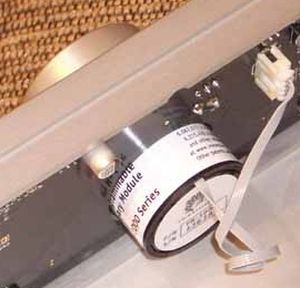
You can use the remote to make a choice, but the prominent "TransNav Knob" on the front is the way to go if it’s within reach.
You scroll through lists by rotating the knob, and press it to make a selection. Nothing special there, of course, except for two wrinkles. First, it’s speed sensitive, so the faster you twirl it, the quicker you get through the list. With this unit I have for the first time found a device that navigates through long lists better than an iPod’s click wheel. That’s impressive.
The other wrinkle is that the knob has an active clamp built in, which resists movement at the top and bottom of the list. You can twirl as fast as you like because it will stop when you get to the end. You can force your way through the clamp if you like to go directly from the top to the bottom of a list or vice versa.
Logitech Transporter™ 2009 (?) - Limited Edition (no knob)
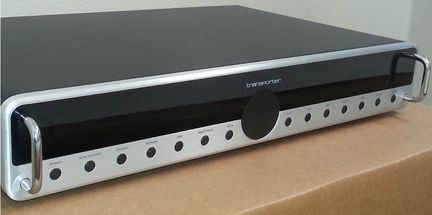
Ultime version du Transporter™ distribuée par Logitech avant l'arrêt de sa production (black or silver buttons).
2009 - Logitech® Squeezebox™ Duet
Publications
Erenumerique.fr
Stéphane Kauffmann
Système musical réseau qui vous permet d'écouter et de contrôler votre musique numérique préférée dans chaque pièce.
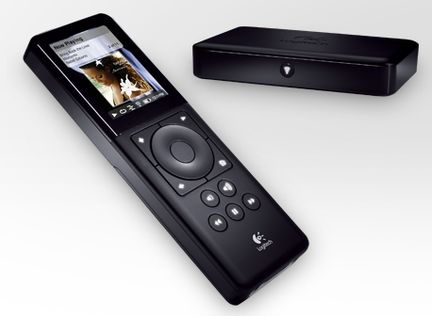
Votre musique à votre façon
Avec un lecteur Logitech® Squeezebox™, tout dépend de vos envies. Vous préférez peut-être n'écouter que votre collection musicale personnelle. Ou alors vous êtes toujours à la recherche de nouveautés. Quels que soient vos goûts musicaux et votre style d'écoute, un lecteur Squeezebox™ vous offre une liste de lecture infinie.
Votre propre collection
Que votre bibliothèque contienne 100 ou 100.000 chansons, que vous graviez vos propres CD ou achetiez votre musique à partir de services comme iTunes®, Amazon® MP3 ou eMusic. Votre Squeezebox™ vous permet de parcourir, organiser ou écouter votre collection musicale numérique n'importe où dans votre maison.
Vous avez de la musique sur plus d'un ordinateur à votre domicile? Aucun problème. Votre Squeezebox™ peut tout trouver, que vos ordinateurs fonctionnent sous Windows®, Mac OS® X ou Linux. Vous bénéficiez même d'un accès instantané à la musique que vous stockez sur votre disque réseau NAS ou sur votre répertoire de musique MP3tunes.
Tout un monde de radios Internet
Le divertissement ne s'arrête pas à votre propre collection. Vous pouvez écouter tout un monde de divertissement provenant d'ici et d'ailleurs avec votre Squeezebox™. Des milliers de stations de radio Internet gratuites vous font profiter de tous les types de musique allant de la pop grand public à des sons trop éclectiques pour la bande FM. De la musique, des talk-shows et des podcasts, vous pouvez tout écouter.
Récemment, la Squeezebox™ avait déjà changé fondamentalement la manière de consommer de la musique dans la maison mais la Squeezebox™ Duet va encore bien plus loin et propose un confort ultime pour peu que vous disposiez d’un réseau Wi-Fi chez vous.
Logitech® vient de lancer une nouvelle version de son lecteur musical en réseau, la Squeezebox™ Duet. Le principe de base est inchangé avec un lecteur connecté à toute chaîne par une classique connexion audio et branché sur le réseau domestique pour diffuser la musique qu’il puise sur le Web et sur les ordinateurs reliés.
Mais Logitech® a franchi une étape supplémentaire avec la Squeezebox™ Duet en déportant l’affichage et la réception sur la télécommande. Avec deux avantages principaux à la clef: la possibilité d’adresser plusieurs lecteurs répartis dans la maison et une commande bien plus agréable à distance. Nous verrons aussi qu’un troisième avantage qui paraît évident à la réflexion n’a pas été implémenté, du moins pour l’instant.
Si l’installation et la connexion n’ont rien de compliqué en soi, le système nécessite tout de même un certain nombre d’explications préalables qui d’ailleurs ne figurent pas dans la documentation fournie. À ce propos, si je ne suis pas pour le gaspillage du papier, le fait qu’aucune documentation complète ne soit fournie ni imprimée, ni sur CD est inadmissible.
Il faut donc commencer par la télécharger, tout comme le logiciel pour le PC. Ce n’est pas un problème en soi mais comme le guide fourni manque cruellement de détails sur l’installation et que la documentation n’est proposée qu’après avoir débuté la procédure en allant sur le site dédié, c’est franchement déroutant.
La Squeezebox™ Duet est livrée avec les accessoires suivants:
• Squeezebox™ Remote Control;
• Squeezebox™ Receiver;
• charging cradle with power supply;
• power supply for receiver;
• RCA to Jack cables;
• rechargeable Li-ion battery pack;
• Quick-Start Guide;
• 2-years limited hardware warranty.
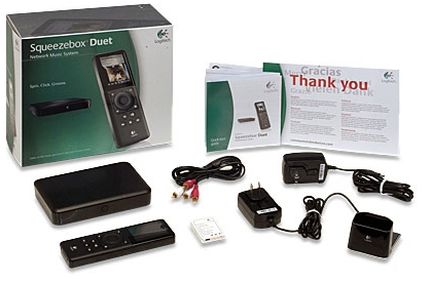
Un lecteur discret
Le lecteur fourni est simplement un petit boîtier noir très discret qui se place à côté de votre chaîne audio ou d’une paire d’enceintes amplifiées. Il s’y connecte par les traditionnelles prises cinch analogiques stéréo ou en numérique par l’optique et le coaxial.

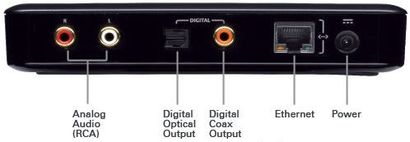
Logitech Squeezebox Duet - Receiver.
Ensuite, il se relie au réseau par le Wi-Fi G, ce qui suppose que vous soyez équipé d’un routeur point d’accès idoine lui-même connecté au Web. Le lecteur est également doté d’une prise réseau Ethernet par laquelle il peut alternativement se relier au routeur en filaire.
L’alimentation se fait par un adaptateur secteur discret livré. Dépourvu d’interrupteur, le lecteur dispose en tout et pour tout d’une LED en façade qui change de couleur selon son état.
La télécommande fait tout
En fait tout se passe sur la télécommande, magnifique au demeurant, et dotée d’un large écran LCD couleur haute résolution d’une diagonale de 6 cm ou 2,4 pouces. Elle est fournie avec un socle avec adaptateur secteur dans lequel elle se glisse pour se recharger.
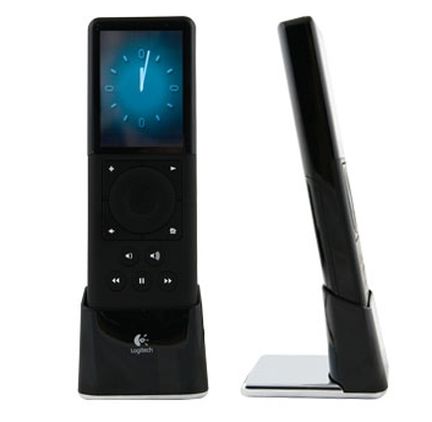
Logitech Squeezebox Duet - Télécommande bidirectionnelle.
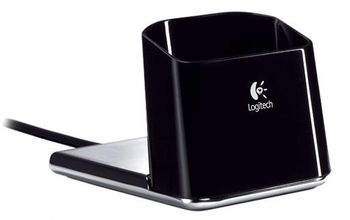
Logitech Squeezebox Duet - Chargeur de la télécommande bidirectionnelle.
C’est cette télécommande qui va centraliser les informations directement depuis le Web ou un PC et pour cela, elle se connecte obligatoirement sans fil soit à votre routeur (point d’accès sans fil), soit en se servant du lecteur comme passerelle s’il n’y a pas de réseau sans fil.
En fait, et c’est ce que vous apprend la documentation non fournie, il y a trois cas de figure pour la configuration. Première possibilité, vous disposez d’un réseau domestique sans fil en Wi-Fi doté d’un routeur point d’accès ou d’une box opérateur Wi-Fi qui fait office de point d’accès.
Par ailleurs, le lecteur n’est pas à proximité du routeur et de la box. Dans ce cas, la télécommande et le lecteur vont se connecter en Wi-Fi au réseau. Autre situation, vous disposez du même équipement mais votre lecteur est à proximité du routeur ou de la box.
Dans ce cas, il est préférable de relier le lecteur au routeur en réseau filaire par un câble Ethernet ce qui le rendra indépendant des aléas de la transmission Wi-Fi. La télécommande en revanche reste connectée en Wi-Fi au réseau.
Enfin dernier cas, vous ne disposez pas d’un réseau Wi-Fi mais juste d’un routeur filaire relié à Internet. Alors le lecteur se connecte obligatoirement par un câble Ethernet au routeur et la télécommande en Wi-Fi sans fil au lecteur qui sert de passerelle, en sachant que la connexion sera moins bonne avec une portée moindre et un débit plus bas.
Dans tous les cas pour que l’achat d’un Squeezebox Duet ait un sens, il faut que vous soyez déjà équipé d’un réseau domestique avec un routeur.
Filaire Ethernet ou Wi-Fi?
Que le lecteur soit relié en filaire (Ethernet - câble RJ45 de classe 5 ou 6) au routeur ou en Wi-Fi, dans les deux cas, tout a parfaitement bien marché. Nous avons fait des essais de distance et les règles sont les mêmes que pour tout Wi-Fi G standard.
En dehors d’obstacles inhabituels comme un mur en treillis métal, la portée est d’au moins 20 mètres sans qu’il n’y ait de problème de réception et ce que ce soit entre le routeur et le lecteur ou entre ce dernier et la télécommande. Une maison ou un appartement de taille standard devraient donc être couverts.
La connexion au réseau sans fil se fait simplement en suivant les instructions en français à l’écran de la télécommande avec le cas échéant l’entrée du mot de passe de votre protection qui peut être de toute sorte, même WPA évolué.
La solution d'une connexion par câble RJ45 classe 5 ou 6 est cependant à préférer du fait qu'elle assure une transmission des données parfaitement fiable.
Se connecter
Avant de pouvoir trouver du contenu audio sur le Web, il faut créer un compte sur Internet auprès du Squeezenetwork. Et là déjà, cela se gâte un peu puisque tout se fait en anglais. Une fois cette opération effectuée, vous pourrez accéder aux radios Internet ainsi qu’à d’autres services musicaux, nous y reviendrons par la suite.
Pour accéder à la musique sur votre ou vos ordinateurs reliés au réseau domestique, il faut télécharger une application, le SqueezeCenter. On peut trouver cette double installation un peu alambiquée et c’est mérité mais l’installation du logiciel se fait très simplement puisqu’il détecte automatiquement la Squeezebox™ Duet et scanne votre PC à la recherche de toute musique.
Et pour ceux comme moi qui détestent l’organisation Windows Media Player, il suffit d’indiquer le répertoire parent qui abrite toute votre musique. L’interface est Web et assez bien fichue mais en fait, vous n’aurez plus besoin d’y recourir par la suite. Tout ceci est compatible Vista sans soucis.
Vous voilà enfin prêt à utiliser le système. Tout va se faire par la télécommande et son grand écran très défini. Déjà, vous pourrez piloter votre lecteur où que vous soyez tant que vous êtes à portée Wi-Fi du routeur Le système de commande est un exemple de convivialité.
Les touches directes se limitent au volume et la lecture. Tout le reste passe par une molette rotative et une validation centrale plus quatre touches de navigation autour.
Ainsi pour lire de la musique contenue sur votre PC, il suffit d’aller dans votre collection musicale et de chercher par album, artiste, morceaux, etc. Ensuite, le cas échéant, la pochette de l’album et les morceaux s’affichent, vous n’avez plus qu’à lancer la lecture.
Tous les formats courants sont reconnus, y compris l’OGG Vorbis et le FLAC. Ceux qui ne le sont pas directement comme l’Apple Lossless sont transcodés à la volée par l’application PC. En revanche, pas de compatibilité avec les DRM des musiques protégées.
Mais, vous pouvez aussi aller chercher du contenu directement sur le Web. Il y a déjà une très large collection de radios avec plusieurs services comme Radio Time, Live 365, Radio IO et Shoutcast.
Le choix est donc très large et vous devriez trouver votre bonheur quels que soient vos goûts. Évidemment, toute radio peut être mémorisée en favoris pour la retrouver instantanément. Vous disposez même des services d’informations en continu comme ceux de la BBC qui s’affichent en texte à l’écran ainsi que l’accès aux podcasts.
Jusque-là tout va bien. Malheureusement cela s’arrête là aussi car les services Web les plus intéressants ne sont toujours pas arrivés en France. Les radios à la demande qui vous proposent des sélections musicales en fonction de vos goûts comme Pandora ne sont pas disponibles dans l’Hexagone.
Pis encore, un coupon Last FM est fourni dans la boîte avec la mention deux points ouvrez les guillemets "Ne fonctionne pas en France"! Sic. Et le pire est à venir. L’exceptionnel service de musique à la demande Rhapsody, qui pour 10 euros par mois vous offre trois millions de morceaux en libre accès streaming, n’est pas accessible en Europe pour des histoires de droit.
Le seul service intéressant a priori est MP3 Tunes qui permet de mettre votre musique sur un serveur en ligne pour y accéder sans PC. Mais avec une connexion ADSL standard, cela prend des années si vous avez une collection conséquente, autant y accéder par le PC.
Tout ceci est donc assez frustrant. Pour plus de détails, relisez notre article sur la Squeezebox originale. En revanche, la qualité de restitution audio est excellente et ce quelle que soit la connexion utilisée.
Un confort optimal
Reste l’accès à la musique de vos PC et aux radios Internet en attendant que Logitech® trouve un jour un accord avec un service de musique à la demande dans l’hexagone (Dezeer depuis juin 2010). Et surtout, il y a l’exceptionnelle ergonomie de la télécommande.
C’est un plaisir de tous les instants que de se balader dans sa bibliothèque musicale ou de chercher une radio, et surtout de le faire sans se soucier de la proximité avec le lecteur. L’ergonomie n’est d’ailleurs pas sans rappeler celle de l’iPod, une référence donc.

Anecdote de traduction approximative amusante, l’aide à l’écran de la télécommande appelle la molette le bidule. En attendant, le bidule est diablement efficace pour chercher et l’aide l’est tout autant.
Le réel intérêt de ce système par rapport à la Squeezebox originale et outre le confort accru, c’est de pouvoir piloter plusieurs lecteurs qui vous sont vendus en option pour la somme de 129 euros (décembre 2010).
Mais vous pourrez alors adresser chaque lecteur avec la même télécommande pour restituer la même musique ou une autre et ainsi vous créer un système multiroom vraiment fabuleux. Il est même possible de multiplier les télécommandes.
Il est également possible, dans la limite de la portée Wi-Fi entre le récepteur et la télécommande, d'utiliser celle-ci comme un baladeur, puisqu'elle dispose d'une prise jack 3,5 mm, pour ce faire:
1) écran d'accueil > Avancé > Fonction bêta > Lecture audio > Activer la lecture (BETA)
2) écran d'accueil > Sélectionner une platine > Controller
À noter un bug lorsque l'on revient à la platine dédiée, le HP de la télécommande est toujours activé. Solution: éteindre et allumer la técommande.
Conclusions
Avec la Squeezebox™ Duet, Logitech® a réussi le système de lecture musicale en réseau le plus sophistiqué qui soit avec il est vrai une ergonomie exceptionnelle à la clef, et un prix de 269 € en décembre 2010.
Depuis le 16 juin 2010, Deezer poursuit son développement sur le terrain de la mobilité et du multisupport en s’associant à nouveau avec Logitech®. Il est désormais possible de retrouver, à travers l’abonnement Deezer Premium (4.99 €/mois), toute l’offre Deezer sur toute la gamme Squeezebox™ de Logitech®.
La Audio File - January 2009
Kevin Nakano
Logitech leveraged their ability to stream audio to customers with their acquisition of Slim Devices two years ago. The Squeezebox™ Duet enables users to stream their favorite audio content from their personal collection, online services (Pandora and Rhapsody) and thousands of Internet radio stations.
The system supports a wide variety of non-DRM content including compressed formats (MP3, AAC, Ogg Vorbis, MP2, MusePack, WMA) and uncompressed formats (AIFF, WAV, PCM). Play songs stored on your computer, tune in to thousands of Internet radio stations, or connect to online services such as Pandora® and Rhapsody®. On the downside, the Squeezebox™ Duet cannot play music stored on a NAS (Networked Access Server) where all of my music is stored.
Instead, the Squeezebox™ Duet must connect to a PC running SqueezeCenter software or to third party music storage companies such as MP3tunes.com music locker making it possible to listen to your personal music collection without turning on your computer.
Squeezebox™ Server (serveur qui pilote l’écosystème Squeezebox sur le réseau local. Il a changé plusieurs fois de nom: Slimserver, Squeezebox Server et maintenant LMS: Logitech Media Server)
Squeezebox™ Server is the music server that runs on your computer and connects your Squeezebox™ players and controllers to your local music files, as well as allowing you to use third-party plug-ins (applications that extend the features and functions of your Squeezebox™).
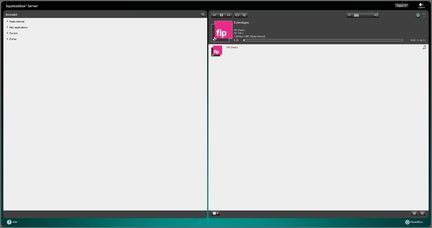
Copie d'écran du Squeezebox Server - Diffusion de FIP.
If you’re planning to use your Squeezebox™ Duet only to listen to Internet radio and online music services, or if your music is stored in an MP3tunes music locker, you are not required to have a PC running this software. Currently, MP3tunes music locker storage space is limited to 2GB for free. Larger storage space is available for an additional fee. We tested the Squeezebox™ Duet running SqueezeCenter on our media server PC.
Handheld
The handheld controller that come with the Squeezebox™ Duet has a rechargeable Li-Ion battery and measures only 6-1/8" tall, 2" wide and 0.75" deep. The remote sits in a cradle that not only makes it easy to find, but also keeps the controller charged through the two contacts at the base. A beep can be heard when the remote docks to the base confirming a good connection with the charger.
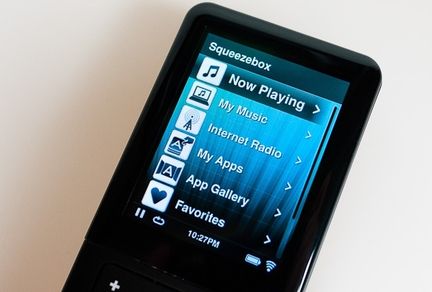
The menu options from the home screen.
The buttons on the remote have a tactile feel and the rotating wheel around the center select button is a nice touch. Just below the navigation keys are the volume buttons and the forward/reverse and pause buttons. The 2.4-inch color LCD screen is easy to read and provides plenty of information about the artist, album, song, and track.
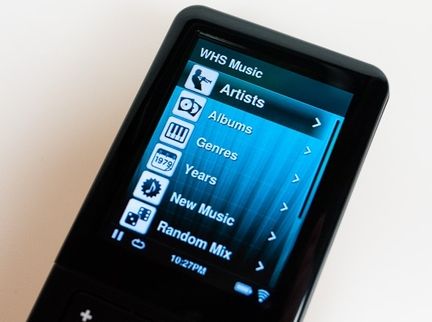
Browsing into the my Music menu item.
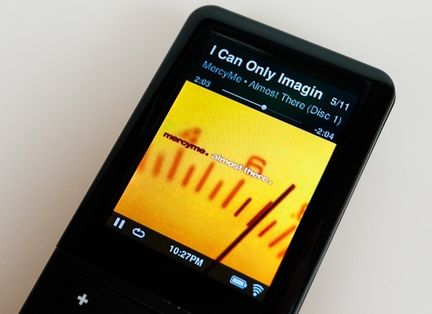
The Now Playing view; album art, album name, track number, song name,
song progress, time, battery life, Wi-Fi connection, play/pause status,
and repeat on/off...a lot of information at a glance!
Album cover art is also displayed. At the base of the display, the handheld has indicators for playback mode, signal strength, battery level, and time. Once the handheld goes into standby mode, the display becomes a real-time clock, which can be a useful feature.
Base Unit
The base unit is small measuring only 6-1/4" wide, 4-1/4" deep, and 1-1/8" tall. There is not much to see on the front panel except for the Home button located in the center This button is used to reset the unit and provides visual feedback to the user. A blinking red indicator lets the user know the unit is resetting. Once the color turns white, the unit is connected to the network.
Interfaces
The rear panel of the Squeezebox receiver has a wired Ethernet interface. The unit also supports 802.11g Wi-Fi for those with wireless networks. Both coaxial and optical (Toslink) digital connections are provided along with analog stereo outputs.
The receiver immediately recognized our SSID on our wireless network and we were prompted to enter our password for access. We tested both the wired and wireless connections to this unit. We also connected the analog audio as well as the Toslink output connected to our Denon AVR-5308CI A/V receiver. The universal power adapter can run from 100-240VAC, 50-60Hz making it compatible around the world.
Performance
The Squeezebox™ Duet produces excellent sound quality thanks to the 24-bit DAC and sophisticated audio rendering technology. We maximized our bandwidth by using a wired Ethernet connection to the base receiver. However, it is just as easy to use a wireless link if this is more convenient.
We did experience some lag time between button presses when using the wireless connection, but this may be completely dependent on the type of wireless hardware you have installed in your home or office.
Once our system was setup, we were able to stream our music content seamlessly to our audio system. I particularly like the controller and the display, which provides nice feedback to the user. The lightweight and ergonomic design makes listening to music or Internet radio stations simple and easy.
I was somewhat surprised just how good the lower bandwidth radio station sounded on this system. In many cases the audio was running at a paltry 20-30 kbit/s, yet sounded much better than other low bitrate recordings I have heard. Both analog and digital interface sounded quite good.
Conclusion
The Logitech® Squeezebox™ Duet ($359.99) is a great way to get music streaming in your rooms with the convenience of a user friendly handheld remote. The system is easy to setup and provides excellent sound quality from good source material.
Internet radio and other lower bandwidth sources will have slightly less audio quality, but can only be discerned on higher quality audio systems. The style, build quality, and features offered with the Squeezebox™ Duet certainly justifies the price. Few products are available with the convenience offered with the Squeezebox™ Duet.
Most of the systems we have seen are significantly more expensive such as the Sonos Music System we reviewed last year. If you are looking for a way to distribute music or Internet radio in your listening space and want the convenience of a remote with a cool display, you owe it to yourself to check out this product.
Manuel d'emploi
► For more information - here -
Caractéristiques
Squeezebox™ Controller:
• Écran couleur LCD TFT 6 cm (2,4") avec rétroéclairage.
• Convertisseur 24 bits haute-fidélité Wolfson.
• Prise casque stéréo (mini-jack 3,5 mm).
•
Compatible
avec les fichiers musicaux
MP3, AAC, WMA, Ogg,
FLAC,
Apple
Lossless,
WMA Lossless et WAV.
• Batterie rechargeable au lithium-ion.
•
Technologie
sans fil intégrée
(802.11b/g) pour accéder à la musique
de
votre ordinateur via
SlimServer ou la radio Internet et des services
musicaux via
SqueezeNetwork.
• Compatible avec le site de diffusion musicale en ligne Deezer.
• Compatible avec la Squeezebox.
Voici quelques informations très techniques sur les possibilités offertes par la nouvelle télécommande Wifi de l’ensemble Squeezebox Duet avec écran couleurs. Il semble donc que l’on puisse aller très loin en faisant contrôler à cette télécommande autre chose qu’une Squeezebox. Merci à ce lecteur fidèle de Multiroom.
Quelques précisions sur l’intérêt que revêt la télécommande de la Squeezbox Duet. Elle est équipée d’un Linux (2.6) et le kit de développement est complètement ouvert, il s’agit de Jive pour la partie motorisation et SDL pour la partie graphique. La couche de communication est Wifi et le protocole d’échange est hyperstandard puisqu’il s’appuie sur JSON.
Cela signifie que tout un chacun, ayant envie de développer, peut désormais apporter sa contribution à l’interface, au moteur de traitement (a priori) de cette télécommande ainsi qu’aux bricoles échangées entre cette télécommande et un serveur (qui par défaut est la Slimbox mais qui peut être tout autre chose, partant). Enfin, une innovation dans ce domaine: l’ouverture! De quoi la personnaliser...
Squeezebox™ Receiver:
•
Connecteurs
audio numériques (optique
et coaxial);
et
analogiques
(RCA stéréo).
• Convertisseur 24 bits haute-fidélité Wolfson.
•
Compatible
avec les fichiers musicaux
MP3, AAC, WMA, Ogg, FLAC,
Apple
Lossless,
WMA Lossless et WAV.
• Technologie sans fil intégrée (802.11b/g).
• Port Ethernet 10/100 Mbps.
•
Connexion
au logiciel SqueezeCenter
pour accéder aux bibliothèques
musicales des
ordinateurs locaux.
•
Connexion
au SqueezeNetwork pour
accéder aux stations de radio et
aux
services
musicaux en ligne.
• Compatible avec le site de diffusion musicale en ligne Deezer.
Configuration requise pour PC:
• Windows 2000, Windows XP ou Windows Vista.
• Pentium 733 MHz 512 Mo de RAM 80 Mo d'espace libre sur le disque dur.
• Réseau familial Ethernet ou Wi-Fi (802.11b/g/n).
• Connexion Internet requise (mini 4 Kbit/s en débit descendant).
Configuration requise pour Mac:
• Mac OS X (10.3.5 ou version ultérieure).
Avis d'utilisateurs de la Squeezebox™ Duet
•
Vous indiquez dans ce test qu'il
n'est
pas possible d'utiliser la
télécommande (Squeezebox™ Controller) comme
"baladeur MP3". Il
convient de rétablir la vérité: depuis la version
7.3 de SqueezeCenter
(devenu SqueezeboxServer), il est tout à fait
possible d'utiliser la
télécommande pour écouter de la musique avec un
casque.
Signé: un utilisateur de Squeezebox™ comblé...
•
Ce produit était fait pour moi! Il me
permet de stocker toute ma
musique et de
l'écouter sans allumer mon
ordi. Toute la musique du
monde
m'y est accessible, je peux même
regarder mon Facebook sans
utiliser mon portable.
•
Il
est important de
bien paramétrer son compte afin d'utiliser au
maximum tous
les services
proposés. La télécommande s'utilise comme
un
"Ipod" et est très simple
d'utilisation. Ce produit est révolutionnaire
vous
ne serez pas déçu...
• Après quelques jours d'utilisation, je suis conquis par:
•
la qualité sonore avec un gros "tampon" fait qu'il n'y a pas
de
coupures (cf. le débit
Wi-Fi de
votre réseau domestique ou le débit
Internet du
site auquel vous êtes
connecté);
•
la
bonne convivialité (8/10) du menu, paramétrable, de la
télécommande;
• la réponse exacte à mes besoins.
•
Un très bon produit qui permet
d'approcher la hi-fi du futur.
L'installation est
relativement aisée à
condition de trouver le mode
d'emploi sur Internet grâce
à la
bienveillance des internautes qui m'ont
donné
l'adresse Web, ce qui est inadmissible pour une
marque tel que
Logitech®
.
La
qualité est
excellente à partir d'un serveur Nas notamment le synology
207
+ ou
nouvelle génération surtout si la musique a été enregistrée soit
en
FLAC soit en AIF, le tout reproduit sur des Quad ESL 63. La
Squeezebox a une
sortie un peu faible comparée a une sortie de DAT ou
minidisc
bien que
branchée directement en optique sur le CD numérique
Quad.
La qualité musicale est au rendez-vous et il est très
difficile de faire
une différence entre un cd et le système
Logitech®.
J'ai enlevé une
étoile
à cause
du mode d'emploi.
•
Je ne vais pas en faire des tartines
...
Connectée à un NAS Synology DS209J en Wi-Fi sur mon réseau
(Linksys
WRT54G) la Squeezebox est branchée sur mon Home cinéma à
l'étage.
Radios
internet, Deezer, musique du NAS c'est que du bonheur! Le
forum Synology apporte toutes les infos pour faire
vos branchements
de
la
Sqeezebox en mode NAS (sinon il faut garder le PC allumé pour
profiter de ses morceaux de
musique).
Bref c'est 5 étoiles - mais
attention il faut quand même connaître un
minimum l'informatique pour
réaliser ce type de connexion.
•
Je dois avouer que depuis quelques
années, je "faisais avec" ma chaîne
Wi-Fi, obligée de naviguer dans des
répertoires informatiques quasi en
aveugle, au moyen des boutons d'une
télécommande siglée
"multimédia" et
non "informatique". Mais bon, je
lui pardonnais, au moins
je
pouvais écouter mes fichiers MP3 à la fois
depuis un PC, mais aussi sur
la
chaîne qui dessert musicalement le
salon et la cuisine. Et tout le
monde
le sait, les MP3,
c'est quand
même génial, surtout quand on a
des
enfants qui n'ont pas
compris des principes de base, genre:
•
Les CDs, c'est joli, on
se voit
dedans, mais ça fonctionne beaucoup
moins bien
après avoir joué avec.
•
Et encore moins bien quand on a marché dessus. Même si on
fait
moins
de 15
kilos.
•
Et puis ce n'est pas utile d'essayer d'en mettre le plus
possible en
même temps dans
la chaîne.
• Surtout si on les introduit sans ouvrir les plateaux de chargement.
•
D'ailleurs,
tous les retirer des boîtes pour faire des
piles par
couleur,
ce n'était vraiment
pas une bonne idée.
Et
puis cette chaîne, finalement, à
force de m'arracher les cheveux en
naviguant dessus à grand-peine (je
ne suis pas non plus d'une patience
légendaire, c'est vrai), j'avais
fini par arrêter de m'en servir. Au point que
la chaîne hi-fi SONY de
ma jeunesse avait récemment réussi à retrouver
subrepticement le chemin
du salon. J'avais même exhumé mes CDs du
coffre dans lequel je les
avais rangés, hors d'atteinte de mes enfants. À
moi
la musique facile,
j'introduis un CD, bouton PLAY, et hop!
Mais
l'Homme ne l'entendait pas de
cette oreille, et j'ai vu apparaître sur
ma chaîne une petite boîte
noire, accompagnée de sa télécommande
avec écran LCD. Et c'est tout
bonnement génial!
Le
p'tit plus, c'est que la
télécommande (c'est du 802.11b/g, donc pas
besoin de la pointer ou même
d'être en vue du boîtier!) affiche le titre
en cours,
le temps
restant,
la pochette associée. Le boîtier se branche
sur l'entrée AUX de n'importe quel appareil
multimédia
pour profiter de
ses enceintes, et
se connecte en Wi-Fi ou en filaire Ethernet pour aller
piocher dans
votre
stock de fichiers. Sans serveur, ou sans ordinateur
d'allumé,
il reste
toujours la solution de se connecter à de la musique en
ligne...
Je
l'avoue, les radios Internet m'ont
aussi bluffé, d'autant plus que par
chez nous, le réglage de la réception
d'une radio est très aléatoire. Alors
que les radios Internet,
globalement, qu'il souffle, qu'il vente, qu'il pleuve
ou que les
petiots aient déplacé l'antenne pour la mille et unième fois,
elles s'en fichent.
J'adore le progrès...
Upgrade Logitech® Squeezebox™ Duet
Lampizator
Lukasz Fikus - Pologne
• Modification recipe for Squeezebox a'la Fikus.
• S/PDIF generator.
• Lampized Squeezebox.
• Upgrading Analog output of Squeezebox.
• Upgrading power to the Squeezebox.

Implantation d’une nouvelle horloge maître sur le récepteur de J-R.
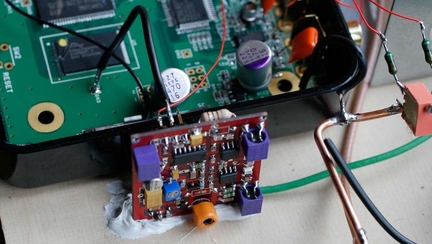
Autre modèle d’horloge maître, côté face.

Autre modèle d’horloge maître, côté revers.
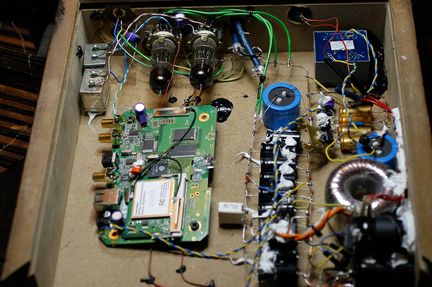
Pour agrandir le document, cliquer - ici -
Logitech® Squeezebox™ Duet - Transport par Lampizator

Pour agrandir le document, cliquer - ici -
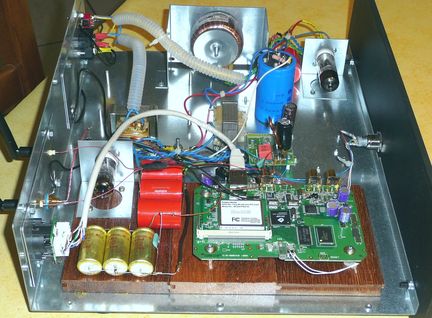
Pour agrandir le document, cliquer - ici -

Pour agrandir le document, cliquer - ici -
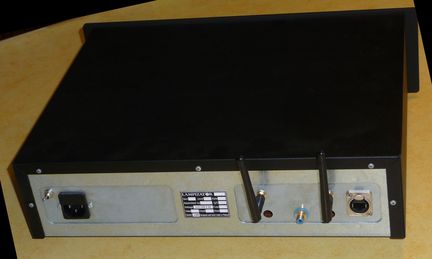
Pour agrandir le document, cliquer - ici -
► Squeezebox Fetishist's corner - here -
► Welcome to LampizatOr - here -
Squeezebox™ Duet upgrades installed by The Bolder Cable
The Logitech Duet is the newest network music player to come from the folks who gave us the SqueezeBox.

The Bolder Cable Company - Duet full mod.
Here is a quote from a recent review on the Website "Computer Audiophile":
"The stock Duet is a convenient niche product with decent mid-fi sound. The Bolder Cable modifications take that sound up a notch or two by squeezing every ounce of performance possible from the device. Simply put, if you like the Duet now you'll like it even more with the Bolder mods. In fact the Duet with Bolder Cable Company modifications may rival the more expensive Logitech Transporter."
We have come up with some changes to the internal parts that we feel improve the sound.
This mod replaces the reservoir power supply capacitor with one of higher quality. The output coupling capacitors are replaced by a blend of BlackGate and Sonicap Gen2 caps. Upgrades are available using Sonicap Platinum or V-caps. The output connectors are replaced with Cardas RCA with the option for WBT NextGen RCAs.
We also remove everything in the digital signal path and run a 75 ohm coax direct to a WBT NextGen RCA.
We have improved the mods based on our work on the RE-BOX project.
We are now improving the power supplies for the clock and DAC chip circuits.
The mods will improve the dynamics, lower background "noise" levels and extend both the low and high frequencies with more detail.
We do suggest you also replace the stock switching power supply with a linear power supply.
Squeezebox™ Duet upgrades installed by Leo
The next stage was some internal mods, the first round is going to be basic stuff easy for most to try if they wish, nothing new here Heres the standard Duet pcb. First thing was to replace the filter cap on the input DC socket, the standard one is a general purpose SMD type which is probably next to useless especially if using the external SMPS, I replaced it with a Oscon, any low ESR should be ok here, stability using low ESR in this position was fine.

► For more information - here -
TVC Audio (France)
Sur son site, TVC Audio propose 2 modules à intégrer dans le Receveir: le premier pour le remplacement de l'horloge, et le deuxième pour l'intégration d'une sortie SPDIF, visant à:
• une meilleure isolation galvanique;
• une impédance constante avec une connectique BNC;
• une sortie SDIF qualifiée en terme de bruit de phase;
• un changement de l'amplificateur de sortie.

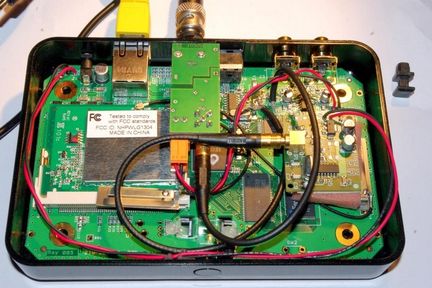
► Squeezebox Duet sur le gril - ici -
La Squeezebox™ Duet objet de collection?
Peut-être, car depuis mai 2011, Logitech en a arrêté sa fabrication....
Transformez votre Smartphone Android 2.1.
en télécommande de vos Squeezebox!!!
L'équipe Squeezebox avait présenté en mars 2011 l'application Logitech Squeezebox Controller pour votre téléphone ou tablette tournant sur Android 2.1. Avec cette application gratuite qui n'est plus disponible sur Google Play, vous pouviez contrôler chacune de vos Squeezebox depuis votre téléphone portable.
Cette application fonctionnait comme le Squeezebox Controller™ de la Squeezebox Duet™ et ressemblait à la Squeezebox Touch™. Vous pouviez choisir, jouer, et gérer n'importe quelle station de radio internet ou morceau de musique que vous possédez. Comme l'application utilisait le Wi-fi ou la connexion 3g/4g de votre téléphone ou tablette, vous pouviez contrôler chacune de vos Squeezebox:
• Squeezebox Classic™;
• Squeezebox Duet™;
• Squeezebox Boom™;
• Squeezebox Radio™;
• Squeezebox Touch™;
• Transporter™.
L'application fonctionnait selon le paramétrage de vos Squeezebox™, dans toutes ces configurations:
• connecté uniquement à Internet;
•
votre collection musicale sur Squeezebox Serveur™ 7.5.3 ou
plus
tournant sur
un pc ou MAC;
• une combinaison des deux.
C'était une application pour contrôler et non un lecteur, vous ne pouviez donc pas écouter votre musique sur votre téléphone ou tablette avec cette application.
Cette application fonctionnait sur tout téléphone ou tablette tournant sur Android 2.1 et plus, avec une résolution d'écran de 320 x 480. Connection Wi-Fi requise. L'équipe Squeezebox prévoyait d'offrir le support pour d'autres téléphones et tablettes à l'avenir.
► Application similaire gratuite sur Google Play : Squeezer - ici -


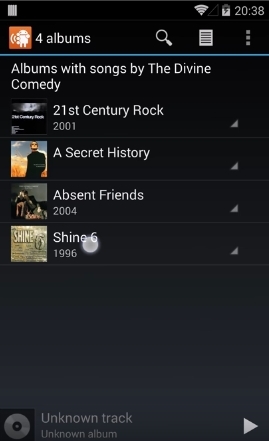
Transformez votre P.C. en Squeezebox!!!
Depuis cet été 2011, il est possible de transformer son P.C. en Squeezebox, en installant sur celui-ci le programme SqueezePlay de Logitech (version Beta au 11.08.2011), qui offre après l'avoir installé, exactement le même menu que la télécommande de la Duet, ainsi que la possibilité de contrôler les autres Squeezebox installées dans votre maison.
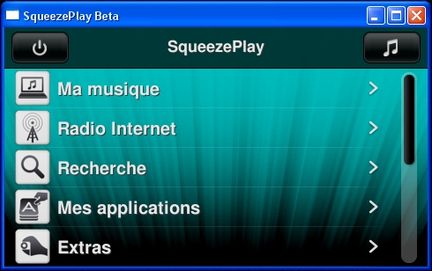
► Télécharger SqueezePlay sous Windows, Mac, ou Linux - ici -
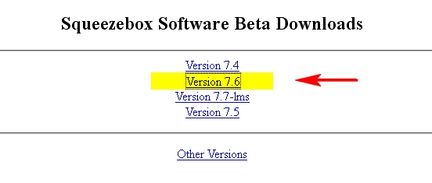
Ici, c'est la Version 7.6 qui a été sélectionnée, sur la page suivante, choisir en fonction de son système d'exploitation la version de SqueezePlay et de Squeezebox Sever (au cas où vous auriez omis une mise à jour).
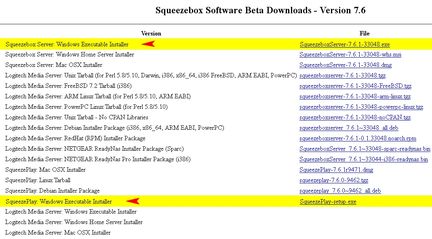

SqueezePlay est en version Bêta, il est important de télécharger régulièrement la dernière version. Avant d'installer une nouvelle version, il est conseillé de désinstaller l'ancienne version en supprimant le dossier SqueezePlay dans Program Files.
À toutes fins utiles vérifier à partir de la commande de chaque Duet que l'option "Activer la lecture (BETA)" est cochée, pour se faire sélectionner "Paramètres", "Avancé", "Fonctions bêta", "Lecture audio".
Ouvrir SqueezeboxSever afin de vérifier que SqueezePlay a bien été enregistré dans la liste de vos platines (ici, SqueezePlay diffuse un programme musical simultanément avec les platines Duet chambre, Slim Bureau, et Duet salon, les autres platines n'étant pas sous tension):

Une réserve, quelles que soient les performances du chipset audio de votre carte mère et/ou de votre carte audio (infos), la qualité de retranscription sera dépendante des haut-parleurs équipant votre P.C.... oublié la musicalité de votre ampli, la vigueur des woofers et la richesse du médium de vos enceintes de salon, mais faite l'essai d'une solution à la fois complète et très simple, tant dans sa mise en œuvre que dans son utilisation!
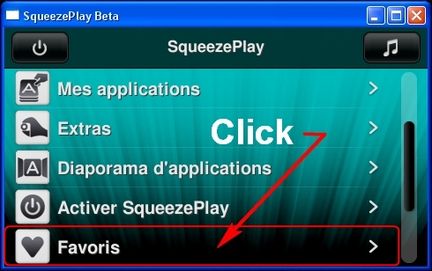
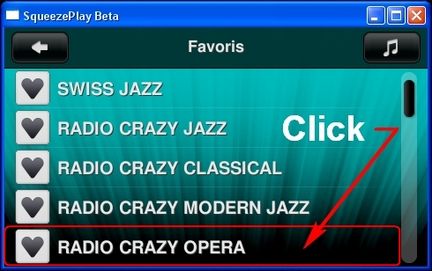
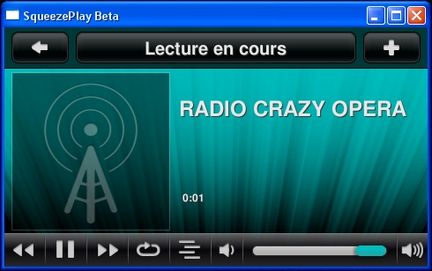

Il demeure néanmoins un intérêt économique à posséder des Squeezebox "physiques", celui du coût de plusieurs P.C.
Le cœur d'un système multiroom démocratisé!
Maison-et-domotique.com - Cédric Locqueneux
► Solution Squeezebox pour du multiroom facile - ici -
Streamin By Bitrate
Bitrate est un terme anglais que l'on peut traduire en français par "taux d'échantillonnage fixe" qui décrit la façon dont la piste audio est encodée.
En effet, plus on compresse le signal et moins la qualité audio est bonne, sachant qu'un un signal encodé en MP3 avec un bitrate de 64 kbit/s a une bande passante de 11 kHz. Ceci signifie que toutes les fréquences situées entre 11 et 20 kHz sont supprimées!
Par ailleurs, pour obtenir un tel taux de compression, outre la suppression des fréquences, on a également transformé les HF en signal mono au lieu de leur conserver leur caractère stéréo.
| Bitrate | Qualité | Compression |
| Master | Supérieure au CD audio | Aucune |
| 1.411 kbit/s | CD audio | Oui |
| 320 kbit/s MP3 | Inférieure au CD audio | 1/4,40 |
| 256 kbit/s MP3 | Inférieure au CD audio | 1/5,51 |
| 192 kbit/s MP3 | Inférieure au CD audio | 1/7,35 |
| 128 kbit/s MP3 | Très inférieure au CD audio | 1:11,02 |
| 96 kbit/s MP3 | Supportable | 1/14,69 |
| 64 kbit/s MP3 | Limite | 1/22,04 |
► Étude de la qualité audio en numérique - ici -
► Les fichiers audio - ici -
Quelques stations de radio diffusent en 320 kbit/s. Avec la Duet il est possible de les sélectionner comme suit:
► Onglet "Personnalisation
du Menu
principal":
•
valider
"SHOUTcast (le carré passe au bleu).
► Menu principal:
• sélectionner "SHOUTcast";
• sélectionner "By Bitrate";
• sélectionner "320 kbit/s";
• sélectionner "AVRO light Classical Hight Definition".
Tout sur les Squeezebox!
► For more information - here -
► Support Logitech - here -
► AudioCircle - here -
► Pat Farrell - here -
Softsqueeze
Softsqueeze is a music player for your PC that works with the Squeezebox Server software. It complements the Boom, Duet, Transporter, Squeezebox and SLIMP3 hardware music players developed by Slim Devices.
Supports synchronization with hardware players and remote streaming over the Internet using ssh tunneling.
Developed in Java, allowing this useful application to work with Windows PCs, OS X and Unix systems.
Emulates most of the digital music players and uses the TCP based slim protocol, allowing use across the Internet and through firewalls/NAT routers.
► Site - here -
FAQ
•
Que faire si SqueezeboxServer ne s'ouvre pas en même temps
que mon
P.C.?
Par défaut, SqueezeboxServer est installé pour être exécuté en tant
que service. Pour l'exécuter en tant que service, procédez comme suit:
muni de votre "Nom d'utilisateur" et de votre "Mot de passe" à
SqueezeboxServer, suivre les indications fournies par l'Assistance de
LOGITECH en fonction du système d'exploitation de votre P.C.
► Assistance LOGITECH - ici -
•
Je me demande tout de même à quoi sert
la prise casque au sommet de
la télécommande, car elle n'est pas
fonctionnelle?
Cette
prise doit être activée dans les
paramètres avancés. Sur le SBC:
dans la liste des platines disponibles, apparaît
"Controller".
En le
sélectionnant, il joue la musique (casque ou
mini-haut-parleur
intégré).
•
Comment
fait-on pour synchroniser
deux Squeezebox™ ? Est-ce une
fonction spécifique ou faut-il tout
simplement brancher les deux boîtes
et les placer sur la même radio par
exemple?
Cela
se fait sur
l'application
SlimServer: on choisit pour chaque
Squeezebox™ si elle joue toute seule
ou si elle est synchronisée (et avec
quelle autre Squeezebox™ si on en
a
plus que 2). On peut également
sélectionner la synchronisation ou non
du volume sonore entre 2 ou
plusieurs SB.
•
Comment puis-je utiliser plusieurs dossiers ou disques comme
sources de
musique dans SqueezeCenter?
Pour
utiliser plusieurs
dossiers et/ou disques comme dossier de musique,
procédez comme suit:
• Windows:
1° Créez des raccourcis vers vos autres dossiers de musique.
2°
Placez les raccourcis dans le dossier défini dans le
SqueezeCenter
comme votre source de musique. Le contenu de ces
autres
dossiers fera alors partie de votre collection
musicale.
• Macintosh:
1° Créez des alias vers vos autres dossiers de musique.
2°
Placez les alias dans le dossier défini dans le SqueezeCenter
comme votre source de musique. Le contenu
de ces autres
dossiers fera alors partie de votre
collection musicale.
•
J'ai acheté une SB Duet l'année dernière que j'ai branchée
sur mon
réseau local
en sortie de la Freebox (Ethernet). Après
quelques
manipulations, j'ai réussi
à la faire fonctionner avec le
Controller et tout
marchait correctement. J'ai acheté quelque
temps
après (au mois de
mai
dernier) une platine Squeezebox Receiver que
j'ai branché
(toujours
en
filaire à la sortie de ma
box) sur mon réseau local. Je
l'ai aussi
configuré
avec mon Controller sans
problème et j'arrivais
bien à accéder
dans
le menu du Controller à la sélection de la
platine pour choisir lequel
contrôler.
Sur ce
j'ai déménagé. J'ai donc essayé
de tout réinstaller et c'est là que
cela se complique.
J'ai
installé la dernière version de
Squeezebox Server v7.4.1. J'ai branché
ma première platine (Squeezebox
Receiver) sur le réseau (toujours en
filaire) et après une
réinitialisation des paramètres usine, j'ai pu connecter
mon
Receiver. J'ai installé ensuite le second Receiver sans
succès. J'ai
donc éteint (débranché) le premier
Squeezebox Receiver.
J'ai utilisé le
Controller pour lancer le second Receiver
en réinitialisant les
paramètres
usine
et j'ai donc réussi à contrôler le second Receiver.
J'ai
rebranché le
premier Receiver et là, le menu de
sélection de la platine
n'apparaît
pas
sur le
Controller donc impossible de faire marcher les deux
en même
temps!
Avez-vous une idée?
L'intégration d'un système de sonorisation "multiroom" composé de
Squeezebox™ Receiver reliés à un réseau Ethernet (câble RJ45 de cat 5
ou 6), suppose le prérequit suivant:
•
chaque
nouvelle zone créée
doit être "couverte" par la liaison Wi-Fi
préexistante entre une
Squeezebox™ Receiver déjà relié par
Ethernet à un routeur ou à
une box et paramétrée à l'aide de la
Squeezebox™ Controller.
Un dessin vaut parfois mieux qu'un long discours:

Pour
vérifier si la pièce
dans laquelle vous souhaitez installer un
nouveau Squeezebox™ Receiver
est "couverte"
par le signal du
Squeezebox™ Receiver déjà
installé, il suffit de
vérifier la puissance
du
signal qui est indiqué par le
pictogramme situé en
bas à droite de
l'écran de la Squeezebox™
Controller:
Nouvelle installation possible:

Installation impossible:
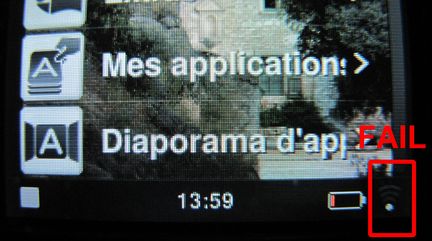
Dans l'affirmative, procéder à la configuration du Squeezebox Receveir
comme suit:
1°
Sur l'écran d'accueil du Squeezebox™ Controler, sélectionnez
"Sélectionner
une platine".
Une liste de tous les Squeezebox de
votre réseau s'affiche,
comprenant
notamment votre Squeezebox™
Receiver qui n'étant pas encore
configurée
et indiquée comme suit:
ex. Squeezebox B5973E (le code
correspondant
aux six derniers
caractères de l'adresse MAC).
2°
Sélectionnez
votre nouveau Squeezebox™ Receiver et appuyez sur
le bouton central
du
Squeezebox™ Controler pour commencer la
configuration. Le bouton
central situé sur la façade avant du boîtier
du Squeezebox™ Controler
change de couleur pour indiquer qu'il est
en cours de configuration
pour votre réseau.
3°
Une fois le
récepteur connecté au réseau, vous êtes invité à
sélectionner une
source de musique. Outre le Squeezenetwork, une
seule source de musique
locale doit être répertoriée. Sélectionnez
votre source de musique
préférée et appuyez une nouvelle fois sur le
bouton central.
4°
Lorsque le
bouton situé en façade avant du boîtier du Squeezebox™
Receveir devient
blanc, cela indique que votre Squeezebox™
Receveir est configuré et
prêt à être utilisé.
5°
Enfin, pour
faciliter la sélection et le contrôle de votre nouveau
Squeezebox™
Receveir, il vous faut lui attribuer un nom descriptif,
comme
"chambre", "salon", etc. (menu Paramètres), et une couleur
d'arrière-plan d'écran
différente.
•
Après
une mise à jour du micrologiciel de ma Squeezebox™ Duet, les
icônes
des
stations de
radio ont disparu (sélections Internet, Local,
Monde, etc). Comment
fait-on pour reprogrammer cette fonction?
À
partir de la télécommande, ouvrir: Paramètres, Avancé, Applet
Installer, Réinstaller après la mise à
jour du micrologiciel,
et
valider cette
commande. Eteindre et rallumer votre
télécommande pour
finaliser cette
réinstallation.
•
Peut-on paramétrer le Receveir d'une Squeezebox™ Duet SANS la
télécommande?
Oui en suivant ce tuto - ici -
Webradios
"Internet radio" (also "web radio", "net radio", "streaming radio", "e-radio", "on the web broadcast", "webcasting") is an acoustic facility transferred by way of the Internet. Broadcasting on the Internet is normally referenced to like webcasting eversince it is nos transferred widely via wireless intents.
Internet broadcast includes continuous flowing media, offering ones listening with a unceasing flow of acoustic that characteristically can't be paused either replayed, a lot like customary transmit media; in this regard, it is clearly different as of on-demand file servicing. Internet broadcast is as well clearly different as of Podcasting, that includes transferring soewhat compared to continuous flowing.
Médium de communication, jusqu'ici destiné à des auditoires relativement restreints, avec un contenu habituellement ciblé pour une clientèle particulière et caractérisée par le fait que la diffusion soit souvent restreinte à Internet, par des amateurs bien que de plus en plus de stations fassent preuve de structure, de professionnalisme et ayant jusqu'aux mêmes droits de diffusion que les stations terrestres conventionnelles.
Or, le début des années 2000*, marque une prise d'intérêt importante des radios FM existantes pour la diffusion sur Internet, que ce soit en lecture en continu ou par des podcasts (balados), indifféremment du fait que les stations soient publiques, associatives ou commerciales.
* En 2000, selon BBC New, plus de 500.000 heures de programmation en direct ont été diffusées à travers le net chaque semaine.

► streamingmedia.com - here -
Premières diffusions
Depuis le milieu des années 1980, il a été possible d'enregistrer des fichiers audio dans les fichiers numérisés et de les envoyer sur Internet en utilisant des normes élaborées par des sociétés comme Sun Microsystems et Microsoft.
En 1993, Carl Malamud (1959), ingénieur, à l’origine des protocoles qui permettront la diffusion de la radio sur Internet, fonde Multidiffusion Internet Service (IMS), organisme sans but lucratif, et créé Internet Talk Radio, première station de radio de l'Internet.
Internet Talk Radio utilise une technologie appelée MBONE (IP Multicast Backbone sur Internet).
► IMS Request That IANA Function Be Competitively Bid - here -
IMS a commencé à émettre en 1994 depuis le National Building Press Club, 529 14th Street NW, Washington, DC.
Elle offrait plusieurs heures de programmes hebdomadaires comprenant chaque jour de la semaine, l'interview d'un spécialiste en informatique, un flux audio de Radio Monitor et de CBC Nouvelles. Ses diffusions seront élargies à l'intervention de société allant du National Press Club (infos), organisations professionnelles mondiales majeures pour journalistes, à la librairie City Lights Books (infos)
► Internet Multicasting Service's Audio FAQ Department - here -
Le 24 juin 1993, IMS diffusera la première performance musicale avec le groupe Severe Tire Damage.

Pour ouvrir la vidéo de la première Webdiffusion live de Severe Tire Damage, cliquer - ici -
IMS a cessé son activité le 1er avril 1996.
Le 07 novembre 1994, radio WXYC de l'Université de Caroline du Nord à Chapel Hill (UNC-Chapel Hill ou Carolina), est la première à diffuser en direct sur Internet au format MP3 avec le logiciel d'audioconférence CU-SeeMe développé à l'université Cornel État de New York)
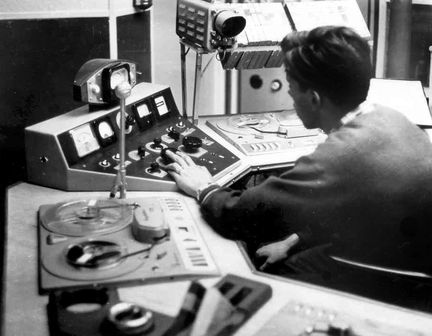
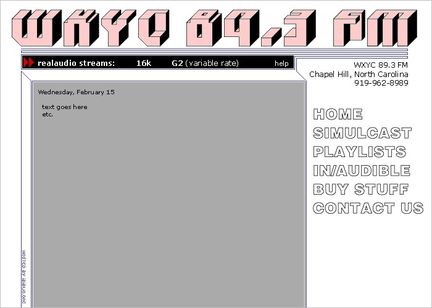
► WXYC - here -
► Wikipedia - CU-SeeMe - here -
Elle sera suivie le 11 février 1995 par Radio HK (Californie), créée par Norman Hajjar, fondateur de Hajjar/Kaufman New Media Lab, une agence de publicité à Marina del Rey, en Californie. Cette radio on line est la première à diffuser 24h/24 de la musique de groupes indépendants via la lecture en boucle d'un CD diffusé avec CU-SeeMe développé à l'université Cornel (État de New York).
Radio HK sera une des premières à adopter RealAudio de RealNetwork diffuser ses programmes.
En 1996, Edward Lyman, producteur, créé Sonicwave.com, la première station de radio Internet des États-Unis, légalement autorisée à la fois par l'ASCAP et BMI, de diffuser en direct, 24 heures par jour sur Internet.
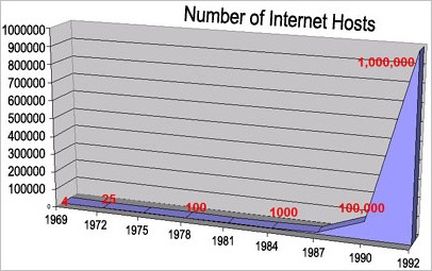
En mars 1996, Virgin Radio - Londres, devient la première station de radio européenne à diffuser son programme complet en direct sur Internet. Virgin Radio diffuse à la fois en modulation de fréquence (FM ou UKW dans les pays germaniques) dans la gamme des très hautes fréquences (VHF), et Internet 24 heures par jour.
Après avoir quitté son poste de dirigeant chez Microsoft, Rob Glaser (1962) créé Progressive Network, puis RealNetwork en 1994, qui en avril 1995, commercialise le logiciel RealAudio, première solution révolutionnaire de streaming audio commerciale pour l'Internet.
RealAudio qui permet d'écouter de la musique en même temps qu'elle est téléchargée, sera à l'origine du développement fulgurant du nombre d'adresses http diffusant de la musique en streaming.

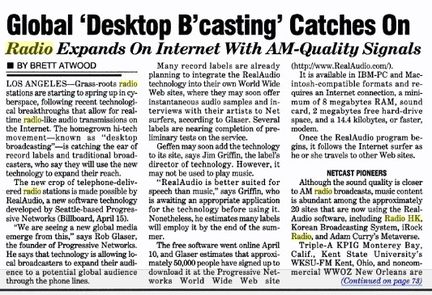
► Suite de l'article page 73 - here -
Netcast pioneers
Although the sound quality is closer to AM radio broadcast, music content is abundant among the approximately 20 sites that are now using the RealAudio software, including Radio HK, Korean Broadcasting System, iRock radio, and Adam Curry's Metaverse.
Triple-A KPIG Monterey Bays, Calif., Kent State University's WKSU-FM Kent, Ohio, and noncommercial WWOZ New Orleans are among the conventional audio broacasters using RealAudio to expand their audiences to new territories.
"We've had people tuning in from as far away as Australia, England, and New York," says WWOZ GM David Freedman. "This I an exciting thing right now. I can't wait to see what develops in the next 18 months."
Radio stations integrate the RealAudio into their sites in different ways. KPIG adds more than an hour of its daily programming to its Web site five times a week, while WWOZ periodically adds blues and jazz music and feature programming to its site.
Seoul, South Korea-based KBS post sound sammples from its weekly top 10 playlist. Visitors to the Deusche Welle site can hear its news programming, while Toronto-based Radio Canada offers highlights from its "Quirks And Quarks" program.
Curry's Metaverse sit uses RealAudio to netcast interviews with artiste including Santana, Guns N'Roses guitarist Slash, and "Late Night With Conan O'Brien" bandleader and E Street drummer Max Weinberg.
24-Hour music service
Marina Del Rey, Calif.-based Radio HK is believed to the first service using RealAudio to program music 24 hours a day exclusively for its Internet audience.
Radio HK initially began service over the Internet to users who have access to a high-speed ISDN digital phone connection. When it addet the
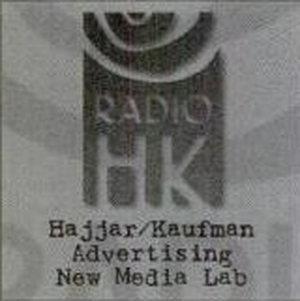
RealAudio software to reach potential listeners with conventional phone lines, it expanded its audience sonsiderably.
"It was a major step forward for us," says Norman Hajjar, president of Hajjar/Kaufman Advertising and the New Media Lab, which developed Radio HK. "We are getting E-mail from listeners as far away as Estonia and Luxembourg."
As the potential listening audience widens to agloal scale, radio stations may benefit from expanded ad revenue. In addition, on-screen Web-site advertising may soon accompagny net-casts.
"We hope to eventually give our underwriters space on the Web page," says WKSU-FM systems specialist Chuck Fulton.
A royalties war
But when it seemed like internet radio had conquered some of the technological challenges, a different kind of hurdle showed up. In October 1998 the US Congress passed the Digital Millennium Copyright Act, which meant that performance royalties had to be paid for satellite radio and internet radio in addition to publishing royalties. Traditional radio broadcasters only have to pay publishing royalties. The war between internet radio and legislators had begun.
Radio for the people
Lollapalooza founder and Porno For Pyros* man Perry Farrell says that real-time. Internet-delivered radio stations may eventually bring the power and politics of corporate radio back into the hands of the people.
* alternative rock groupsfront
"It's a good idea," says Farrell. "I envision a time when the people can vote on the playlist themselves. There could be a list on the comuter screen that list the songs in rotation, and songs falls off when the people decide that they don't want to hear it anymore."
The price to license use of the RealAudio software ranges between $1,500 and $10,000, depending on the bandwidth capacity of the server.
The legal barriers

Reprise promotion director of new media Jimmy Dikson says major labels may have cause for concern about real-time audio broadcasting over the Internet when it approaches digital quality.
"There will have to be some sort of regulation at that point," he says.
However, the current AM-like quality shouldn't worry the labels just yet, says Radio HK's Hajjar. "I recognize and appreciate the recording industry's concern about the potential for pirating," he says.
"The quality is still very low, so I wouldn't expect that many people would want to keep it. It's just barely passable for music."
Since Internet-delivered programming does not use the public airwaves, it is not subject to the same Federal Communications Commission regulations that over-the-air broadcasters must follow.
Though the FCC was not available at press time for comment, Larry Eads, FCC chief of audio services, recently told The San Francisco Chronicle, "Content is not an issue when you are using the phone lines…I don't see any basis for the FCC to intervene."
To avoid any potentiel legal problems, radio HK is playing only independent and unsigned artists, including Ireland-based Swampshack, Virginia-based Faschion Central, and Santa Cruz, Calif.-based Riots Of Boredom.
Hajjar says each artist must sign an agreement that grands the station permission to play the music before a song is added to the playlist.
It was unclear at press time whether Ventura, Calif.-based iRock Radio had obtained licensing clearances for its playlist, which includes three 45-minute music programs featuring artists that range from Sarah McLachlan to the Beach Boys.
BMI has alredy made available to some online content providers a blanket Internet licensing agreement, which grants unlimited access to its compositions (Billboard, April 15).
ASCAP is in the process of approving its own licensing agreement for all electronic transmissions of music, including those on the Internet, private bulletin board systems, and commercial online services, according to Bennett Lincoff, ASCAP director of legal affairs for new media and technology strategy.
Lincoff declined to release details about the agreement, except to say that it is "sgnificantly different" than BMI's.
Since Internet transmissions are global, these U.S. agreements may not solve all the legal issues of transmitting music over the Internet, cautions Hajjar.
KPIG plans to steer clear of music content until the legality of netcasting songs globally is resolved, says PD Laura Hopper.
None of the RealAudio programming is live, but Progressive Network's Glaser says this will likely be possible before the end of the year.
Live simulcast transmissions are already happening through another software program called Internet Phone, though only one listener can tune in at any given time.
Internet Phone, developed by Northdale, N.J.-based Vocaltech, allows for real-time, two-way voice communication over the Internet.
The software was developed to offer global telephone-like communications without the long-distance charges. But it is also being used to expand the signal of many radio stations across the globe. WCBS-AM New York, WJOL Chicago, and Wisconsin Public radio are among the programmers that can be heard worldwide on accasion through Internet Phone.
"We were surprised to find that happening," says Vocaltech president/CEO Elon Ganor. "Il wasn't what we intended it to be used for, but I imagine we'll see more of it in the future."
Netcom, one of the nation's larg est Internet service providers, wil integrate Internet Phone into it standard service in mid-July, according to Ganor.
Enlarging the audience
VocalTech may soon offer a version of Internet Pone software that al lows communication to a larger audience, according to Ganor.
The Internet Phone software I being sold over the Internet and I also being bundled with several versions of Motorola modems.
Previous to RealAudio and Internet Phon, audio programming ove the Internet on conventional phonlines consisted of a long process a downloading audio to a hard drive for delayed playback. It took patience and a large amount of hard-drives space to actually hear the audio.
Computer users with access to higher-speed ISDN phone connections were able to hear radio broadcasts from stations like WXYC Chapel Hill, N.C., KUGS Bellingham, Wash….and WJHK Lawrence Khan., which used the CU-SeeM software to rebroadcast their signal.
However, these new software developpments reach a significantly larger audience because they use conventional phone lines.
Annuaires de flux radio
► Comment trouver l'URL du flux d'une radio? - ici -
► Avec Fluxradios - ici -
► Avec LinuxPedia - ici -
► Avec listenlive.eu - ici -
► Avec R.W.L.E. - ici -
Webradios thématiques sans coupure publicitaire
Le célèbre MP3 (en réalité MPEG-1 Audio Layer 3), algorithme de compression audio mis au point par l'institut allemand Fronhofer en 1993, est sans doute le codec destructif le plus connu.
Il permet de diviser par 11 le volume de données d'un CD audio* sans que la perte de qualité induite ne soit trop gênante à l'écoute: ainsi, au lieu de 1.400 kbit/s comme sur CD, le même son en MP3 n'utilisera plus que 128 kbit/s.
Pour une musique donnée, c'est donc onze fois moins de stockage utilisé, ou encore onze fois moins de temps pour la télécharger, et à l'inverse, onze fois plus de musique à volume égal.
* CD audio: 1.411 kbit/s à 44.100 échantillons par seconde (44,1 kHz) en 16 bits par échantillon.
Ce taux de 128 kbit/s étant d'une part arbitraire et d'autre part, le débit des connexions Internet étant en constante progression, il est dorénavant possible aux Webradios de proposer des taux de compression moindres au moment de la diffusion d'un fichier MP3: 192 kbit/s, 224 kbit/s et 320 kbit/s.
320 kbit/s (http au 13.03.2015)
•
Audiophile Classical - url:
http://50.7.173.162:8012/
•
Audiophile Baroque - url:
http://50.7.173.162:8010/
•
Audiophile Jazz - url:
http://50.7.173.162:8014/
•
Audiophile Live - url:
http://50.7.173.162:8008/
•
Linn Classical - url:
http://89.16.185.174:8003/stream
•
Linn Jazz - url:
http://89.16.185.174:8000/stream
•
Linn Radio - url:
http://89.16.185.174:8003/stream
256 kbit/s (http au 13.03.2015)
•
Avro klassiek - url:
http://icecast.omroep.nl:80/radio4-klassieken-bb-mp3
•
Concertzender Live - url:
http://www.concertzender.nl/streams/live
•
Radio Klasika - url:
http://live.slovakradio.sk:8000/Klasika_256.mp3.m3u
192 kbit/s (http au 13.03.2015)

Depuis le 14/12/2016, des "tubes" de la musique classique ("Classique easy"), en passant par des œuvres parfois moins connues et proposées dans leur intégralité ("Classique plus"), les musiques du monde, la création, le jazz, et le meilleur des concerts de nos formations maison ("Concerts Radio France") – c’est la musique dans toute sa diversité, et par ses meilleurs interprètes, que nos programmateurs vous proposent au gré de vos envies, de votre curiosité, et de vos humeurs musicales…
Pour afficher à l’écran de la télécommande les infos relatives à l’artiste, le titre, la couverture de l’album, le nom de l’album pour ces webradios de Radio France il faut sélectionner le plugin de Paul Webster et celui de Michael Herger pour les webradios de Swiss Radio SRF :
Nas Synology : Synology Assistant > LMS > Paramètres > Plugins
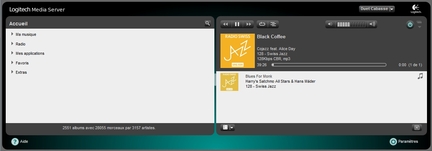
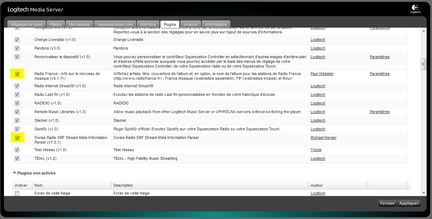
•
France Musique - Classique Plus – url:
http://direct.francemusique.fr/live/francemusiqueclassiqueplus-hifi.mp3
•
France Musique - Concerts Radio France – url:
http://direct.francemusique.fr/live/francemusique
concertsradiofrance-hifi.mp3
•
France Musique - La Jazz – url:
http://direct.francemusique.fr/live/francemusique
lajazz-hifi.mp3
•
France Musique - La Contemporaine - url:
http://direct.francemusique.fr/live/francemusique
lacontemporaine-hifi.mp3
•
France Musique | L’événementielle – url:
http://direct.francemusique.fr/live/francemusique
levenementielle-hifi.mp3
•
France Musique | Musiques du monde - Ocora – url:
http://direct.francemusique.fr/live/francemusiqueocoramonde-hifi.mp3
•
FIP autour du rock – url:
http://direct.fipradio.fr/live/fip-webradio1.mp3
•
FIP autour du jazz – url:
http://direct.fipradio.fr/live/fip-webradio2.mp3
•
FIP autour du reggae – url:
http://direct.fipradio.fr/live/fip-webradio6.mp3
•
Mouv' Xtra – url:
http://direct.mouv.fr/live/mouvxtra-midfi.mp3
•
Avro Baroque - url:
http://icecast.omroep.nl/radio4-baroque-bb-mp3.m3u
160 kbit/s (http au 13.03.2015)
•
Concertzender Klassiek - url:
http://www.concertzender.nl/streams/klassiek
•
Concertzender Baroque " - url:
http://www.concertzender.nl/streams/oudemuziek
128 kbit/s (http au 13.03.2015)
•
Radio Swiss Classic - url:
http://stream.srg-ssr.ch/m/rsc_de/mp3_128
•
Radio Swiss Jazz" - url:
http://stream.srg-ssr.ch/m/rsj/aacp_96
•
Swissradio Opera - url:
http://stream2139.init7.net:80
•
Venice Classic - url:
http://109.123.116.202:8010
•
FIP - url:
http://mp3.live.tv-radio.com/fip/all/fiphautdebit.mp3
Ajouter ou modifier une url avec mysqueezebox.com
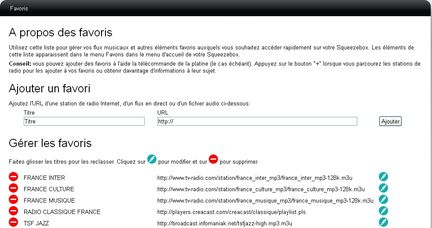
► Accès au site - ici -
Screamer Radio, freeware Internet Radio player

Screamer radio est un poste de radio virtuel proposant d'écouter avec votre ordinateur un large choix de radios et Webradios, classées par catégories, ou celles que vous aurez personnellement rajoutées à la liste!
L'application est en outre dotée de fonctionnalités intéressantes notamment:
•
d'un compresseur permettant
de traiter le son en provenance du flux
audio;
• il est également possible d'enregistrer en direct les morceaux diffusés!
À noter que certaines stations (ex. Linn Classical, Linn Jazz) permettent, lors d'un enregistrement en continu, la création automatique d'un fichier par titre avec ses références, et cela sans aucune intervention!
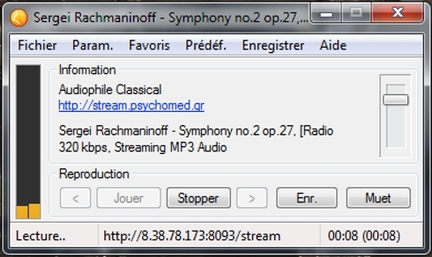

► Chargement du logiciel - ici -
► Tuto - ici -
Service d'écoute de musique en streaming à la demande
Deezer
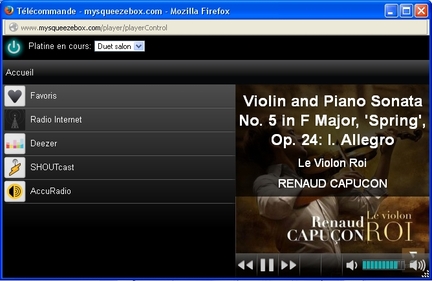
Deezer.com, né le 22 août 2007, est licite grâce à de nombreux accords avec la SACEM et des maisons de disques. Avec un abonnement l'écoute est à 1411 kbit/s (16-Bit FLAC), 320 kbit/s et 128 kbit/s pour l'accès gratuit.
Depuis début juin 2010, les 7 millions de titres du catalogue Deezer Premium+ sont accessibles sur toute la gamme Squeezebox de Logitech (Squeezebox Duet, Squeezebox Radio, Squeezebox Touch...).
Pour choisir ses titres musicaux directement sur l’écran couleur de la télécommande d’une Squeezebox ou de l'application Logitech Squeezebox Controller chargée gratuitement sur votre Smartphone, sur le service Deezer gratuit ou Premium+, il suffit d'ajouter cette fonction depuis votre compte mysqueezebox.com, onglet Diaporama d'applications/Installer l'application.
Dématérialisez votre musique!
Pour ceux qui se demandent peut-être ce que l'on entend au juste par "dématérialisation" ou "musique dématérialisée", quelques liens:
► Les bonnes approches - ici -
► Comprendre l'installation en musique dématérialisée - ici -
► Forum Audiophile - ici -
PC et hi-fi
► Blog HiFi PC Guide - ici -
Rip de CD: pour en finir avec le "Bitperfect"
Article de cta-perception.com
Essayer de déterminer si certains logiciels d’extraction peuvent effectivement prétendre au label "bit-perfect", c’est-à-dire garantir de façon certaine que le fichier extrait est strictement identique au contenu du CD.
Le deuxième objectif est de déterminer si certains logiciels sont capables de corriger les erreurs de lecture engendrées par une surface de CD endommagée et de mesurer à quel point ces logiciels sont capables de corriger ces erreurs.
► Forum Audiophile - ici -
► Installation d'EAC - ici -
► Clonage parfait d'un CD audio avec EAC - ici -
► Téléchargement d'Exact Audio Copy - ici -
DAC
À l'heure de la convergence numérique, bon nombre d'entre nous disposent d'une bibliothèque musicale conséquente. Plus pratique que les CD, vous disposez de milliers d'heures de musique sur votre ordinateur. Comment substituer la sortie son (souvent la sortie casque) de votre ordinateur pour obtenir un son qualité hi-fi?
L'entrée USB des DAC Audio est parfaitement calibrée pour cela. Elle permet de récupérer le son diffusé par votre ordinateur, de le transformer en signal audio analogique pour que votre chaîne hi-fi puisse en restituer la musique.
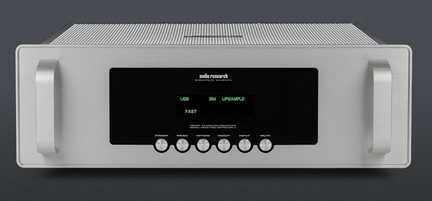
Audio Research DAC9
Principe de la conversion N/A
Les meilleures sources numériques ne seront jamais parfaites sans un bon convertisseur audio: le DAC (Digital-to-Analog Convertor). Ce petit boîtier permet de supplanter la carte son de l'ordinateur pour exploiter vos fichiers numériques (MP3, FLAC, AAC) directement sur votre chaîne hi-fi.
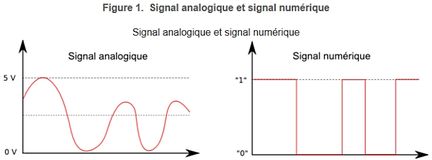
Les signaux numériques (binaires: 1 ou 0) sont convertis en signaux analogiques (nombre infini d'états). Les DAC Audio représentent la meilleure solution pour profiter de la bibliothèque musicale numérique de son ordinateur avec une haute qualité de traitement du signal musical.
Fréquence d'échantillonnage, résolution et types de convertisseurs
Les convertisseurs des DAC Audio disposent d'une fréquence d'échantillonnage et d'une résolution spécifiques. Plus celles-ci sont élevées, plus la qualité de restitution est bonne.
Pour être performant, un convertisseur doit proposer au minimum un débit natif de 48 kHz à 16 bits. Pour répondre à des critères audiophiles, les convertisseurs haut de gamme possèdent des débits natifs identiques à ceux utilisés dans les plus grands studios d'enregistrement.
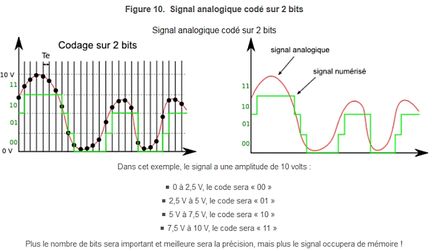
Un taux d'échantillonnage de 192 kHz à 24 bits conviendra parfaitement aux utilisateurs les plus exigeants. Le signal reste ample, et ne subit aucune perte qualitative. Certains convertisseurs bénéficient d'une solide réputation (Asahi Kasei, Burr-Brown, Wolfson…), et s'imposent comme des valeurs sûres.
Le taux de distorsion harmonique (ou distorsion harmonique totale)
Le taux de distorsion harmonique représente la variation d'un signal par rapport à son état originel. En d'autres termes, il incarne la quantité de déformation que subit un signal ou un courant lorsqu'il traverse un circuit de bout en bout.
Plus ce taux est faible, plus le son obtenu est limpide. Un taux de distorsion harmonique élevé peut nuire à la transparence du signal, et aboutit à une résolution sonore imprécise.
Généralement, on considère qu'un taux inférieur à 0,05 % est suffisant pour restituer un signal propre et détaillé. Les convertisseurs les plus performants affichent des distorsions extrêmement faibles, qui aboutissent à des taux de l'ordre de 0,002 %, parfois moins dans certains cas.
La bande passante
La bande passante d'un appareil définit la plage de fréquences qu'il peut reproduire. Elle s'exprime avec une tolérance, généralement de 0 à -3 dB.
Pour être considéré comme hi-fi, un appareil doit avoir une bande passante de 20 Hz à 20 kHz. L'oreille humaine entend les sons d'un bon niveau entre 25 Hz et 16 KHz.
Cependant, les infrasons sont perceptibles (par le crâne et la cage thoracique) jusqu'à 14 Hz. Il est dangereux d'émettre des infrasons en dessous de 15 Hz, car cela peut provoquer des nausées et des troubles cardiaques.
En étendant la bande passante au-delà des fréquences audibles dans les aigus, jusqu'à 40 kHz, on garantit une meilleure précision temporelle des transitoires à laquelle l'oreille est très sensible.
- - - oOo - - -
In electronic, a digital-to-analog converter (DAC or D-to-A) is a device that converts a digital (usually binary) code to an analog signal (curent voltage, or electric charge). An analog-to-digital converter (ADC) performs the reverse operation.
Most modern audio signals are stored in digital form (for example MP3 and CDs) and in order to be heard through speakers they must be converted into an analog signal. DACs are therefore found in CD players, digital music players, and PC sound cards.
Specialist standalone DACs can also be found in high-end hi-fi systems. These normally take the digital output of a compatible CD player (only some CD players output a digital signal in addition to analog) or dedicated transport and convert the signal into an analog line-level output that can then be fed into an amplifier to drive speakers.
Similar digital-to-analog converters can be found in digital speakers such as USB speakers, and in sound card.
Pilotes ASIO
Si les DAC USB sont tous reconnus automatiquement par Windows, pour que les flux audio natifs soient transmis directement de la source aux DAC, sans la moindre manipulation ni altération, il faut utiliser des pilotes ASIO (soit ceux fournis, soit les génériques ASIO4ALL).
► ASIO4ALL – Universal ASIO Driver for WDM Audio - ici -
Parce que de base, c'est le pilote Direct Sound de Windows qui prend le pas. Et lui, va centraliser tous les flux audio dans son mélangeur avant de les dispatcher vers la carte son ou le DAC.
Or, comme l'ensemble des sons entrants (Windows, navigateur Web, différentes applications, etc.) ne sont pas tous de même nature, cet émulateur rééchantillonne tout à une résolution unique.
Donc sauf à caler manuellement, à chaque morceau, l'échantillonnage principal de sa carte, le son est détérioré. Et la latence augmente sérieusement, même si ce défaut concerne avant tout la création musicale et non pas la lecture audio.
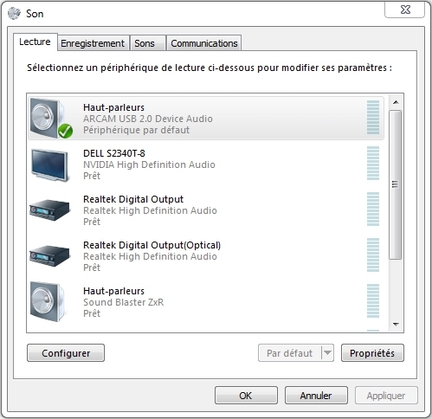
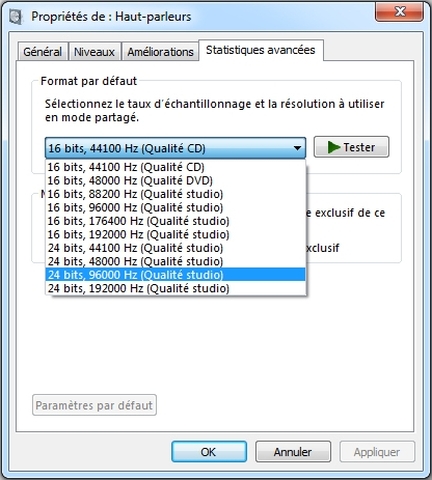

Il faut ensuite un logiciel de lecture audio qui soit compatible avec les pilotes ASIO ET avec les fichiers encodés en FLAC HD à 96 kHz et 24 bits que nous avons dans notre playlist de test. Foobar2000* est une référence dans ce domaine, c'est lui que nous utiliserons.
* foobar2000 est un lecteur audio gratuit développé par Peter Pawlowski, un ancien développeur de Nullsoft. Ce logiciel fonctionne sous Microsoft Windows. Sous une interface simple et épurée, il offre des fonctions avancées dans de nombreux domaines autour de la gestion de fichiers musicaux.
Il est capable de lire la plupart des formats audio tels que MP3, Ogg, FLAC, Speex, ainsi que des formats moins courants. Ses fonctionnalités peuvent être étendues ou remplacées par l’installation de modules indépendants.
Rien de trop compliqué quand on connaît. Il faut d'abord installer Foobar2000, puis télécharger le composant ASIO support 2.1.2 et l'installer depuis le logiciel. Il ne reste plus qu'à activer le DAC au sein du logiciel de lecture (menu préférences, playback, output) et c'est parti!
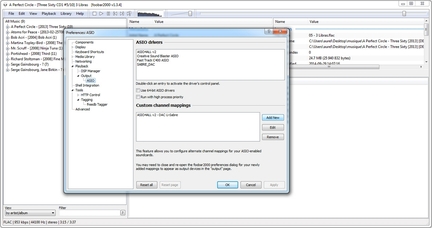
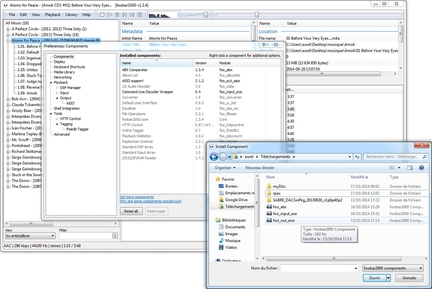
Pour vérifier que l'installation est opérationnelle, vous pouvez essayer de choisir un autre périphérique de lecture par défaut que le DAC dans le mélangeur de Windows, la musique lue par Foobar2000 doit toujours sortir par le DAC.
External links
► Article de wikipedia - here -
► ENS Lyon – partie 1 - here -
► ENS Lyon – partie 2 - here -
► bedwani.ch - here -
► Sélection de DAC par AUDIOGON - USA - here -
► DAC Kit 2.1 Level B Signature with USB interface - here -
NAS
Le concept développé en 1983 par Novell, est un serveur de stockage en réseau de fichiers autonome, également appelé stockage en réseau NAS, boîtier de stockage en réseau ou plus simplement NAS (de l'anglais Network Attached Storage).
Sa principale fonction est le stockage de données en un volume centralisé à travers un réseau IP.
Founded in April of 2000, Synology Inc. is a leader in next-generation Network Attached Storage (NAS) servers for the home, SMB, and SME markets. Specializing in both hardware and software for network attached storage devices; Synology products are feature-rich, easy-to-use, energy-efficient, reliable and affordable.
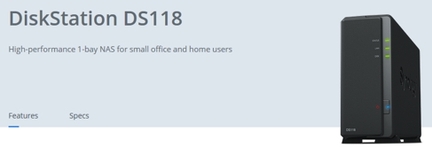
► Caractéristiques - ici -
Installation de Logitech Media Server (LMS) sur Synology
LMS diffuse la musique stockée sur le DiskStation vers chacune de vos Squeezebox Logitech® (Transporter, Duet, etc.).
1) Installer le
Nas à l’aide du CD qui
l’accompagne, effectuer la mise à jour à
partir
du Centre
de téléchargement Synology.
2) Toujours à
partir du Centre de
téléchargement Synology, télécharger
"Synology
Assistant".

Raccourci sur le Bureau de votre PC.
3) Télécharger le paquet
"Logitech
Media Server" sur le Bureau du
Synology:


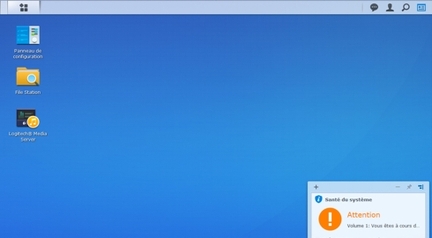
4) Transférer les dossiers
musicaux dans un dossier (ici "Musique")
créé dans le dossier "File Station":

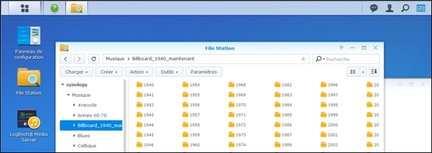
5) Double clic gauche sur
l’icône Logitech Media Server du "Bureau"
pour accéder à cette page:
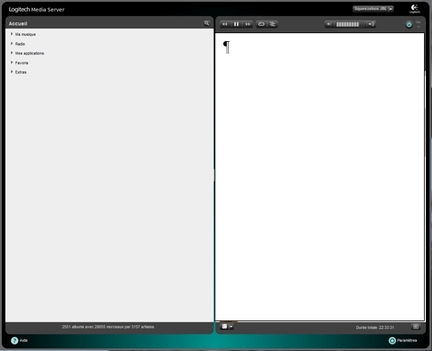
6) Clic gauche sur le bouton
"Paramètres" situé en bas, à gauche de la page
pour accéder à cette page
(par défaut les boutons Musique, Images et
Vidéo sont
sélectionnés):
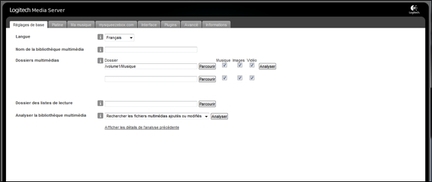
7) "Dossiers multimédias", clic gauche sur le bouton "Parcourir":

8) Dans la fenêtre "Veuillez
sélectionner un dossier", cliquer sur le dossier
Musique puis sur le bouton
Fermer, le chemin est donc activé:
/volume 1/Musique

Il n’est pas nécessaire de renseigner la fenêtre "Dossier des listes de lecture".
9) Mise sous tension de la
télécommande et/ou de votre smartphone,
accepter la mise à jour du logiciel de
la télécommande et/ou de
de l’application pour les smartphones
qui vous sera proposée.
Redémarrage automatique en fin
d’installation.
L’installation de Logitech Media Server (LMS) sur votre nas Synology est terminée!
Sélectionner "Ma musique", "Dossier de musique" sur votre télécommande et/ou votre smartphone pour profiter de la musique installée sur le DD de votre nas Synology.
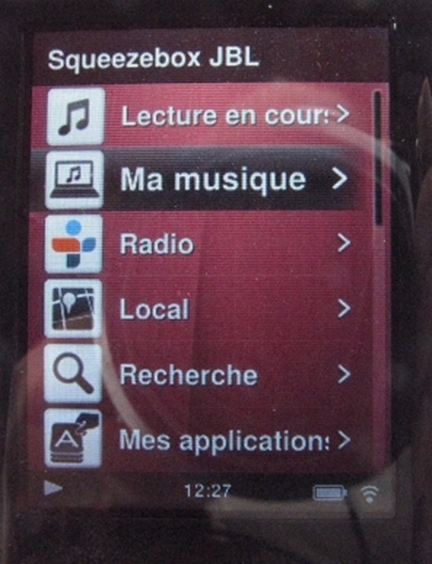

Tuto du 12/03/2018 avec les indications précieuses du SAV Synology.
Transmetteur audio sans fil, 2.4 GHz
DAC numérique / analogique
DAC WDACT-1 de la sté Audiophonics

Matériel distribué sous la marque Elecaudio par la sté Audiophonics, implantée depuis 2004 à Floirac (33270) et spécialisée dans le secteur d'activité de la vente à distance sur catalogue spécialisé.
► Fiche technique - ici -
Matériel certes peu onéreux, mais défaillant : coupures, claquements dans les HP sur 3 ensembles testés consécutivement, à éviter absolument, même d’occasion.
DAC D2 de la sté Audioengine
LA SOLUTION !
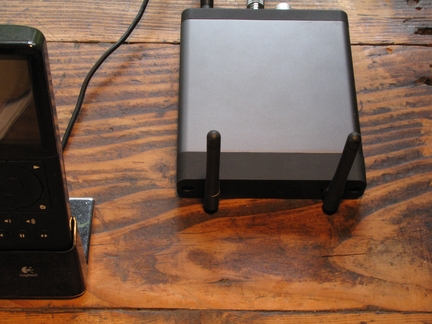
Depuis son envoi par G. O. (achat le 27/07/2017 sur Leboncoin), connecté en S/PDIF entrée/sortie, plus aucune coupure1 de diffusion ni claquement dans les enceintes, après des heures et des heures d'écoute de sources diverses!
1 cf. remarque de wmalaret publiée sur le site de Qobuz (ici).
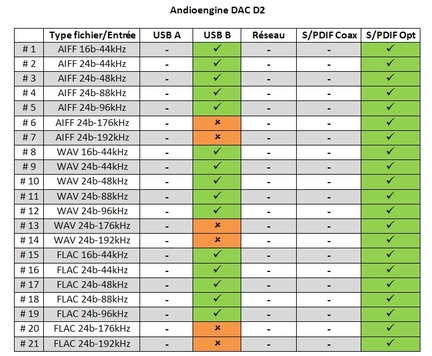
À noter que ce matériel ne figure plus sur le site d’Audioengine depuis l’été 2017.
► Test - ici -
Câbles - Prises - Réseaux résidentiels

L'habitat résidentiel intègre de plus en plus, dans son infrastructure, les réseaux de communication (téléphone, Internet, multimédia), au même titre que le réseau électrique. Le terme VDI (Voix, Données, Images) est souvent utilisé pour qualifier ces réseaux de communication.
► Infos - ici -
Connectique audio asymétrique et symétrique

Les liaisons audio asymétriques et symétriques servent toutes deux à transporter un signal électrique représentatif d'une modulation audio, d'un point à un autre. La liaison asymétrique est largement utilisée dans le domaine grand public, alors que la liaison symétrique est largement utilisée dans le domaine professionnel. Ce paragraphe parle des différences fondamentales entre ces deux modes de liaison.
► Article - here -
Débits et vitesses de transfert
Pour mémoire, le débit théorique de l'USB 2.0 atteint 60 Mo/s (480 Mbit/s), l'interface plafonne en pratique à 35 Mo/s contre près du double, voire du triple pour les interfaces concurrentes comme le FireWire ou l'eSata.
| Version | USB 2.0 | USB 3.0 | USB 3.1 |
| Année | 2000 | 2008 | 2013 |
| Débit* | 480 Mbit/s 60 Mo/s |
5 Gbit/s 600 Mo/s |
10 Gbit/s 1,2 Go/s |
* Ces débits ne sont toutefois que théoriques. Afin de trouver des valeurs concrètes, divisez la vitesse par 2 en utilisation optimale, 4 en utilisation normale, voire 15 avec beaucoup de périphériques USB simultanément utilisés.
► Plus d'infos avec aidewindows.net - ici -
Audiophile, tu perds ton sang-froid
Billet d'humeur de Pierre Schneider
Les forums internet sont un outil fascinant de sciences humaines expérimentales. Ils permettent d’observer comme jamais auparavant la communication au sein de groupes réunis par un intérêt commun et donnent aussi une idée des actions de leurs membres – les plus intéressantes étant bien entendu celles qui sont irrationnelles.
► Lire la suite - ici -
Physiopathogénie de l'audiophile presbyacoustique
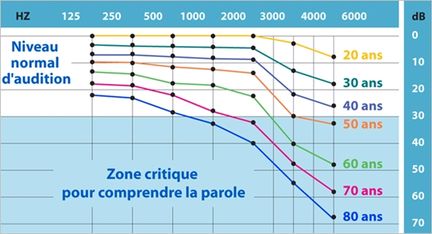
À la lecture de commentaires sur les sites spécialisés, il semble que les auteurs "oublient" que leur vieillissement sensoriel a commencé dès l'âge de leurs 20 ans... L'audiophile serait-il celui qui "entend mais qui ne comprend pas"?
Dans ces conditions, le sacro-saint "fil droit avec du gain" mis en avant par les fabricants est-il raisonnablement compatible avec notre inéluctable presbyacousie?
► Perte auditive et acouphène - ici -
Equal-Loudness Level Contours (ISO 226)
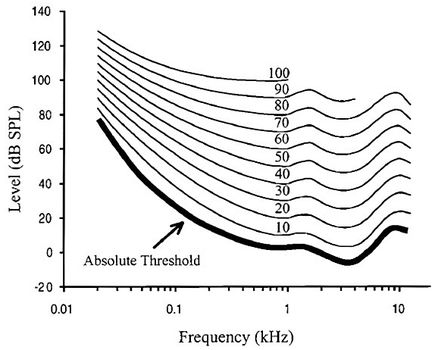
Loudness: Sonic (i.e. perceptual) attribute of sound waves related mainly to intensity.
In general, large intensity values result in "loud" sounds while low intensity values result in "soft" sounds. More specifically, loudness is a perceptual manifestation of how the auditory system a) represents sound wave intensity and b) makes intensity comparisons among signals across frequency and time. In terms of physiology, loudness may be a measure of the total activity of the basilar membrane.
► Perceptual attributes of acoustic waves - Loudness - ici -
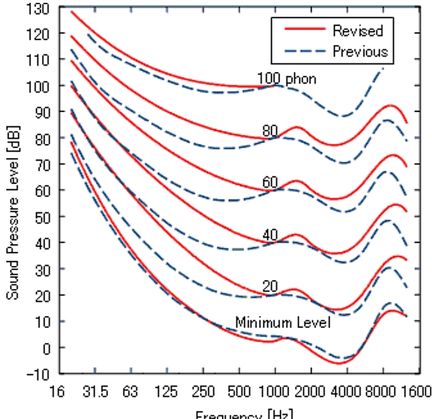
The new equal-loudness-level contours based on the results of works by the international collaborative research group have been adopted as the International Standard, ISO 226:2003.
► Measurements in Detail - ici -
► Equal-Loudness Level Contours (ISO 226) - ici -
► Correlation between sones und phons - ici -
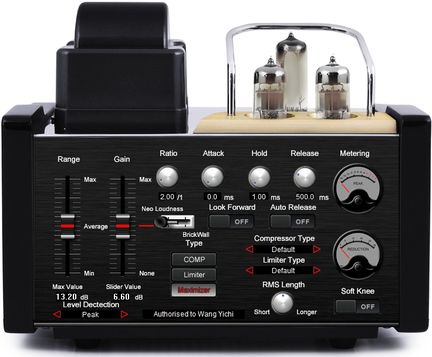
Neo Loudness is a comprehensive tool designed to control loudness. Neo Loudness not only includes traditional compressors and limiters, but it also features a new type of Maximizer.
► KVR Audio - Neo Loudness - ici -
La guerre du volume par Emmanuel Deruty
Scandale des fichiers audio Haute Définition

Mark Waldrep, sur le site américain I.TRAX.com, commente les résultats d’une étude approfondie sur la qualité des fichiers audio Haute Définition, qui connaissent un succès grandissant avec l’arrivée de la musique dématérialisée dans la sphère audiophile.
Des compagnies américaines comme HDTracks (fondée par les frères Chesky, réputés pour le haut niveau de leurs enregistrements) ou anglaises comme Linn (grand nom de la hi-fi) sont pointées du doigt.
► Suite de l'article publié par Adriatika - ici -
► AIX Records - ici -
Les câbles peuvent-ils améliorer les caractéristiques audio
de votre installation?
Au-delà du matraquage publicitaire éhonté des distributeurs de câbles audio, et de certains vendeurs qui essaient de vous faire croire que vos câbles neufs ont besoin d'être rôdés pendant une certaine période pour qu'ils (les câbles) révèlent toutes leurs qualités, ce rappel de quelques lois fondamentales d'électricité.
► Article de pc.electronique.com - ici -
 |
 |



